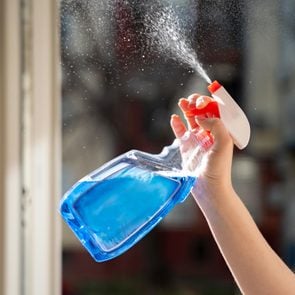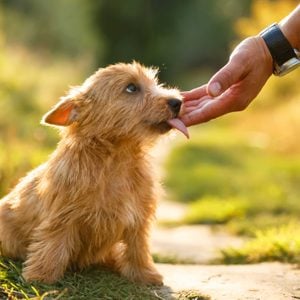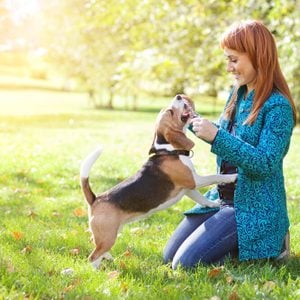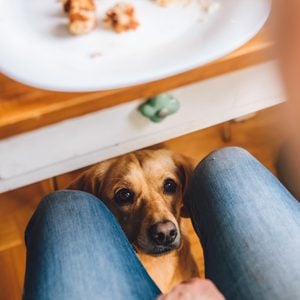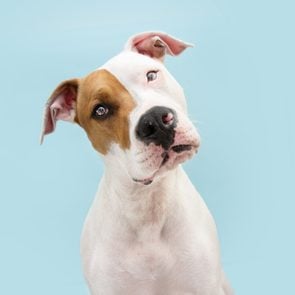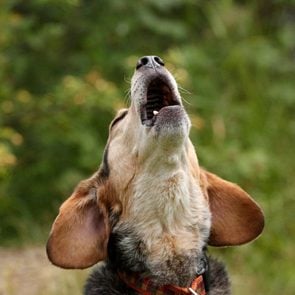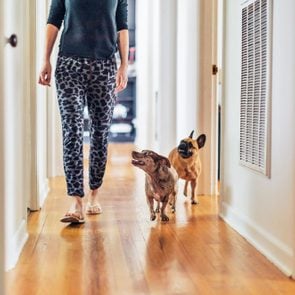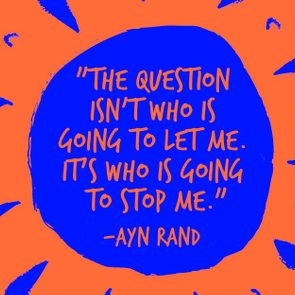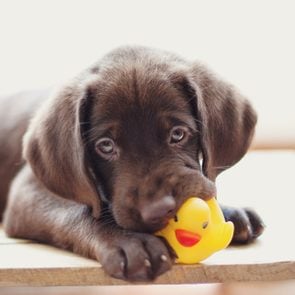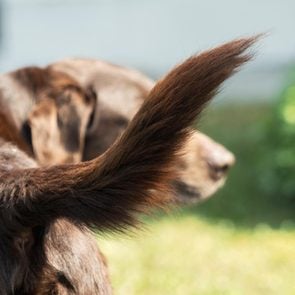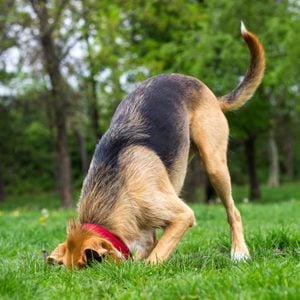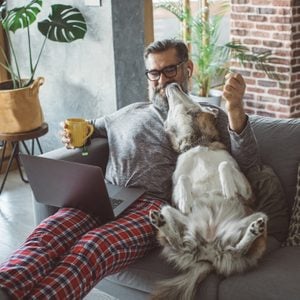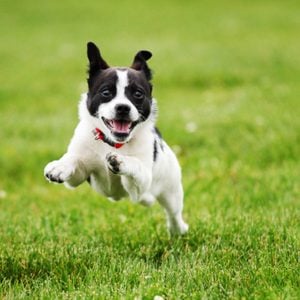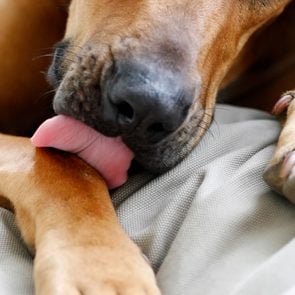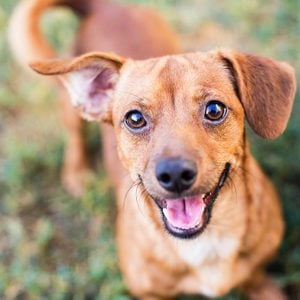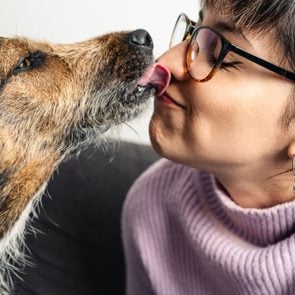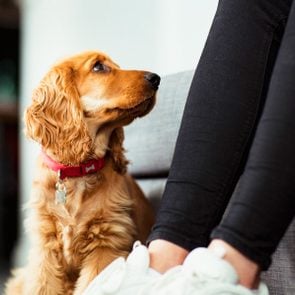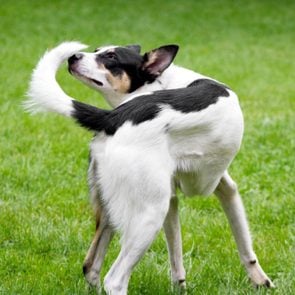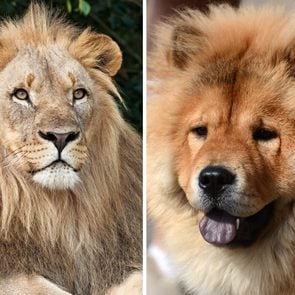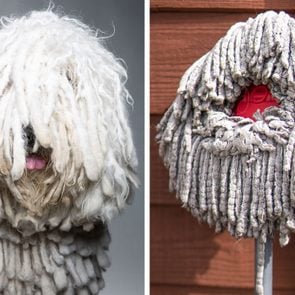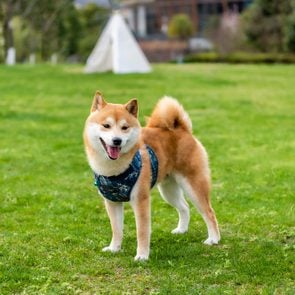Start your morning with a cuppa jokes (and some funny coffee quotes). Drink up these coffee puns based on your flavor-ite songs, bands, movies, TV shows, and books. Cool story, brew! If you like your roast strong, hit the (coffee) grounds running, with these nutty, rich, and stimulating puns! They’re perk-fection for procaffeinating during the daily grind. Stay frappé! (P.S.—save these hilarious wine puns to browse through during happy hour.)
“Pour some sugar on me” with these choc’ n’ roll coffee puns set to music!
“I love brew. I honestly love brew.”
Remember Olivia Brew-ton John’s mega pop hit from the seventies? Her vocal sweetness captures how we all feel about coffee.
“Excuse me while I kiss the chai.”
Imagine if Jimi Hendrix’s legendary rock song “Purple Haze” was really an ode to a chai tea latte? All any of us need is a little caffeine to clear the haze.
“Thank you for bean a friend!”
Of course, The Golden Girls theme song is a celebration of friendship, just like the show itself. Coffee is also your BFF. (Brewed Full-bodied Forever!) Check out these un-beetable vegetable puns for more laughs.
“Wake me up before you cocoa!”
Wham’s totally addictive ’80s pop hit perfectly captures our need for a hot beverage in the morning!
“My coffee amour, milky little cup that I adore.”
Stevie Wonder’s beautiful soul song gets it exactly right when it comes to your love affair with coffee. Why do we love it so much? Check out the things that happen to your body when you drink coffee every day.
Here are your TV show coffee puns—just add streaming and sugar

The X-Filters
This sci-fi classic follows Scully and Mulder as they hunt for the perfect cappuccino and UFOs—Unidentified Fair-trade Organic coffees.
Pretty Little Lattes
A coffee klatch of teen girls face the mystery of a lost barista in this bold drama that’s fresh and flavorful.
Twin Perks
Tensions percolate in this regional tale about dark roasts that move at a slow drip. Will give you the jitters!
Coffee, the Vampire Slayer
Trouble brews when creatures of the dark try to switch to decaf. So, a robust, young woman, “Cuffy,” fulfills her destiny and gets in hot water as she tracks caf-fiends.
Friday Night Lattes
It’s full steam ahead in this show about a beverage joe and his football bean. It may be a small-town Texas bean, but it boasts the greatest joe on earth. The teenaged beans grind it out with a full cold press in this earthy drama. A true brew-mance! Check out the best coffee shop in Texas, and all the 50 states.

Pour-over these addictive novels about coffee—with puns! Hold my brew!
For Whom the Bean Tolls
It tolls for beans! Ernest Hemingway’s classic novel about the nature and experience of Spanish coffee got its title from John Donne’s famous poem about beankind. Because no bean is an island.
David Coffeefield
The famous first line of Charles Dickens’ epic novel states, “Whether coffee shall turn out to be the hero of my own life, or whether that station will be held by tea, these pages must show.” If you enjoy Dickens, next try Great Percolations, Bleak Coffee House, and A Tale of Two Chicories.
The Count of Macchiato
This strong, saucy tale by Alexandre Dumas follows a man who is wrongly given decaf coffee—for years—and justifiably, must seek revenge.
The Lord of the Beans
J.R.R. Tolkien’s epic fantasy about the coffee bean industry of middle earth brims with rich nuttiness.
The Brothers Caramel Mocha
You may find Fyodor Dostoevsky’s bitter, aromatic novel far less sweet than its title suggests. Did you know that people who like to drink their coffee black may be psychotic?
What’s the best band of coffee? Give it your best shot with these coffee pun band names

The Smashing Pumpkin Spice Lattes
Their ’90s album “Mellon Collie and the Infinite Sadness” may make you a little despresso.
Rage Against the Espresso Machine
These rock purists feature blends of punk, thrash, metal, and hip-hop in their grinds.
The Red Hot Coffee Peppers
Caffeine-infused vibes and intense percolations make for a robust band of Americano brews.
AC/Decaf
Their vigorous album, “For Those About to Rock, We Salute Brew,” uses hard beans with dark, metallic undertones.
Fleetwood Macchiato
Their pop hit, “Don’t Stop Thinking About Your Coffee,” will really perk you up.
More of a tea person? You’ll love these hilarious tea puns!
Coffee puns at the box office—for some good clean pun! It’s a wonderful latte!
There’s Something about Mocha
It’s the adventure of a bunch of brews obsessed with a brew-tiful blonde.
That Thing You Brew!
This feel-good romp features a perky hit song that you’ll like a latte.
Back to the Frother
When it comes to froth, you need perfect timing. Better latte than never.
The Polar Espresso
Kids escape late at night to visit Sanka, and shouldn’t they be grounded?
He’s Just Not That Into Brew
There are a few frappé cup-ples by the end of this brew-mance that features mugs and kisses. Are you the type to annoy your barista? Check out the 10 rude coffee shop habits you can stop doing a latte.
House-training a puppy, taking in an unruly stray or caring for an older dog requires love, patience and a lot of cleaning. Accidents (of the pee variety) will happen, and if you have carpeting, you’ll be cursing the day you decided against plank flooring. The bottom line: You need to know how to get dog pee out of carpet. The good news is that dogs and carpets have been coexisting for years, and cleaning experts have loads of tips to help.
The bad news? “The smell of urine and feces is reinforcing for dogs,” according to veterinarian and pet behaviorist Amanda E. Florsheim, DVM, owner of Veterinary Behavior Solutions in Carrollton, Texas. That means once a dog picks a spot and goes there, it’s likely to go there again if you don’t take the proper measures. Cleaning the pee spot all the way down to the floor is the first step, but you’ll also need to adjust your dog’s behavior.
Reader’s Digest spoke with three carpet cleaning experts and Dr. Florsheim to help you fix this urgent, and potentially recurrent, problem. Yes, sometimes old or large pee stains are tough to remove, and you may have to hire a pro or even replace the carpet. But let’s cross that bridge when we get there—hopefully, never. Ahead, you’ll learn the right way to get dog pee (and pee smell) out of your carpet and other soft surfaces like upholstery and dog bedding.
Get Reader’s Digest’s Read Up newsletter for more cleaning, pets, humor, travel, tech and fun facts all week long.
|
On This Page About the experts
Reviewed for accuracy by: Ann Russell, TikTok’s “cleaning auntie” and the author of How to Clean Everything. |
What to do before you start stain removal
- Remove your dog from the area. Don’t scold your dog or “rub his nose in it,” says Dr. Florsheim. Dogs will not put two and two together about the pee and why you’re mad. Just lead your dog into another room or outside while you get to work.
- Jump on stains immediately. While it is possible to remove dried dog pee from carpet, “fresh urine is easier to remove, by far,” says Jeff Cross, a cleaning expert from ISSA, a trade group for cleaning professionals. (FYI, the same is true when trying to remove dog poop from carpet.)
- Know your carpeting. Is it silk, wool, synthetic? It’s important to find out, because some cleaners aren’t suitable for certain fibers. Once you know, check the label of your cleaner. The “label is the law” when it comes to cleaning products, according to professional janitor Brandon Pleshek. “Make sure to read it, and use as directed.”
- Test for colorfastness. Your carpet’s already covered in pee—don’t wreck it further by spraying an untested chemical all over it. First, test the cleaning solution on an inconspicuous area. This is especially important if you don’t know what kind of carpeting you have.
- Soak up the pee. No matter what cleaning method you use, you need to get up as much of the urine as possible, Pleshek says. So stock up on plain white paper towels, which will get the job done and prevent color transfer.
How to get dog pee out of carpet with enzymatic cleaner
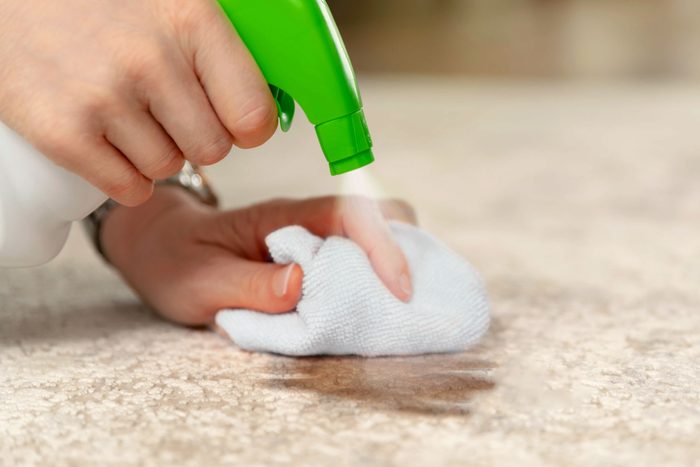
Every expert we consulted praised enzymatic cleaners, since they work by “digesting” the pee on your carpet. “But you need to follow the directions exactly,” says Cross. Some require diluting, while others should be used at full strength. Certain formulations can be used in a carpet-cleaning machine; others are made just for spraying. You’ll also need to give them ample time to work.
Supplies you’ll need
- Enzymatic carpet cleaner
- Plain white paper towels, or towels
- Vacuum cleaner
Directions
- Read the label, since instructions may vary slightly from brand to brand.
- Using an absorbent towel or lots of paper towels, soak up as much pee as possible.
- Dilute the enzymatic cleaner as directed on the package, or apply it at full strength if indicated.
- Saturate the pee spot. Make sure the solution reaches all the way to the base of the carpet.
- Allow the cleaner to sit for the recommended amount of time, usually about 10 to 15 minutes (to start).
- Blot the spot with a towel to remove excess liquid.
- Allow the spot to dry for 24 hours. The enzymes will keep working as long as there’s pee to digest. Keep pets away during this time.
- Once the time is up, vacuum to remove cleaner residue.
- If you still see a stain or smell an odor, re-saturate the spot with the enzymatic cleaner. Lift up the carpeting to saturate the pad or floor for best results.
- Allow to dry completely, usually for 24 hours. Many enzyme cleaners do not require rinsing, but double-check to make sure.
How to get dog pee out of carpet with dish soap and vinegar
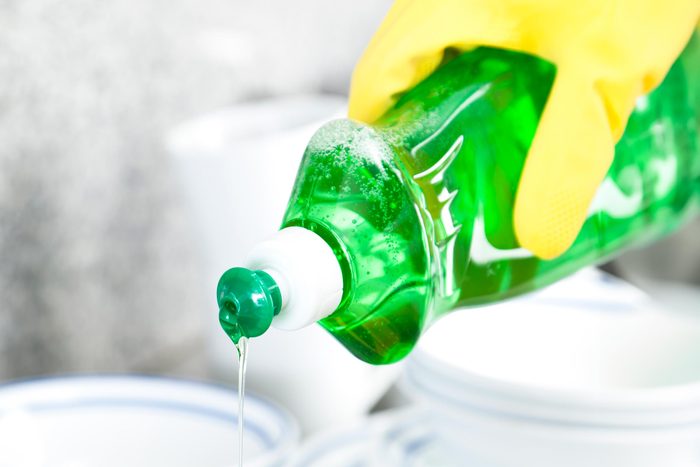
Out of enzymatic cleaner? Cleaning expert Karen Cady of the Carpet and Rug Institute (CRI) Seal of Approval program says that simple homemade cleaners, like a solution of vinegar and liquid dish soap, can also get dog pee out of carpet. Vinegar works because it can break down uric acid, which is what makes d0g pee smell, and also neutralize bacteria. Like enzymatic cleaner, this method works best on fresh pee.
Before we dive into the directions, a few important notes: Don’t use dish soap that contains bleach or lanolin, Cady says. Bleach could discolor the carpet, and lanolin could make the stain worse. And only use liquid dish soap, never dishwasher detergent or laundry detergent. For more CRI-certified cleaners, check out the CRI database, or look for the CRI seal of approval on the package.
Supplies you’ll need
- Dish soap
- Plain white paper towels
- Small bowl
- White vinegar
Directions
- Remove as much pee as you can by blotting the area with plain white paper towels.
- Mix a solution of 1/4 teaspoon dish soap and 1 cup lukewarm water. Work up some suds.
- Dunk a clean paper towel into the solution, and repeatedly blot the stain. Use a fresh spot of the towel each time to avoid transferring pee back to the carpet.
- Wet fresh paper towels with lukewarm water. Blot the area repeatedly to rinse it. Move to a new spot of the paper towel each time, until the area is no longer soapy.
- Reapply the dish-soap solution. Continue rinsing and blotting with the solution and water as long as you see the stain getting better, or there’s no more pee transferred to the towel, Cady says.
- Next, mix a solution of 1 cup white vinegar and 2 cups water. Saturate clean paper towels with the vinegar-and-water solution, and dab it onto the stain. Make sure the solution reaches all the fibers. (Don’t rinse.)
- With a fresh paper towel, blot the area dry. Then “apply a half-inch layer of paper towels to the affected area, and weigh down with a flat, heavy, non-fading object,” Cady says.
- Change the paper towels frequently until the area is completely dry—possibly 24 hours or more.
How to get dried dog pee out of carpet
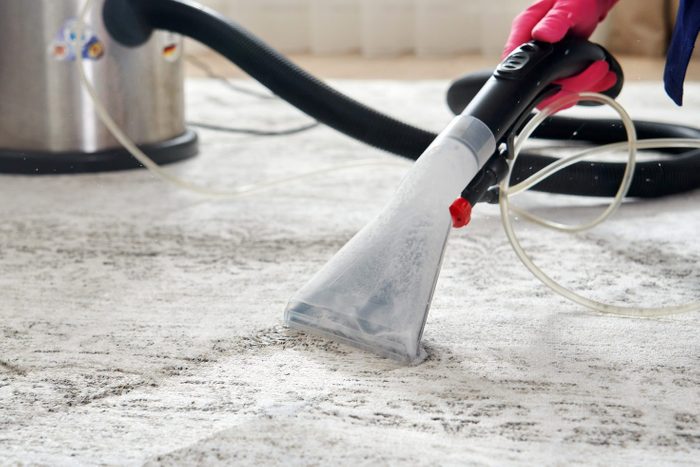
Dried pee can be very challenging to remove. Your dog is likely to smell and revisit the pee spot, and it doesn’t smell so great for you either. Urine is mostly water, but it’s the other stuff, particularly uric acid, that binds to the fibers (and smells) as the pee dries. “Unless an area is cleaned with a good enzymatic cleaner, dogs can still smell the small remnants that regular cleaning can leave behind,” Dr. Florsheim says. That’s why Pleshek recommends an enzymatic cleaner, combined with a carpet-cleaning machine or attachment that fits on a wet-dry vacuum, and he walks us through the steps below.
Supplies you’ll need
- Enzymatic pet stain cleaner concentrate for carpet machines
- Carpet-cleaning machine, or wet-dry vacuum attachment
Directions
- Dilute the cleaner 50-50 with water, or as indicated on your carpet-cleaning concentrate.
- Saturate the stain completely, all the way to the base of the carpet.
- Let it sit for 35 minutes to an hour. “The key here is to let the enzymes work,” Pleshek says.
- Suck the cleaner out of the carpet with the machine or attachment. (Pleshek recommends the SOS Sub Surface Carpet Extraction Tool.)
- Rinse, if indicated on the cleaner. Dump out the dirty extracted water, and fill the machine with fresh water. Make passes over the area until the machine no longer extracts any dirty cleaning solution.
- Dry the carpet completely, which could take 24 hours or more. Use fans to speed things along.
| ♦ Pro tip |
| If you don’t have a carpet-cleaning machine or proper attachment, follow the enzymatic-cleaner directions for fresh pee, and make sure the cleaner reaches all the way to the pad. If pee remains behind, your dog will smell it, and you may need to keep him out of the area to prevent him from peeing there again. |
How to get dog pee out of upholstery

Cross says to clean upholstery the same way you clean carpeting, but use more care so you don’t damage the thinner fabric on couches and chairs. The first rule is to check your furniture’s care label. Some fabrics and fill material must be dry-cleaned, while others can tolerate carpet shampoos and water. If your furniture has a removable cover or slipcover, take it off and clean it as indicated on the label. You may be able to toss it in the wash, although a gentle cycle is probably in order.
If you don’t have a washable slipcover, follow the steps below, but remember that your specific label should always reign. Furniture is expensive, so always test a small area in an inconspicuous spot before proceeding, especially if you’re not sure.
Supplies you’ll need
- Enzymatic cleaner, carpet shampoo, dish soap or vinegar
- Plain white towels or paper towels
- Small bowl
Directions
- Blot the stain with paper towels or towels to absorb as much liquid as possible. If you get to it quickly, it may not soak into the cushion.
- Remove the cushion cover or slipcover if you can. This will make it easier to assess how far the pee has penetrated, as well as let you wash and dry the cover separately, whether by hand or in the washing machine.
- If pee has penetrated the foam, spray the spot with enzymatic cleaner, fully saturating it. Follow the instructions on the cleaner.
- If you can’t remove and/or wash the cover in the machine, and it doesn’t say “dry clean only,” apply enzyme cleaner to the cover and cushion. Allow it to work for the recommended amount of time, generally 10 to 15 minutes to start.
- Blot to remove excess cleaner, and allow it to dry for 24 hours. If necessary, repeat the application. Do not rinse unless the cleaner says to do so.
- Alternatively, mix 1/4 teaspoon dish soap and 1 cup warm water; 1 cup vinegar to 2 cups water; or a spot cleaner that’s approved for upholstery.
- Apply, blot and rinse the spot and cushion until you no longer see or smell pee on the towels or cushion. Use a fresh section of the towel each time to avoid transferring pee back to the upholstery. Make a new solution if it gets dirty.
- Do a final rinse by blotting with fresh water and paper towels.
- Dry the cover and furniture thoroughly before replacing the cover or using the couch or chair.
How to get dog pee out of dog beds
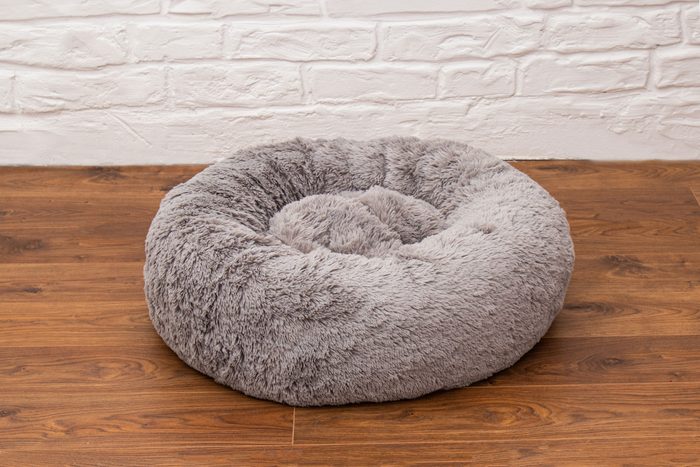
Your dog’s bed probably smells pretty bad on a good day, but the addition of pee? No thanks. Hopefully, the bed has a removable cover. (If not, someone really should have a word with that dog-bed manufacturer.) Sop up any pooled pee, carefully take off the cover and launder it. Air out the bed while the cover gets clean. If pee soaked into the foam or fill, here’s what to do.
Supplies you’ll need
- Mild laundry detergent
- Bathtub or large sink
Directions
- Read the care label on the bed. You may be able to wash the entire bed in the washing machine.
- If not, fill your bathtub about a third of the way with cool water. Add a small amount of mild, pet-safe laundry detergent, and swirl it around.
- Submerge the entire dog bed in the water, and squeeze to get the soap into the foam.
- Soak for 15 minutes, then squeeze and agitate to clean the pee from the cushion.
- Rinse well by draining and refilling the bathtub until no soapy residue remains. Squeeze out as much excess water as you can.
- Air-dry outside, if possible. Alternatively, your dog bed might be able to go in the dryer on low; check the label, and if so, toss in some tennis balls or dryer balls to fluff it. Another option is to use a drying rack or hang it indoors in a well-ventilated area until completely dry.
How to get a dog to stop peeing in the house
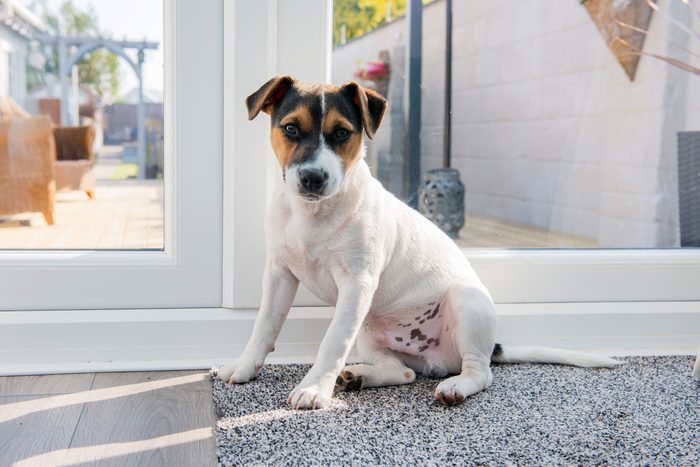
Cleaning up after your dog is a labor of love, but let’s be real: You need your dog to stop peeing in the house. That’s easier said than done, of course, but getting all the pee out of the carpet and upholstery will help. Remember, dogs aren’t trying to pee in the wrong place—they actually think it’s the right place to go! If you want to spend less time cleaning up after your dog, you need to figure out the root of the problem. If the peeing is new, says Dr. Florsheim, take your dog to the vet “to help rule out problems like bladder infections, stones and pain.”
If everything checks out medically, here are some strategies that can help eliminate accidents.
- House-train your dog. Every time your dog goes to the bathroom in the house, it is self-reinforcing. They have pressure from their bladder or colon, they go, and then they feel better. That’s a powerful reward, Dr. Florsheim says. That’s why she doesn’t advise using pee pads, unless you always plan to have them available (for their entire life).
- Use positive reinforcement. Just like peeing feels good to your dog, so does your praise. Never yell at or strike your dog. “Instead, if you catch them in the act, interrupt them as neutrally as you can and redirect them outside,” Dr. Florsheim says. If you find the pee even a second after your dog is done, it’s too late. Just clean it up and work on house-training.
- Go outside with your dog. “The best way to encourage a dog to go where you want them to is to go with them,” according to Dr. Florsheim. When your pup pees outside, give plenty of praise and a high-value treat. Reward “right as you dog finishes going, not when they come back in the house,” Dr. Florsheim says, or they’ll associate the reward with coming inside and may not even go!
- Reduce anxiety. Marking, or peeing on things deliberately, can be a sign of stress due to other dogs in the home, or even people your dog is wary of. Does it happen at certain times of day? Is it the weather? Try to narrow down the triggers, and talk to your vet about ways to reduce your dog’s anxiety.
- Be patient. Dogs newly introduced to your home may have trouble adjusting to the feel of new grass or turf, or strange noises. And puppies and dogs from mills or other abusive conditions may have never seen or felt grass at all, Dr. Florsheim says. They don’t know the yard is for peeing until you show them and reinforce the good behavior.
FAQs
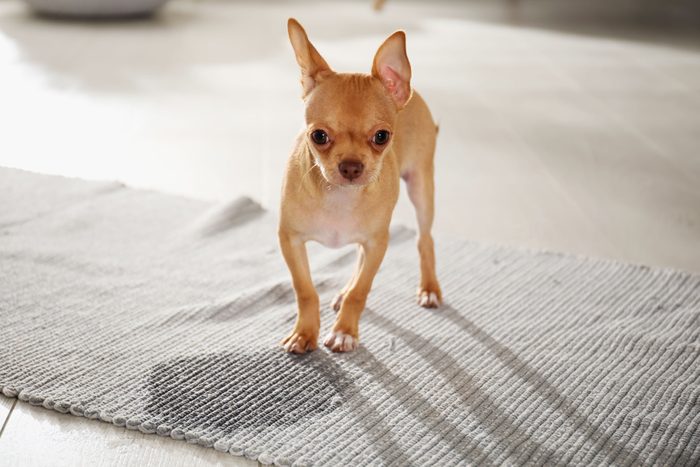
What kills the smell of dog urine in carpet?
Enzymatic cleaners (also called enzyme cleaners). While you can buy any number of products that promise to get rid of odor, they often just mask it. Then, “in times of high humidity, the odor may reappear,” Cady says. Enzymes actually digest the molecules that make up the stain and smell, allowing their byproducts to evaporate. By using an enzyme cleaner correctly, you’re really getting rid of every last drop of pee. No more smells, for you or your dog.
Why does my carpet still smell like pee after cleaning?
Quite simply, because there’s still pee in it. If you don’t get every last bit of pee out out of your carpet, it changes over time and gives off really toxic-smelling odors. Cross says it’s chemistry. “Over time, urine changes from an acid to an alkaline, and that’s why you get the ammonia smell,” he explains. “This is really tough to remove.” If you haven’t tried an enzyme cleaner, do. If it still smells like pee, repeat, lifting up the carpet to get underneath. If that fails, call a pro.
Will vinegar stop a dog peeing in the same spot?
Maybe, maybe not. Vinegar is a great cleaner and it does neutralize the pee odor, but dogs have incredible senses of smell. To really destroy the reason they are coming back to the same spot, use an enzyme cleaner, which leaves nothing behind if used correctly.
Does dog pee destroy carpet?
It can. If you clean fresh pee right away and dry your carpet completely, it will likely be fine. But repeated peeing that’s allowed to sit and soak? That’s definitely going to wreck your carpet. Dog pee reacts with the dyes in the carpet, and prolonged moisture can cause delamination, where the carpet fibers separate from the backing, according to the CRI. Then there’s the smell. Clean up pee immediately for the best chance of success.
If you’ve tried these methods to remove pee and your carpet still stinks, or it’s discolored, bleached or fraying, call a professional. If the problem is confined to one area, they may be able to patch the carpet. Otherwise, you might need to buy a new one.
Why trust us
At Reader’s Digest, we’re committed to producing high-quality content by writers with expertise and experience in their field in consultation with relevant, qualified experts. For this piece on how to get dog pee out of carpet, Ally Childress tapped her experience as a home and cleaning journalist, and then Ann Russell, TikTok’s “cleaning auntie” and the author of How to Clean Everything, gave it a rigorous review to ensure that all information is accurate and offers the best possible advice to readers. We relied on reputable primary sources, including carpet-cleaning experts and a veterinary behaviorist, verified all facts and data and backed them with credible sourcing, and we will revisit them over time to ensure they remain accurate and up to date. Read more about our team, our contributors and our editorial policies.
Sources:
- Karen Cady, program manager, CRI Seal of Approval program; email interview, Feb. 5, 2024
- Jeff Cross, media director at ISSA; email interview, Feb. 1, 2024
- Amanda E. Florsheim, DVM, veterinarian and owner of Veterinary Behavior Solutions; email interview, Feb. 6, 2024
- Brandon Pleshek, janitor and cleaning expert at Clean That Up; phone interview, 2022
- CRI Technical Bulletin: “Pet Urine and Carpet”
If you own a dog, you’ve no doubt been there: You’re eating lunch, and your dog’s eyes are following your movements. You’re brushing your teeth, and your dog is looking up at you. You’re watching TV, and your dog is watching you. You wouldn’t be alone in wondering, Why does my dog stare at me?
Dogs have been at our side for more than 10,000 years, becoming master observers of human behavior. Although being stared at by our pets can be uncomfortable, this behavior serves many practical—and usually harmless—purposes for our four-legged companions.
As a veterinarian, I am well versed in dog behavior and have extensive knowledge about why dogs do what they do. So let’s explore the reasons your dog may be staring at you and how this staring behavior is good for you both.
Get Reader’s Digest’s Read Up newsletter for more cleaning, humor, travel, tech and fun facts all week long.
| Reviewed for accuracy by: Wailani Sung, DVM, a vet with a board certification in veterinary behavioral medicine who owns Bay Area Vet Behavior. Dr. Sung is the co-author of From Fearful to Free: A Positive Program to Free Your Dog from Anxiety, Fears and Phobias. |
Why does my dog stare at me?
Dogs can’t talk (although we sometimes wish they could), so they rely on their body language and facial expressions to communicate with us. When our dogs stare at us, they use their eyes to tell us something. It’s up to us to figure out what that something is and respond accordingly.
It’s getting to know you better
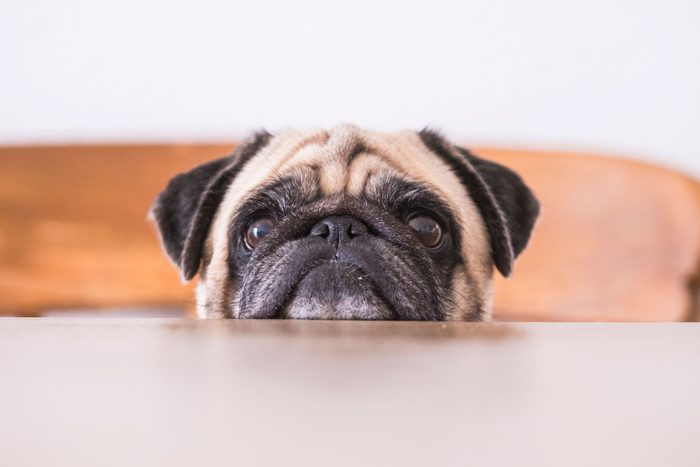
Over the thousands of years that dogs have been in our lives, they have not tired of observing us. When your dog stares at you, it’s trying to understand various things about you, like your habits, body language, facial expressions and tone of voice.
Your dog will also stare at you to gauge how you’re feeling. If you’re moping around the house, your dog will likely be able to pick up on that negative energy and possibly try to comfort you.
It’s telling you what it needs
Wouldn’t it be nice if our dogs could say, “I need to go to the bathroom” or “I’m hungry”? Since they can’t, they use their eyes to communicate these needs to us. For example, if your dog needs to pee, it might stand by the door and look at you to signal that it needs to go outside.
If your dog stares at you and licks its lips while you’re eating, it’s probably begging for food. Be careful with this type of stare, because giving your dog a tasty morsel of food will only reinforce the begging. Instead, encourage your pup to busy itself with another activity, such as a food puzzle toy, while you eat.
It’s expressing emotion
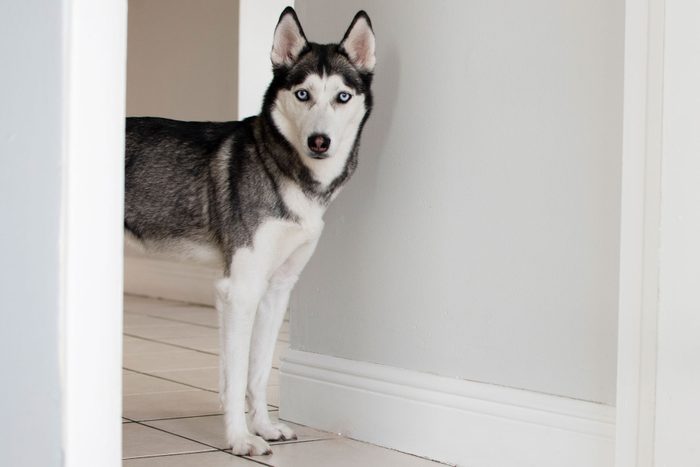
Love is one of the most powerful emotions our dogs can express to us through their eyes. A pup’s loving stare—the kind with slightly squinted eyes—will stimulate in its owner the release of oxytocin, the so-called love hormone. According to a study published in the journal Science, oxytocin strengthens the affectionate bond between you and your dog.
Dogs also stare to communicate aggression. An aggressive stare, accompanied by a stiff posture and unblinking eyes, tells you to back off. This type of stare, which you should not return, is often associated with resource guarding (for example, guarding dog toys) and signals a need for behavioral modification.
It wants attention
Quality time with our dogs is the highlight of our day—and theirs. If your dog is staring at you expectantly with a toy in its mouth, it’s urging you to give it attention and play with it.
If your dog shares your bed, it may stare at you to express a desire for some cuddle time before dozing off into dreamland.
It’s confused
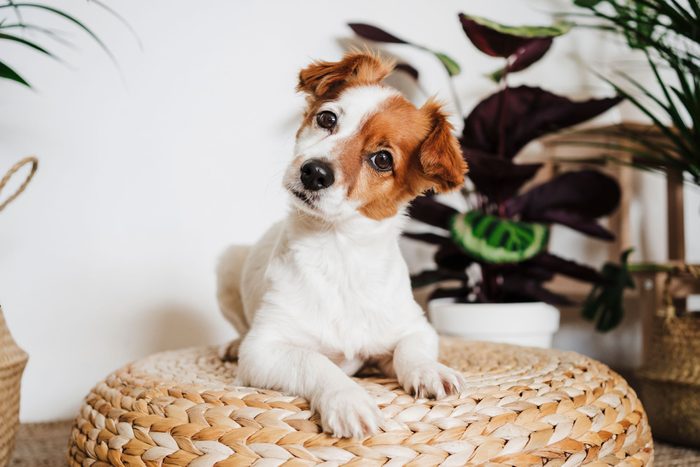
Quite literally, our dogs look to us for instruction. If your dog does not understand your command or is in an unfamiliar situation, it will stare at you for clarity on what to do.
Let’s say that you’re walking your dog and come to a crosswalk. Your dog might stare up at you, waiting for you to tell it when it’s safe to cross the street.
It’s pooping
Dogs have some odd bathroom habits. (Spinning before pooping, anyone?) You may have also noticed your dog staring at you when it poops, and there’s a reason for that. Squatting to poop puts your dog in a vulnerable position, so it’ll stare at you for reassurance that you will protect it while it’s doing its business. Be a good protector by scanning the area for potential dangers, such as another dog.
It’s sick or injured
Dogs depend on us to take good care of them. If your dog is injured or not feeling well, staring at you is its way of telling you that something is wrong and it needs your help. If your dog is acting out of the ordinary—say, being less active or acting extra clingy—it may be time for a trip to the vet.
It’s experiencing separation anxiety
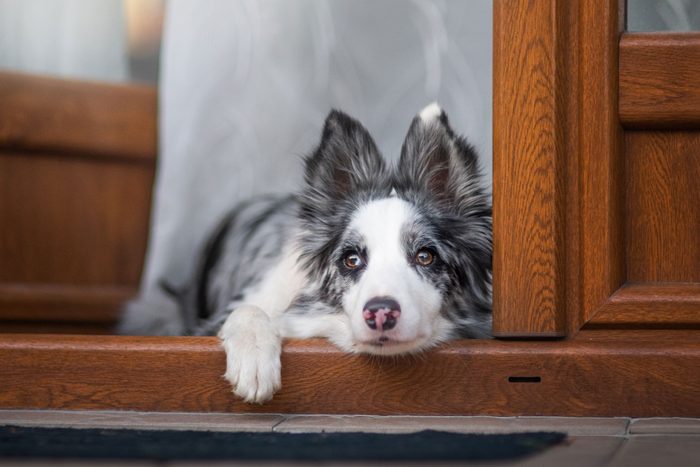
If your dog follows you everywhere and staring at you to ask for attention, it may be experiencing separation anxiety. Left unchecked, this can lead to destructive behavior and can negatively affect your dog’s physical health, causing issues such as vomiting and diarrhea.
If you suspect your dog has separation anxiety, talk to your veterinarian, who can refer you to a veterinary behaviorist. Severe cases of separation anxiety may require anti-anxiety medication in addition to behavioral modification.
Its brain function is declining
Older dogs can experience cognitive dysfunction, which is like human dementia. Signs of the disorder include confusion, anxiety, sleep disturbances and less interaction with owners, according to a study published in the journal Veterinary Clinics of North America, Small Animal Practice. Another red flag? Staring into space or at you.
If you have an older dog that is staring at you but doesn’t seem quite “there,” schedule a visit with your veterinarian for further examination.
Why it’s OK to make eye contact with your dog
“Why does my dog stare at me?” isn’t the only question you should be asking. Just as important is this: Why does human-canine eye contact matter?
Making eye contact with your dog helps you communicate with each other. Being able to interpret your dog’s stares will help you better understand what it needs and wants from you. Take, for instance, the process of training your dog. This is an ideal time for eye contact—your dog’s stare will indicate a need for instruction and reassurance as it learns new skills.
And let’s not forget the loving gaze! It helps strengthen the bond you share with your dog. As the researchers reported in the Science article, the oxytocin response between humans and dogs is a loop: When dogs stare at us, our level of the love hormone increases, which increases dogs’ oxytocin in turn.
Why trust us
At Reader’s Digest, we’re committed to producing high-quality content by writers with expertise and experience in their field in consultation with relevant, qualified experts. For this piece, JoAnna Pendergrass, DVM, tapped her experience as a veterinarian and journalist covering pets, and then Wailani Sung, MS, PhD, DVM, DACVB, a board-certified veterinary behaviorist who owns Bay Area Vet Behavior, gave it a rigorous review to ensure that all information is accurate and offers the best possible advice to readers. For this piece, we relied on reputable primary sources, including professional organizations and academic institutions, as well as our writer’s personal experience. We verified all facts and data and backed them with credible sourcing, and we will revisit them over time to ensure they remain accurate and up to date. Read more about our team, our contributors and our editorial policies.
Sources:
- Zoological Research: “Deciphering the puzzles of dog domestication”
- Science: “Oxytocin-gaze positive loop and the coevolution of human-dog bonds”
- Veterinary Clinics of North America, Small Animal Practice: “Canine Cognitive Dysfunction: Pathophysiology, Diagnosis, and Treatment”
- Journal of the American Veterinary Medical Association: “Review of epidemiological, pathological, genetic, and epigenetic factors that may contribute to the development of separation anxiety in dogs”
Dogs love to stick close to us, following us everywhere and getting comfortable on our laps while cuddling on the couch. It’s also not unheard of for our furry friends to lean against us when we’re near, though this behavior is a little trickier to interpret. In over 13 years as a certified professional dog trainer, I’ve had plenty of dogs lean against me or sit on my feet. And just as many clients have asked, “Why does my dog lean on me?”
If you find yourself confused by dog behaviors like this, you aren’t alone. It can be tricky to understand our four-legged friends because they have their own canine culture and language. When your dog howls, paws at you or showers you with slobbery kisses, it’s trying to tell you something. The same is true when your dog leans on you.
So what should a good pet parent know about this behavior? To get the best possible advice, I turned to a trio of experts—certified canine behaviorists and dog trainers—who are well-versed in the topic. Read on to learn why your dog leans on you and to dig deeper into when this common dog behavior signals a problem.
Get Reader’s Digest’s Read Up newsletter for more pet insights, humor, travel, tech and fun facts all week long.
About the experts
Reviewed for accuracy by: Wailani Sung, DVM, a vet with a board certification in veterinary behavioral medicine who owns Bay Area Vet Behavior. Dr. Sung is the co-author of From Fearful to Fear Free: A Positive Program to Free Your Dog from Anxiety, Fears and Phobias. |
Why does my dog lean on me?
One trick for understanding how dogs use touch to communicate is to consider the human equivalent. “The common element between most instances of dogs making physical contact with us is because it feels safe,” says certified behavior consultant and dog trainer Devan Amundsen, CBCC-KA, CPDT-KA. “I think I’d describe it like holding hands with someone. Sometimes it’s because you’re nervous, other times because you’re content and other times because there’s a lot going on and I want to watch [where I’m walking] without losing track of you.”
With the help of the experts, we’ll explore the most common answers to the question “Why does my dog lean on me?”
It’s showing affection
Our pets don’t have opposable thumbs to hold our hands or give our arm a squeeze. So how do dogs show us they love us? According to Sagi Denenberg, DVM, a veterinary behaviorist at North Toronto Veterinary Behaviour Specialty Clinic, dogs use leaning as an affiliative behavior. It’s a way to forge social and emotional bonds. “Dogs don’t hug, kiss or pet,” he says. “These are human ways of showing affection. Dogs lean or huddle.”
Certified behavior consultant and dog trainer Valerie Balwanz, CBCC-KA, CPDT-KA, points out that dogs express comfort and affection with other dogs through touch. And they use that love language on us as well. “Dogs that like each other will hang out near each other, and sometimes that includes pressing up on each other while sitting or sleeping. Because dogs include humans in their social circle, they extend these behaviors of proximity and contact to us too.”
It’s anxious
Dr. Denenberg believes the other major reason dogs lean on people is because they’re anxious. If an anxious dog can keep tabs on its human, it feels reassured, and what better way to do that than with physical contact? “An anxious dog will lean on its attachment figure [when possible] for comfort and mostly to know where the person is while keeping their eyes on someone else or sleeping,” he says. “This way, the dog knows exactly where you are even without looking and knows you cannot disappear [e.g., leave the house] without them knowing.”
Balwanz points out that steady pressure is comforting for some dogs, which may relate to their leaning behavior. For example, snug-fitting shirts can ease canine anxiety, as can certain types of massage. “Leaning on a favorite person provides pressure, which is comforting,” Balwanz says. “If your dog is following you around the house and seeking excessive contact, it’s possible that this indicates anxiety.”
Think your dog is leaning on you because it’s anxious? It’s important to build its self-confidence so it feels more at ease in the world.
It wants something
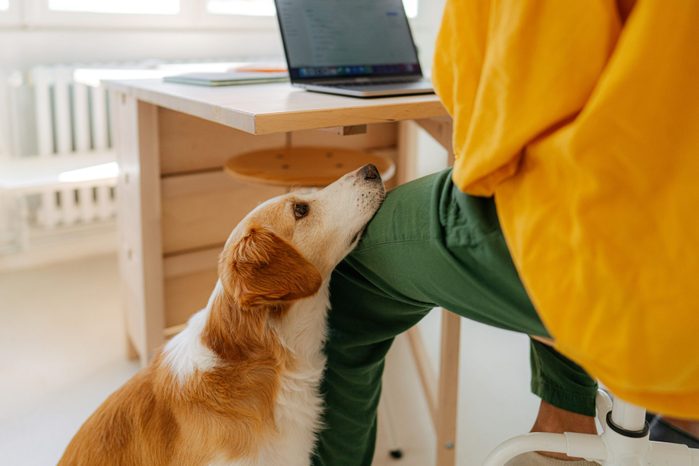
Your dog might also lean on you because it has learned that you pay attention to it when it does this. After all, it’s hard to ignore the contact, especially from the largest dog breeds. Balwanz explains that dogs do whatever helps them get what they want. “If a dog has learned that leaning on you makes you pet them or give belly rubs, then leaning is a behavior they will repeat in the future,” she says.
Amundsen doesn’t blame dogs for resorting to obvious signals like leaning to express themselves. “Humans are notoriously awful at reading dog communication. We miss so much of what our dogs are telling us,” he says. “As a result, I think dogs quickly learn what behaviors humans won’t miss and will get the dog what they want. Leaning is one of those behaviors. It’s usually pretty clear communication from the dog that they’d like a little bit of physical contact right now.”
To reduce this type of leaning, Amundsen suggests teaching your dog a different way to ask for physical attention. But he advises teaching your dog how to ask for that attention to stop as well. “I’d love for more people to talk about offering consent in dog interactions,” he says. “Our dogs aren’t here for us to do whatever we want to them. We’ve evolved side by side for thousands of years to be collaborative partners.” While you’re at it, find out why does your dog has whiskers. It turns out that they play a crucial role in the way dogs approach the world around them.
Is my dog leaning on me to establish dominance?
Although dog leaning can, at times, indicate a problem with your dog, it’s not about dominance. Dr. Denenberg explains that dogs’ relationships with humans are about attachment, not hierarchy—just like kids and their parents. If you think about it, pet dogs are our dependents. They can’t get anything in life, including food, toys, affection or exercise, unless we give it to them.
On top of that, dogs don’t show dominance that way. “When dogs lean against people, they often show very relaxed or vulnerable body posture and language, not confident and aroused like two dogs or wolves in conflict for status,” Dr. Denenberg says. “A dog vying for high status stands over [another animal], tenses its body and gives many signals. They don’t lean against the other dog, close their eyes or look elsewhere.”
A study in the journal PLOS ONE that examined the behavioral measures of dominance in dogs explained that what the researchers called “high posture” (head up, tail up, pricked ears, and straight back and legs) was the best status indicator for dominance during dog-to-dog interactions. That’s a far cry from your dog comfortably leaning against you.
Another study, published in the journal Animal Behaviour, examined how the social relationship between dogs impacts their stress levels. To measure that relationship, the scientists looked at canine behavior. They labeled one of the affiliative behaviors “body contact”—something they defined as “staying [for at least 10 seconds] with at least a part of the body in contact with the other subject, in a relaxed position.” Sounds a lot like leaning to me.
How do I know if my dog’s leaning is a problem?
Equally as important as asking “Why does my dog lean on me?” is questioning when your dog’s leaning behavior is a cause for concern. Balwanz says leaning on you could be a sign your dog is experiencing a medical condition involving its balance. “If you feel your dog is unsteady on their feet and leaning on you for support, it’s best to consult your vet,” she says.
That said, anxiety is the most likely cause for problem leaning. But how do you know if that’s why your dog leans on you? Amundsen cautions against jumping to conclusions; you need to look at your dog’s behavior as a whole. “If the leaning is paired with some combination of drooling, fast breathing, trembling, lowered posture, tucked tail, ears back, etc., we should address the dog’s emotional state,” he says. “There’s no one behavior that ‘means’ something. Everything has to be taken in context.”
Dr. Denenberg explains that anxious dogs require support, so they often lean against their owners, especially in the case of separation anxiety, where the dog is afraid to be alone. “A dog with separation distress often cannot sleep, as it worries the owner may sneak out,” he says. “The best way to sleep is to lean against the owner. It is an alarm system; the owner cannot move without the dog knowing.” If you believe your dog is suffering from fear or stress, work with a trainer or behavior consultant to calm your dog’s anxiety.
Why trust us
At Reader’s Digest, we’re committed to producing high-quality content by writers with expertise and experience in their field in consultation with relevant, qualified experts. For this piece, Stephanie Gibeault, MSc, CPDT-KSA, tapped her experience as a certified professional dog trainer and journalist, and then Wailani Sung, DVM, a vet with a board certification in veterinary behavioral medicine who owns Bay Area Vet Behavior, gave it a rigorous review to ensure that all information is accurate and offers the best possible advice to readers. We verified all facts and data, backed them with credible sourcing and will revisit them over time to ensure they remain accurate and up to date. Read more about our team, our contributors and our editorial policies.
Sources:
- Devan Amundsen, CBCC-KA, CPDT-KA, certified behavior consultant, certified dog trainer and owner of Animal Welfare United; email interview, March 1, 2024
- Valerie Balwanz, CBCC-KA, CPDT-KA, certified behavior consultant, dog trainer and owner of Dog Training by Valerie; email interview, March 10, 2024
- Sagi Denenberg, DVM, veterinary behaviorist at North Toronto Veterinary Behaviour Specialty Clinic; email interview, March 9, 2024
- PLOS ONE: “Dominance in Domestic Dogs: A Quantitative Analysis of Its Behavioural Measures”
- Animal Behaviour: “Relationship quality affects social stress buffering in dogs and wolves”
Many dog owners have backyards that look like they’ve suffered a gopher invasion. But it’s not rodents to blame—it’s the dog. It may be stereotypical, but dogs do bury bones and other goodies all the time. And if it’s not in the yard, it’s somewhere in the house, such as under a pile of blankets. When he was younger, my Chihuahua used to leave all kinds of presents hidden in the bed. I never knew what I’d find under my pillow.
Dog behavior can seem odd to us. After all, they live in our homes and even wear adorable sweaters, but they are animals with a wild history. In more than 13 years as a certified professional dog trainer (CPDT-KSA), I’ve had loads of exasperated clients request advice on how to stop a dog’s digging habit and ask me, “Why do dogs bury bones?” Understanding why they bury perfectly good bones and other treats or toys is confusing. Why hide something you love?
Let’s explore the reasons for this common dog behavior and how you can address it.
Get Reader’s Digest‘s Read Up newsletter for pet insights, humor, cleaning, travel, tech and fun facts all week long.
About the experts
Reviewed for accuracy by: Wailani Sung, DVM, a vet with a board certification in veterinary behavioral medicine who owns Bay Area Vet Behavior. Dr. Sung is the co-author of From Fearful to Free: A Positive Program to Free Your Dog from Anxiety, Fears and Phobias. |
Why do dogs bury bones?
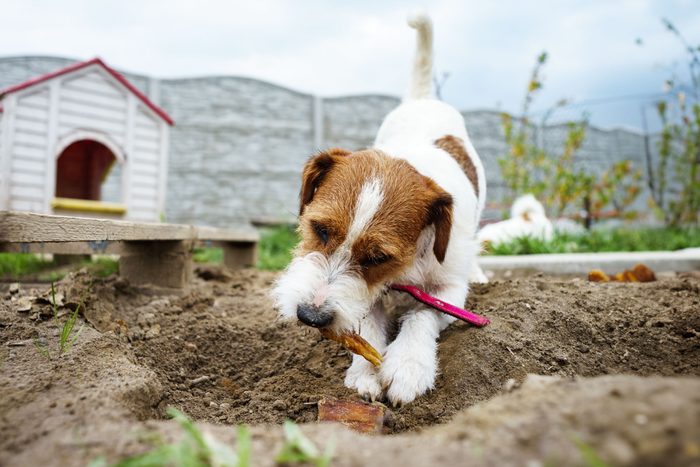
Remember that dogs didn’t always live in houses or apartments. In fact, they were once wild animals and share a common ancestor with gray wolves. Much of what they do today can be explained by looking at that heritage, and burying bones is no exception. Before they got their food in fancy bowls, dogs hunted for their dinner, and there was competition for those meals. So let’s look at some of the reasons why dogs bury bones.
It’s an instinct
Many canid species cache their food, meaning they dig a hole and bury food in it for later. But what purpose does that serve? A study in Behavioural Processes that looked at caching in red foxes, coyotes and gray wolves states that “food caching gives animals a biological advantage over non-cachers, as it allows for the control over the availability of food in harsh or changing environments.” In other words, animals that bury their food for later are playing it safe in case of a proverbial rainy day.
And as dogs evolved from a wolf ancestor, they play it safe too, whether they are free-roaming or living as pets. Rachel Lane is a certified behavior consultant, dog trainer and the owner of the dog-training company Leash & Learn. She says burying food like bones is rooted in a dog’s genetics and may have once been essential for survival, as it serves as an advantage in case of a food shortage. “Even though most companion dogs do not experience a lack of food, they still may bury their bones and other resources because it is instinctual,” she says.
So if it’s an instinct, is it equally strong in every dog? The connection to ancestral roots may seem obvious in wolflike dogs such as huskies or German shepherds, but do dogs like pugs and bulldogs dig and bury too? According to celebrity dog trainer Nicole Ellis, dogs that are bred to hunt and chase are the ones that most often bury things. However, digging is an innate desire of many dogs. “Some dogs may simply enjoy the act of digging without the act of hiding something,” she says.
Indeed, any dog may hide or bury items, even if it’s not typical for the breed. A recent study in Science looked at how dog genetics align with breed characteristics. The researchers discovered that greyhounds weren’t big on burying their toys. In fact, 90% of the greyhounds in the study never performed that behavior. However, three of the greyhound subjects were described by their owners as “frequent buriers.” So even when you might not expect it, a dog can love digging and burying bones.
It keeps their food fresh
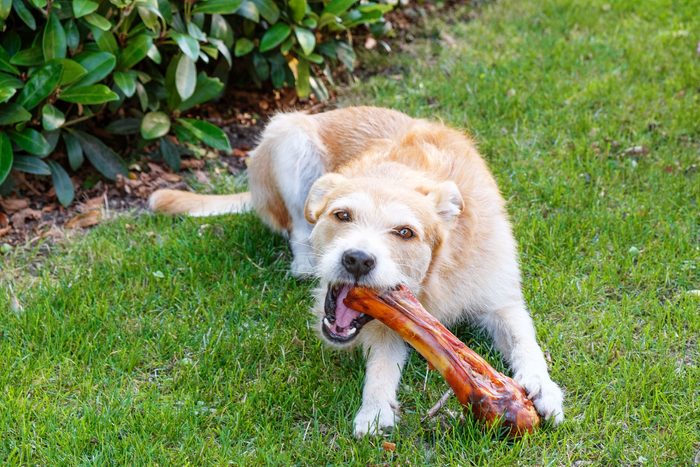
It’s obvious a buried bone is hidden safely for later, but will it be any good when the dog returns to enjoy it? After all, it will be covered in dirt. Ellis says burying meat in the soil is actually a way of preserving it because it won’t go rancid as quickly as it would if it was left sitting in the hot sun. No wonder that instinct to cache is so strong.
But dogs will bury items even inside the house. If you have one of those pets, you’ve probably wondered, Why does my dog hide his treats under my pillow? It’s the same caching behavior. Lane says that when your dog can’t get outside to bury a beloved object, it will do so inside instead. “Burying toys, bones and treats under pillows or blankets serves the same function as burying these items in the dirt–it’s to save them for later and to prevent predators and competitors from accessing them,” she says.
Whether it’s inside or outside, do dogs remember where they buried their bones? Or are they just sniffing for them with their superior sense of smell? Of course, dogs can find hidden food by smell alone, but veterinary psychiatrist Sagi Denenberg, DVM, a diplomate of the American College of Veterinary Behavior, says dogs remember where objects are hidden too. “We know they also use memory because tests show that even if other areas are smell-baited, they still choose based on memory,” he says.
In fact, a recent study in PLOS ONE discovered that both wolves and dogs are able to use spatial memory, the ability to recall the location of objects, to find cached food. When the animals watched the experimenters hide the food, they retrieved more caches and were more efficient for the first few caches than if they searched by smell alone. The researchers concluded that the animals don’t “simply rely on scent to find the rewards.”
It helps them cope with anxiety
Dogs may also bury bones and other items in an attempt to prevent any competitors from accessing them. But due to this, burying can be tied to canine anxiety and resource guarding, a behavior in which dogs feel a need to protect and defend objects they deem important. Lane says this motivation for burying is more common in dogs that live with other dogs and those that have or have had scarce resources.
Dr. Denenberg explains that all resource guarding is rooted in anxiety, whether that guarding involves the owner’s attention, spaces or toys and food. The dog is worrying about losing something it needs now or will need in the future. “It is a question of value and anxiety,” he says. “If the dog values the item [like food or toys], it will protect it.”
Ellis adds that digging is a soothing behavior for some dogs, so anxious dogs may do it more often. Burying can also help a nervous dog protect its resources, even if there is more than one bone or toy available. For example, if there is another dog around, burying the object will help calm the anxious dog, as it knows it can come back to eat or play with the object later when it’s alone and feels more comfortable.
It relieves boredom
Dr. Denenberg lists a final reason dogs bury items: boredom. Dogs that don’t have enough to do or that live in an environment that lacks enrichment often turn to digging as an outlet for excess energy. Plus, he says, “a bored dog may hide a resource if they need [or] want it in the future.”
How to stop your dog from digging and burying things
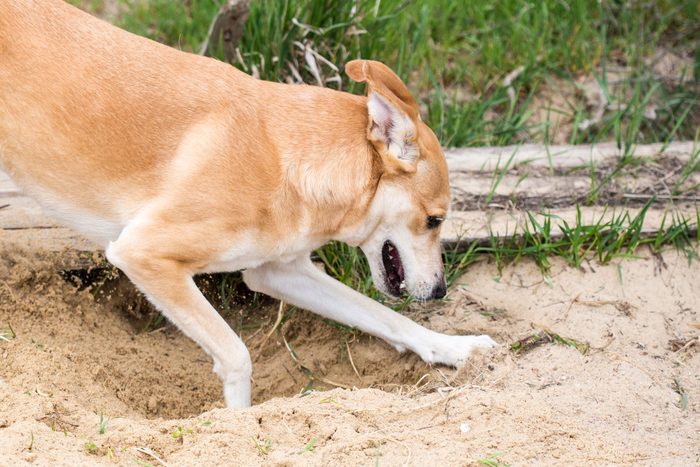
“If the digging is not bothering the owner, becoming compulsive, somehow causing physical harm to the dog or contributing to resource guarding, it’s fine to let your dog dig as much as they want,” Lane says. But if you want to save your garden, the following strategies will help curtail your dog’s digging and burying behavior.
- Provide your dog with an appropriate outdoor digging spot. For example, Ellis recommends filling a kiddie pool with sand or dirt and encouraging your dog to dig and bury in that location instead of in the yard.
- Keep a variety of bones and toys in rotation so your dog doesn’t become bored with what it has available. But Lane suggests not having too much of a surplus to encourage your dog to use what’s available versus stashing extras away.
- Ensure your dog has sufficient resources to avoid the need to resource guard. Dr. Denenberg suggests training your dog to leave toys in a dedicated container in a quiet corner of the house. Show your dog the container and place some treats there so your dog learns to visit the location. Then place its favorite toy or chew inside and encourage it to take the item there instead of burying it somewhere else.
- Teach your dog to love its crate and go there when it wants to chew or play with a bone or toy. Then encourage your dog to leave the bone in the safety of its crate when it’s finished.
- Give your dog an indoor digging toy, like the iDig by iFetch. This toy has a plastic base containing layers of machine-washable flaps. You can hide treats inside the flaps and let your dog “dig” them out.
- Teach your dog to go to its place, like a dog bed or crate, and reward it with its bone when it’s there. This will teach your dog where it’s appropriate to enjoy that treat. Make sure it’s a safe place where other animals can’t steal your dog’s bone.
- Redirect your dog if you see it digging. Don’t reprimand it but rather call it over to you and reward it heavily for leaving the area and coming to you.
- Add walks and playtime to your daily routine to fight doggy boredom. If your dog has other stimulating outlets, it will be less likely to dig and bury for entertainment.
- Put digging on cue. Then, Lane says, you can ask your dog to dig at specific times and in specific places that are convenient for you.
Why trust us
At Reader’s Digest, we’re committed to producing high-quality content by writers with expertise and experience in their field in consultation with relevant, qualified experts. For this piece, Stephanie Gibeault, MSc, CPDT-KSA, tapped her experience as a certified professional dog trainer and journalist, and then Wailani Sung, DVM, a veterinarian who owns Bay Area Vet Behavior, gave it a rigorous review to ensure that all information is accurate and offers the best possible advice to readers. We verify all facts and data, back them with credible sourcing and revisit them over time to ensure they remain accurate and up to date. Read more about our team, our contributors and our editorial policies.
Sources:
- Rachel Lane, CBCC-KA, CPDT-KA, MSc, certified behavior consultant, dog trainer and owner of the dog-training company Leash & Learn in New York City; email interview, March 11, 2024
- Nicole Ellis, CPDT-KA, author of Working Like a Dog, celebrity dog trainer and expert dog trainer on Amazon Prime’s The Pack; email interview, March 5, 2024
- Sagi Denenberg, DVM, veterinary behaviorist at North Toronto Veterinary Behaviour Specialty Clinic; email interview, March 5, 2024
- Behavioural Processes: “Revisiting the concept of behavior patterns in animal behavior with an example from food-caching sequences in Wolves (Canis lupus), Coyotes (Canis latrans), and Red Foxes (Vulpes vulpes)”
- PLOS ONE: “Observational spatial memory in wolves and dogs”
- Science: “Ancestry-inclusive dog genomics challenges popular breed stereotypes”
When my son was diagnosed with autism at age 4, I had mixed emotions. I was relieved to finally have an explanation for his developmental delays and rigid behaviors, but I worried about his future—life is often harder for those who dance to a different drum. It took me a while to embrace some of those unique traits and to see strength in difference.
I was helped along this road by a friend who shared the poem “Kids Who Are Different” by Digby Wolfe. The last lines really hit home:
“For when they have grown, as history’s shown,
It’s their difference that makes them unique!”
Since then, we’ve strived to live life to its fullest and dream big for our son. We celebrate his love of nature by exploring national parks, make travel easier by visiting autism-friendly resorts and try to educate others about autism to promote inclusivity and acceptance.
April is Autism Awareness Month, a designated time to talk about autism, celebrate individuals on the autism spectrum and raise awareness about the neurodevelopmental disorder that affects 1 in 36 children in the United States. For parents out there with a recently diagnosed child, or individuals who have received a diagnosis as an adult, let the words of those who have lived, researched and written about autism lift your spirits, like Wolfe’s words lifted mine. Read on for 20 inspirational quotes about autism for Autism Awareness Month.
1. “I am different, not less.” ―Temple Grandin, professor, author, animal behaviorist and autism self-advocate
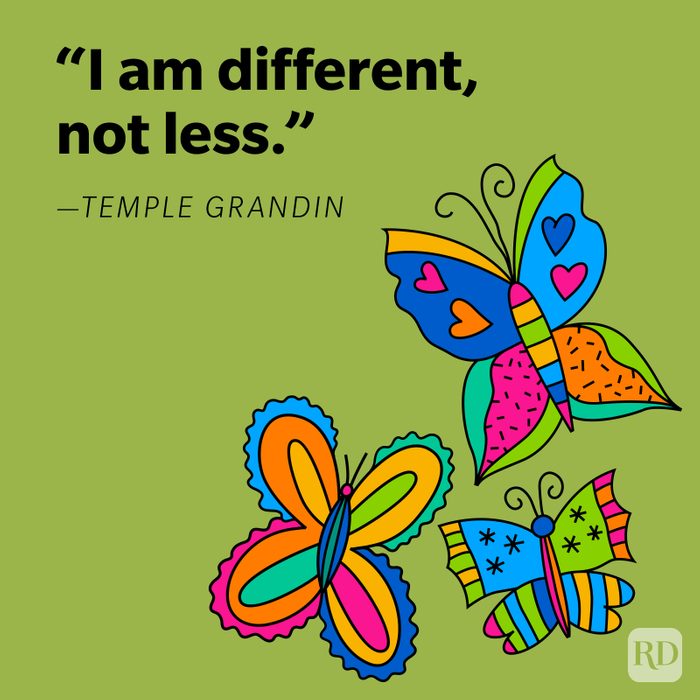
2. “There is no ‘real’ child hidden behind the child you know. Look at him—that’s your kid. Love him—he’s your kid. Enjoy his strengths and quirks—they make up the unique person who is your kid. But also help him overcome his areas of weakness—he’s your kid and you owe him that.” —Lynn Kern Koegel, co-author, Growing Up on the Spectrum
3. “People think autistic people don’t have empathy, but that’s not true. Sometimes I can’t tell if someone’s upset, but once I know, I feel lots of empathy … maybe even more than neurotypicals.” —Sam Gardner, character with autism on the hit TV show Atypical
4. “I don’t want to be a genius or a freak or something on display. I wish for empathy and compassion from those around me, and I appreciate sincerity, clarity and logicality in other people. I believe most people—autistic or not—share this wish. And now, with my newfound insight, I’m on the way to achieving that goal. I hope you’ll keep those thoughts in mind the next time you meet someone who looks or acts a little strange.” —John Elder Robison, author, Look Me in the Eye: My Life with Asperger’s
5. “When raising a child with a disability a parent doesn’t always enjoy the typical things that so many other parents take for granted—i.e. first words, riding a bike, crossing the monkey bars, etc. We parents of children with disabilities don’t take anything for granted. Everything my son did was a miracle. I like to reverse the astronaut’s quote and say, ‘What is one small step for a typical kid is a giant leap for my special child.’ Every seemingly small achievement is a miracle to me.” —Elaine Hall, neurodiversity advocate and pioneer
6. “I used to think, when I was first diagnosed with Asperger’s Syndrome—a form of autism—about what I can’t do, rather than what I can do, which was a mistake in thinking.” —Merrick Egber, administrative assistant and Els for Autism Foundation Chair of the Advisory Board
7. “There is no doubt that autism makes my life difficult, but it also makes my life beautiful. When everything is more intense, then the every day, the mundane, the typical, the normal … those things become outstanding.” —Erin McKinney, basketball operations assistant with the Memphis Grizzlies
8. “If you’ve met one person with autism, you’ve met one person with autism.” —Stephen Shore, professor, autism advocate and person living with autism
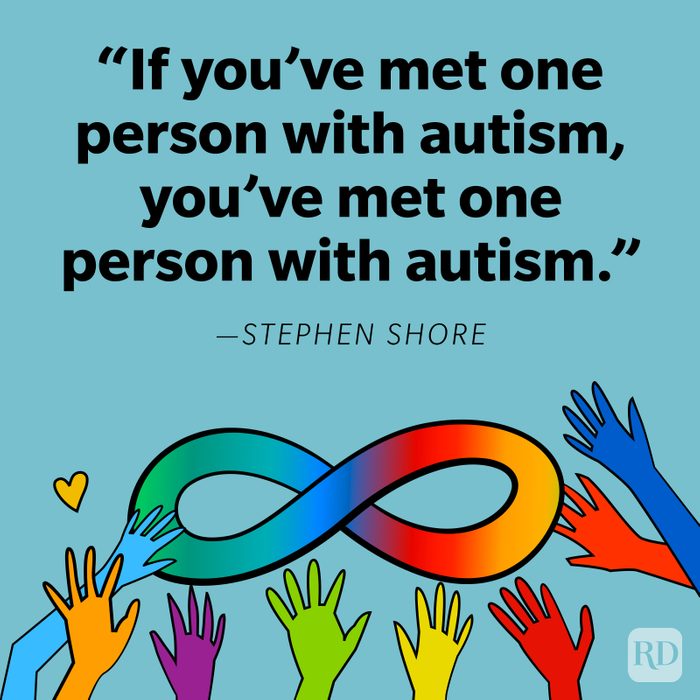
9. “Trying to fit in just seems like too much of a hassle for me, and I would much rather make friends with people who can accept me for who I am, since that is the very thing that makes a friendship a friendship. Though it may be difficult for some people on the spectrum to make and keep friends due to the complexity of friendships, any friend who has the understanding and acceptance they are looking for is going to be very lucky.” —Kaitlin Smith, author, Take It from the Expert: Sixteen Years of Experience Living on the Autism Spectrum
10. “Autism doesn’t come with an instruction guide. It comes with a family who will never give up.” —Kerry Magro, disability advocate, national speaker and bestselling author
11. “I work hard to celebrate my son Bennett’s milestones, like learning to put his shoes on and hopping on one foot and singing ‘Bingo,’ because for Bennett, little triumphs that go unnoticed in other children are huge; they are small steps on his slower, windier road to (fingers crossed) independence. We don’t know where the road will go, so we try to enjoy the bumpier ride.” —Lisa Kadane, journalist whose son has autism
12. “Autists are the ultimate square pegs, and the problem with pounding a square peg into a round hole is not that the hammering is hard work. It’s that you’re destroying the peg.” —Paul Collins, author whose son has autism, from his book Not Even Wrong: A Father’s Journey into the Lost History of Autism
13. “Look, I know I sometimes say or post strange things, but that’s just how my brain works. To anyone who’s been offended, I just want to say I reinvented electric cars, and I’m sending people to Mars in a rocket ship. Did you think I was also going to be a chill, normal dude?” —Elon Musk, founder of Tesla and person living with Asperger’s Syndrome
14. “I might hit developmental and societal milestones in a different order than my peers, but I am able to accomplish these small victories on my own time.” —Haley Moss, attorney with autism and autism advocate
15. “Wanting to be free
Wanting to be me
Trying to make people see
And accept the real me.”
—Scott Lentine, autism self-advocate who writes poetry
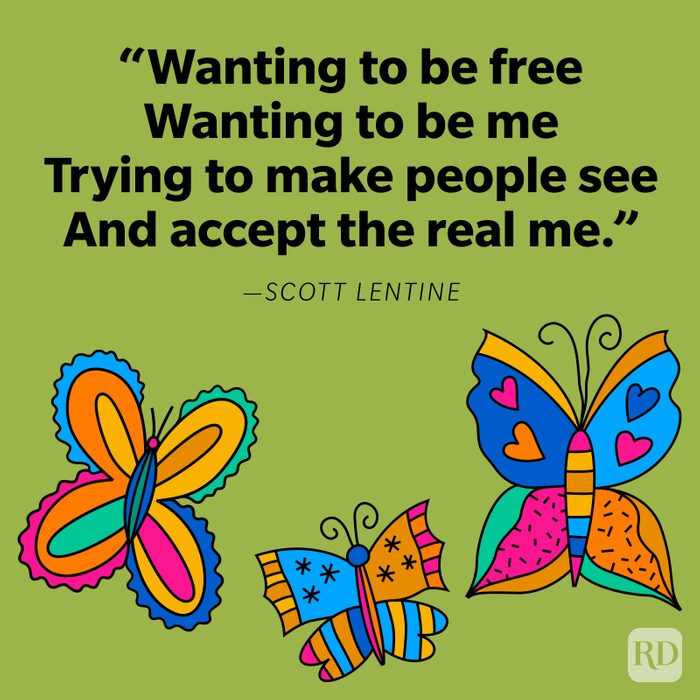
16. “What would happen if the autism gene was eliminated from the gene pool? You would have a bunch of people standing around in a cave, chatting and socializing and not getting anything done.” ―Temple Grandin, professor, author, animal behaviorist and autism self-advocate, from her book The Way I See It: A Personal Look at Autism & Asperger’s
17. “I believe that inside every person who is bullied there is a strength and a tenacity to survive. You don’t always know that this strength exists, but if you make it through those dark times, you become aware. You become a survivor, someone whose courage and spirit is far stronger than all of the hate and cruelty of their bullies. The one thing that I want to impart to children with autism is knowledge of their own inner strength, and the belief that one day at a time, they, too, can get through this.” —Amy Gravino, autism advocate
18. “It takes a village to raise a child. It takes a child with autism to raise the consciousness of the village.” —Elaine Hall, neurodiversity advocate and pioneer
19. “I’ve learned that every human being, with or without disabilities, needs to strive to do their best, and by striving for happiness you will arrive at happiness. For us, you see, having autism is normal—so we can’t know for sure what your ‘normal’ is even like. But so long as we can learn to love ourselves, I’m not sure how much it matters whether we’re normal or autistic.” —Naoki Higashida, author of The Reason I Jump
20. “No matter how many ways life’s circumstances attempt to restrict me from being ‘normal,’ I’ve learned that when we try to look past ‘labels’ and resist the urge to limit ourselves and others, we will learn to finally start living. We will learn to believe in our greatest potential. We will learn that we are all strong.” —Lamar Hardwick, The Autism Pastor
Source:
- “Kids Who Are Different” by Digby Wolfe
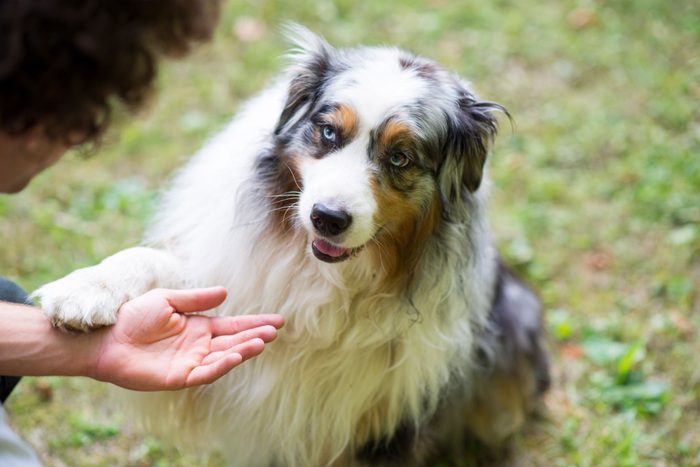
It’s an all-too-familiar scenario: You’re watching TV or attempting to work when you’re interrupted by your dog pawing at your leg. That small action can turn any pet owner into an amateur sleuth bent on answering a single question: Why do dogs put their paw on you? Do they want attention? Did you forget to serve dinner? Or are they just saying “hello”?
Let’s face it: Dogs can be a total mystery sometimes. If only we could ask them what they were thinking, we would have a much better time understanding dog behavior. And the more we understand what our dogs are trying to accomplish, the better we can respond. That might involve giving a dog affection or teaching it a less demanding way to communicate.
In over 13 years as a certified professional dog trainer—and even longer as a dog owner—I’ve been pawed plenty of times. It’s especially common during training classes; it doesn’t take much time for my canine clients to sniff out the freeze-dried liver in my pockets. That’s given me particular insight into the question of why dogs put their paw on you. Luckily, we have a very good idea of their motivations. Read on to learn the different things dogs are saying with their paws.
Get Reader’s Digest’s Read Up newsletter for more pet insights, humor, travel, tech and fun facts all week long.
About the experts
|
Why do dogs put their paws on you?
Chances are, your dog learned that pawing you is a great way to get a response. As veterinary behaviorist Isabelle Bazin, MV, DES, of the Daubigny Veterinary Center in Quebec City points out, pawing is hard to ignore. “It might happen through trial-and-error learning, but because there is physical contact, there is a good chance the human is going to react,” she says. But what are you reacting to? Is your dog pawing to ask for something, or is it just an annoying way to demand affection? Let’s look at the top reasons dogs use their paws.
They’re communicating with you
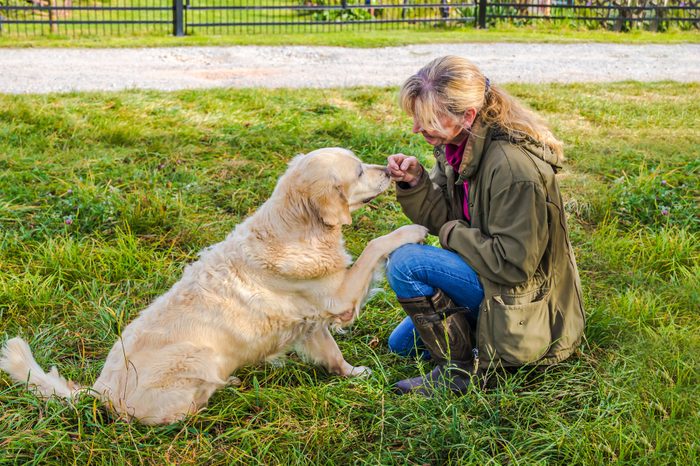
Dogs communicate using vocalizations, olfactory signals, facial expressions and body language, says certified behavior consultant and dog trainer Rachel Lane, CBCC-KA, CPDT-KA, MSc, owner of the dog-training company Leash & Learn. Their body language repertoire is vast, and it includes the use of their paws. So just as your dog stares at you to tell you something, it may also put its paw on you.
Certified behavior consultant and dog trainer Valerie Balwanz, CBCC-KA, CPDT-KA, points out that dogs use their paws to communicate with other dogs too. “Dogs will often paw at another dog in an attempt to get them to play,” she says. “Because dogs include us in their social circles, they use these communication signals with us too.”
Just how much communicating a dog will do with its paw depends on the pup’s personality. When a dog lacks frustration tolerance (the ability to deal with frustrations), the behavior is even more noticeable. Are you taking too long to prepare your dog’s dinner or folding the laundry when it’s time for a walk? Be prepared to feel that paw.
You can use that pawing behavior to your advantage, though, especially if you enjoy trick training with your dog. “If your dog is using their feet a lot, it’s fun to capitalize on this and teach them some tricks where they would use their paws, such as ‘shake,’ ‘high-five,’ ‘wave’ or ‘hit a buzzer,'” Balwanz says.
They’re showing affection
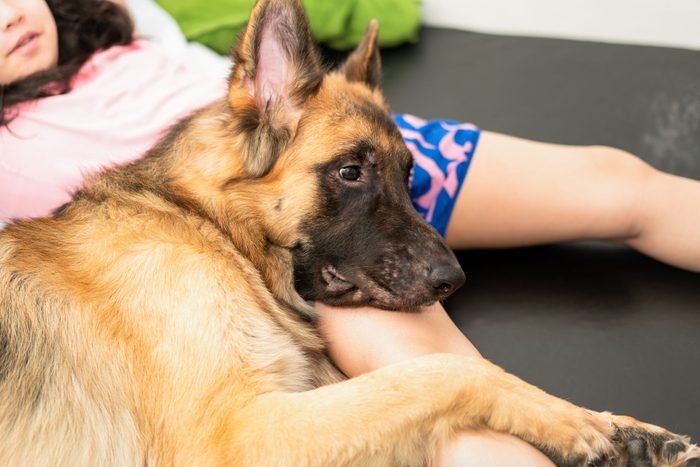
Rather than scratching at their favorite human, some dogs like to rest their paws on people in what looks like the canine version of holding hands. Why do dogs put their paw on you in this way? And do dogs love you if they put their paw on you?
Balwanz says dogs enjoy being in physical contact with people they know and trust. “If your dog is pawing at you to ask for petting or resting their paw on you while cuddling, it certainly indicates a special level of comfort and affection they wouldn’t exhibit with a stranger,” she says.
Dr. Bazin agrees that some dogs are looking for ways to be in contact with their family members. You probably recognize that your dog lying side by side with you is a sign of trust and love. Resting a paw on you is another way for your dog to show how it feels. And although it seems like a stripped-down version of cuddling together, it doesn’t mean your pup likes you any less.
They’re trying to get your attention
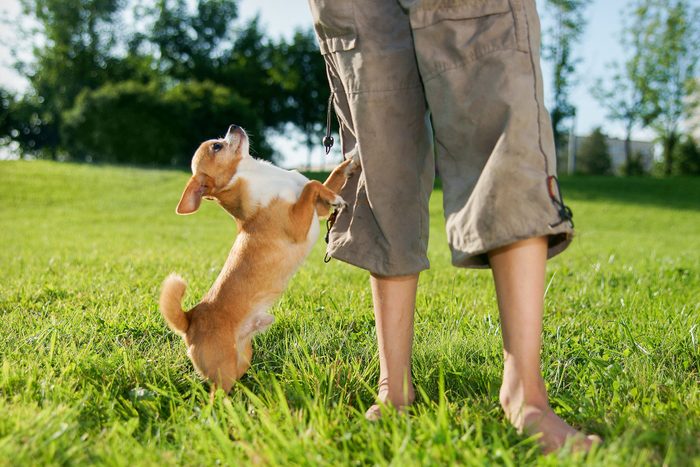
Another reason dogs paw at you is because they’ve learned it’s a great way to get your attention. “Dogs repeat behaviors that work to get them something that they want,” Balwanz explains. “In the case of pawing at you, there is a good chance your dog tried this once, or it happened accidentally, and it resulted in something that they wanted, probably your attention. Your dog learned ‘pawing at my person makes them pay attention!’ The pawing then gets repeated and works again. Because it works, your dog keeps doing it.”
In Dr. Bazin’s opinion, pawing is usually related to attention-seeking. “I think most of these dogs have been taught to shake a paw, and they have learned that when they do that, people are very happy. The dogs get treats, and they get attention. Then they try to reproduce that to get treats or attention in other contexts.”
They need something
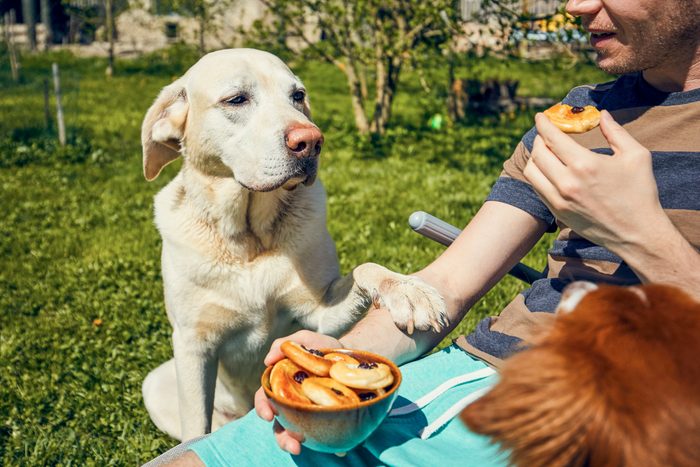
Lane points out that there are other rewards for putting a paw on somebody besides attention. For example, the dog might like food, time to play, a chance to go for a walk or the opportunity to potty outside.
Why do dogs put their paw on you when they want something instead of, say, barking or rubbing up against you? Chances are, your dog has used pawing to get something in the past. Now it sees the action as a way to express its needs.
Dr. Bazin says that when something works, and pawing usually does, the dog is going to continue that behavior and won’t try another way to get what it wants as long as it keeps working. Therefore, if you fill your dog’s water bowl when it paws at you, you’ve now established pawing as a way to ask for water. Your thirsty pooch won’t ask for water with a different behavior until you stop responding to pawing by filling the water dish.
They’re bored
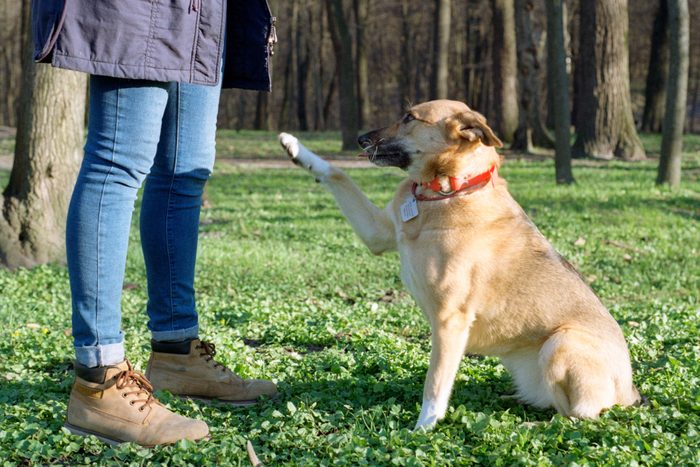
Our pups know that we’re often the bearers of entertainment, providing them with games and toys. So they may paw at us when they’re bored. “They know that the person is often the source of reinforcers, and they are looking for something to do or some sort of enrichment,” says Lane. The best way to handle that is to provide for your dog’s needs. If you’re too busy to play, for example, she suggests giving your dog some sort of puzzle toy or a food-stuffed toy to help prevent pawing.
Dr. Bazin advises prevention first. For instance, if your dog regularly paws you at a certain time of day to tell you it has to go potty, schedule your walks for that time so your dog won’t need to ask. And keep those enriching toys in your dog’s environment so it can use them to stay physically and mentally active. “Then he will ask less of you at those times because he’s better in general,” she says.
They’re anxious
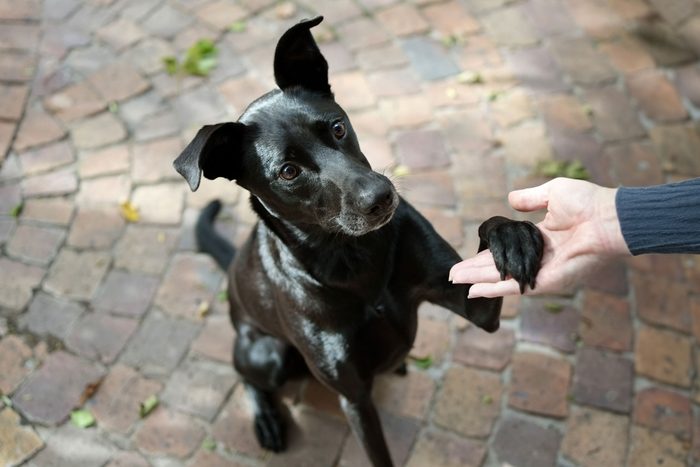
Although pawing can be normal in certain circumstances, excessive pawing may be a sign of dog anxiety. Dr. Bazin recently saw a dog that, when staying with the owner’s mother, would paw the mother 10 to 15 times a day to get whatever it needed, including potty breaks and treats. It was a nervous dog that had a hard time resting and calming down, and pawing was a way for it to express its stress and anxiety.
Of course, you’ll know if your dog is acting out of anxiety only if you assess the entire situation. Dr. Bazin recommends looking at the dog’s body language. I always look for subtle signs, including a tucked-in tail, pulled-back ears, lip licking and yawning.
Putting a paw on you may be a way for your dog to seek social support, says Lane. It can be a signal that your pup feels ill-equipped to deal with its current situation and is asking you for help. She suggests you respond to this kind of pawing, as your dog needs you at that moment.
“This can help dogs learn healthier ways of coping with stress in the future, as well as develop a positive relationship between dog and owner,” says Lane. “When a dog is pawing at the person because they are anxious, it is also important to work with a dog trainer or behavior consultant to address the underlying anxiety and fear so that it resolves in the future.”
How to stop a dog’s pawing habit
If you’ve provided for your dog’s daily needs, including sufficient exercise and mental stimulation, and it is still pawing at you, that’s likely because it has learned that pawing gets it what it wants. In that case, to eliminate the behavior, you need to ignore it completely.
Dr. Bazin warns that, when training your dog out of this behavior, you shouldn’t move toward or look at your dog when it’s putting its paw on you—even a glance is attention. You might think you’re punishing your dog by yelling, “Bad dog!” But that could actually be reinforcing because it’s attention, and that’s what the dog is looking for.
Be aware that when a behavior is no longer reinforced, such as when you ignore your pup, the intensity of that behavior will likely increase before it gets better. If you react in that moment, you will only create an even bigger problem, so you absolutely must continue to ignore the behavior until it finally disappears. It can be a long process, and it requires consistency and the entire family’s participation.
The last part of breaking your dog’s pawing habit is to reinforce the behavior you would like to see in its place. It’s essential to never take good behavior for granted. “If you want your dog to bring the ball instead of pawing at you, then if he brings the ball to you, please give him attention and give him a treat,” says Dr. Bazin. “You’re going to reinforce the behavior you really want in your dog.”
Why trust us
At Reader’s Digest, we’re committed to producing high-quality content by writers with expertise and experience in their field in consultation with relevant, qualified experts. For this piece, Stephanie Gibeault, MSc, CPDT-KSA, tapped her experience as a certified professional dog trainer and journalist, and then Wailani Sung, DVM, a vet with a board certification in veterinary behavioral medicine who owns Bay Area Vet Behavior, gave it a rigorous review to ensure that all information is accurate and offers the best possible advice to readers. We relied on reputable primary sources, including certified canine behaviorists and dog trainers, as well as our writer’s personal experience. We verified all facts and data and backed them with credible sourcing, and we will revisit them over time to ensure they remain accurate and up to date. Read more about our team, our contributors and our editorial policies.
Sources:
- Valerie Balwanz, CBCC-KA, CPDT-KA, certified behavior consultant, dog trainer and owner of Dog Training by Valerie; email interview, March 10, 2024
- Isabelle Bazin, DVM, DACVB, veterinary behaviorist at the Daubigny Veterinary Center in Quebec; video interview, March 13, 2024
- Rachel Lane, CBCC-KA, CPDT-KA, MSc, certified behavior consultant, dog trainer and owner of Leash & Learn; email interview, March 11, 2024
There are some things we definitively know about dogs, like why dogs get the zoomies or what it means when a dog licks you. We also know they love their toys. It’s one of life’s simple pleasures to watch our pups happily chew and toss around their favorite indestructible dog toy or try to uncover the treats in a challenging puzzle toy. But when it comes to coveted toys, there’s one thing that confounds many people: What’s the appeal of squeaky toys? To mere humans, they’re kind of annoying. Yet, dogs can’t get enough of them. It’s crazy how many times a dog can make a toy squeak in an hour and then return to it later like it’s brand new! So, why do dogs like squeaky toys so much? We spoke to dog behavior experts and veterinarians for answers. Here’s what three experts say.
Get Reader’s Digest’s Read Up newsletter for more pets, cleaning, humor, travel, tech and fun facts all week long.
About the experts
Reviewed for accuracy by: Wailani Sung, DVM, a veterinarian with board certification in veterinary behavioral medicine. Dr. Sung is the director of the behavior and welfare programs at the San Francisco Society for the Prevention of Cruelty to Animals and is the co-author of From Fearful to Free: A Positive Program to Free Your Dog From Anxiety, Fears and Phobias. |
Why do dogs love squeaky toys so much?
1. Squeaky toys mimic the thrill of the chase
Here’s one popular theory shared by canine experts that answers, “Why do dogs like squeaky toys?” The squeaks sound similar to the prey they are hardwired to hunt and kill. Of course, the dogs we have as pets today don’t have to hunt for food; their food is conveniently ready to eat in a bowl each day. Still, that instinct is in their blood.
“Lots of breeds have histories that involve chasing and catching such small animals,” says veterinarian Matthew McCarthy, DVM, founder of Juniper Valley Animal Hospital in Middle Village, New York. For example, labradors and Weimaraners were bred as gun dogs, and adorable small dog breeds like the Yorkshire Terrier were once used to chase and kill rodents.
“Watching your dog tear into, shake silly and disembowel a stuffed squeaky toy until it is ‘dead’ certainly is evidence of this theory/mechanism at work,” notes Dr. McCarthy.
The theory is further reinforced by watching non-hunting breeds. For instance, the Samoyed, a sled dog, isn’t as likely to be interested in squeaky toys because it was bred to stay focused on the trail and not be distracted by small creatures nearby. But Dr. McCarthy points out that this isn’t a hard-and-fast rule, as some breeds, regardless of their ancestral past, may still love squeaky toys.
2. Squeaky toys activate the feedback loop
Think of it this way: When something feels good and is fun to do, you want to keep doing it. The same is true for dogs, of course. When a dog chomps down on a squeaky toy, they hear a sound that triggers an immediate gratifying auditory reward, which, of course, is one of the reasons why dogs like squeaky toys.
“Several studies have shown that certain sounds like those a squeaky toy makes trigger reward centers in the brain to release the feel-good chemical dopamine—much like a runner’s high,” says Dr. McCarthy. Those happy feelings encourage your pup to return to the squeaky toy repeatedly, instilling a feedback loop. That makes sense!
3. Squeaky toys are an invitation to play
From the subtle signals of a dog’s tail to the more obvious signs of an anxious dog hiding under the bed, pet parents can pick up certain communication cues from their dogs. But other messages from our pups are more cryptic and charmingly clever. Have you ever noticed that your pup often likes to play with the squeaker toy right next to you? Why do dogs like squeaky toys when they are in your vicinity? There may be an ulterior motive.
According to Dr. McCarthy, as soon as we engage with them by picking up the squeaky toy, it releases dopamine and oxytocin, which cements their bond with us. “When the dog interacts with the squeaker toy, she is reinforced both by the toy itself as well as with attention from the person,” adds Karen Sueda, DVM, a veterinarian at VCA West Los Angeles Animal Hospital.
4. Squeaky toys seem like real prey
A squeaky squirrel has a tail your pooch may love to swing around and chomp on to make it squeak. Or maybe he goes nuts over his favorite goose toy, wildly shaking it to activate the squeaking sound. You’re not imagining it: Your dog likely loves this pastime because these toys look and sound like real prey. And it’s not just the resemblance of prey or the ear-piercing shrieks that makes this so appealing. Dogs like squeaky toys because they go back to that instinctual nature of hunting, killing and tearing up the prey.
“The squeaker hiding inside comes to somewhat mimic the internal organs of critters,” says Adrienne Farricelli, a certified professional dog trainer at Brain Training for Dogs. “No wonder Rover is so intent biting into it! It squeaks like an animal, and on top of that, it’s so fun to unstuff and disembowel—much to the owner’s dismay.”
High-pitched vs. low-pitched squeaky toys
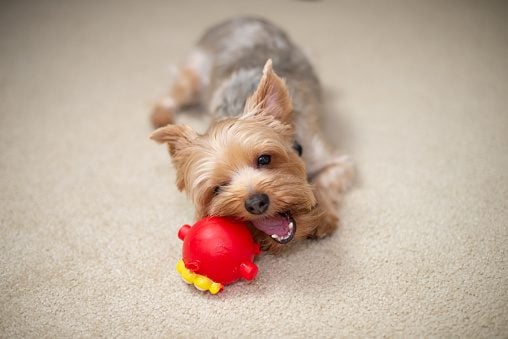
Does your dog act differently when playing with high-pitched and low-pitched squeaky toys? Maybe. “Generally, high-pitched, staccato noise tends to encourage activity, while lower-pitched, longer-duration noise tends to be more calming,” Dr. Sueda says.
Still, some dogs aren’t fans of squeaky toys, no matter what they sound like. “If the dog shies away or seems fearful when you squeak the toy, the sound may bother her,” Dr. Sueda explains.
It’s no big deal from an entertainment perspective if your dog doesn’t enjoy playing with squeaker toys, but the lack of interest could point to other mental and health woes. “If the dog experiences a lot of sound sensitivities, consult with your veterinarian about ways to address your dog’s more general fear of noises,” advises Dr. Sueda. Also, your pooch may have dental or oral pain that prevents him from chomping down to activate the squeaker.
How to use squeaky toys for training
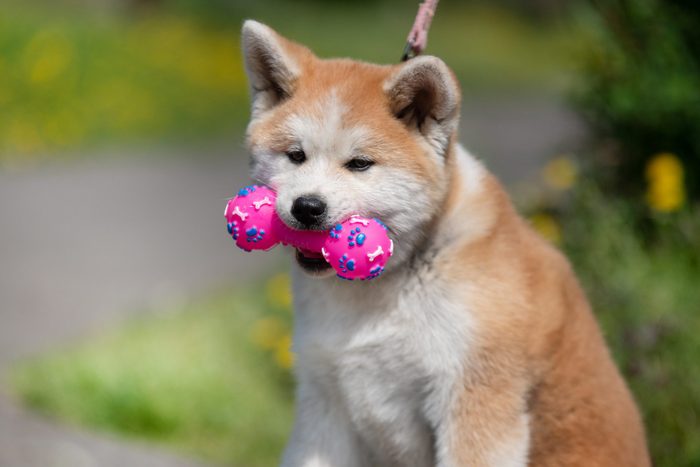
Just when you thought you knew all the dog trainers’ training secrets, the squeaker toy comes along and proves you wrong. Whether it’s a squeaky rope or chew toy, it can be a sneaky way to reinforce your dog’s behaviors, Farricelli says. “Hide a squeaky toy behind your back, call your dog, and reinforce him for coming to you by praising and providing access to the toy as you squeak it and toss it for him to catch.” The squeaker’s sound can also divert your dog’s attention from something they shouldn’t be getting into or unwanted behavior like nipping.
Perhaps the most fun way to utilize a squeaker toy is to capture your dog’s attention when taking pictures. While your dog is in a solid sit/stay position, squeeze the toy to get his full attention. “I get the best pictures this way as they are sitting nicely composed while their ears are perked up, their eyes are bright, and they have a focused, alert expression,” says Farricelli. If she’s lucky enough, she gets the adorable head tilt, too!
Are squeaky toys okay for dogs?
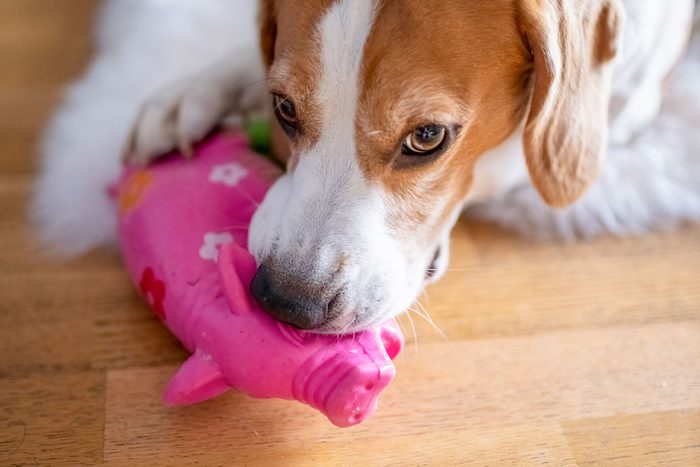
What’s the danger in some good, old-fashioned, instinctual fun? Nothing … unless your pup ingests the squeaker or stuffing after he’s torn the toy to shreds. Dr. McCarthy says that some of his patients pass the material and squeaker when they poop, while other dogs end up with an intestinal blockage that requires surgery to remove them. That’s why it’s so important to keep an eye on your dog when he’s playing with toys, especially squeaky ones.
Equally important is training your dog early on to “drop it” or “leave it” on cue. But if he ignores this command and you can’t get the toy away from him, Farricelli has a suggestion: a high-value swap. Offer your dog something edible that he goes bonkers for, whether it’s a dog treat or a peanut-butter-stuffed Kong.
“The goal is to make the dog feel that when we approach him to remove a toy, we have something far better to offer,” says Farricelli. “[That helps] prevent resource guarding and teaches the dog to voluntarily give up things rather than give us a hard time—like running away with it, baring teeth or trying to bite.”
How to choose safe squeaky toys
There’s no shortage of squeaky toys to choose from. Some toys are cuter and look more fun to play with than others, but what really matters is durability and safety. Plush toys filled with stuffing are the least durable and most likely to be destroyed quickly, and you’ll have to replace them more often. “I recommend rubber or plastic toys, preferably with a raised, ridged or spiked surface, as this helps clean your dog’s teeth and gums while chewing,” Dr. McCarthy says. “And look for BPA-free, food-grade material, which means it is antibacterial and holds up better over time to dog slobber and repetitive cleaning.”
When you need a break from squeaky toys
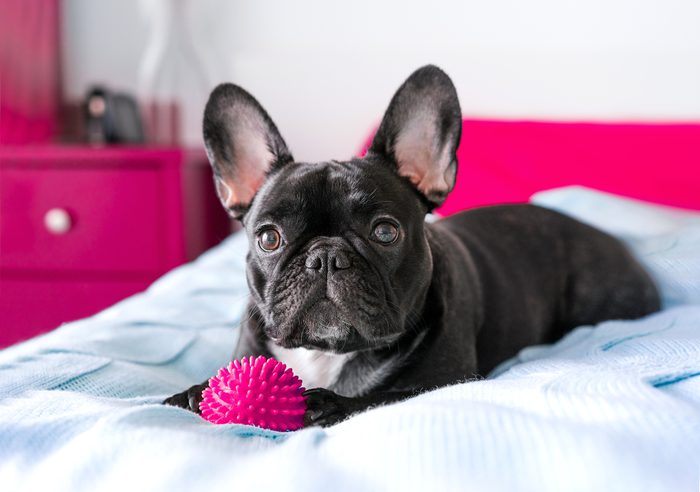
As pet parents, we might not appreciate the seemingly endless loop of the squeaker, and we might hope for what Dr. McCarthy calls a “squeakectomy.” Luckily, there’s a way your dog can still go nuts over a squeaky toy without having to sacrifice your sanity. “Dogs can hear ultra-high-pitched noises that we can’t,” Dr. McCarthy explains. “There are ‘silent’ squeaky toys that operate in these human-sparing frequencies that have all the benefits without the noise!”
Why trust us
At Reader’s Digest, we’re committed to producing high-quality content by writers with expertise and experience in their field in consultation with relevant, qualified experts. For this piece, Lisa Marie Conklin tapped her experience covering pet behavior and training, and then Wailani Sung, DVM, a vet who works at the Behavior Specialty Clinic part of the San Francisco SPCA, gave it a rigorous review to ensure that all information is accurate and offers the best possible advice to readers. We verify all facts and data, back them with credible sourcing and revisit them over time to ensure they remain accurate and up to date. Read more about our team, our contributors and our editorial policies.
Sources:
- Matthew McCarthy, DVM, veterinarian and the founder of Juniper Valley Animal Hospital; interview, November 2022
- Karen Sueda, DVM, veterinarian with a board certification in veterinary behavioral medicine at VCA West Los Angeles Animal Hospital; interview, November 2022
- Adrienne Farricelli, a certified professional dog trainer at Brain Training for Dogs; interview, November 2022
For animals that eat out of the garbage and roll around in the grass, dogs sure do love their creature comforts, especially a snugly place to sleep. From a cozy dog bed to your memory foam mattress, the softest location is often your dog’s top pick when it comes to getting some shut-eye—usually after it has twirled in an adorable little circle. But your pup isn’t the only one with that puzzling ritual. In more than 13 years as a certified professional dog trainer, I’ve heard plenty of pet owners ask, “Why do dogs circle before lying down?”
Dog behavior is a mystery to many people. And it’s no wonder! We’re two different species with different evolutionary backgrounds. You would never think of barking at the mail carrier or drinking from the toilet bowl. And you generally don’t walk in a circle before lying down to snooze. My Chihuahua, however, is a different story. He naps on a throw pillow on top of the couch, and before he lies down, he makes a “nest.” He spins in circles and paws at the cushion until his bed is just right.
This circling behavior is common in dogs, whether they’re on a blanket or in the dirt. But what exactly are they trying to accomplish, and can circling ever be a cause for concern? I talked to animal behaviorists and dog trainers and asked them pet owners’ pressing question: Why do dogs circle before lying down? Keep reading to find out what they said.
Get Reader’s Digest’s Read Up newsletter for more pet insights, humor, travel, tech and fun facts all week long.
About the experts
Reviewed for accuracy by: Wailani Sung, DVM, a vet with a board certification in veterinary behavioral medicine who owns Bay Area Vet Behavior. Dr. Sung is the co-author of From Fearful to Free: A Positive Program to Free Your Dog from Anxiety, Fears and Phobias. |
Why do dogs circle before lying down?
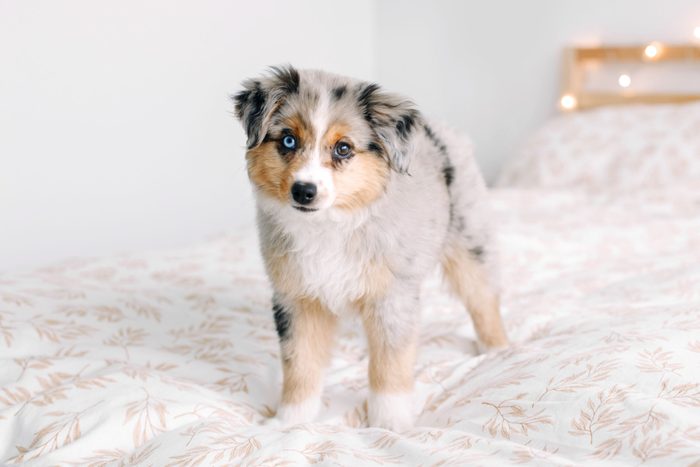
Although it’s hard to imagine your cuddly Cavapoo living in the wild, dogs share a common ancestor with gray wolves. And that ancestor defended a territory, hunted for food and slept on the ground. That heritage has left an impact on today’s pet dogs that has likely contributed to their habit of circling before they lie down.
Keep reading for the top four reasons your pup is circling before lying down.
They’re acting on instinct
Certified professional dog trainer Nicole Ellis, CPDT-KA, says there is no definitive answer as to why dogs circle. What we do know is that this isn’t a modern impulse. “It’s something dogs and wolves have been doing for a very long time,” she says.
Some experts believe a dog’s circling tendency is a genetic predisposition that stretches back to its wolf ancestors, says Mary Burch, PhD, a certified applied animal behaviorist and dog trainer. In other words, your pet’s motivations may be connected to the wolf’s reasons for circling up before bedding down.
One of those reasons could have to do with their powerful sense of smell. Ellis says some people think wolves circle before lying down to suss out the direction of the wind. Then they can arrange themselves to better sniff any intruders approaching in the night.
They’re doing a safety check
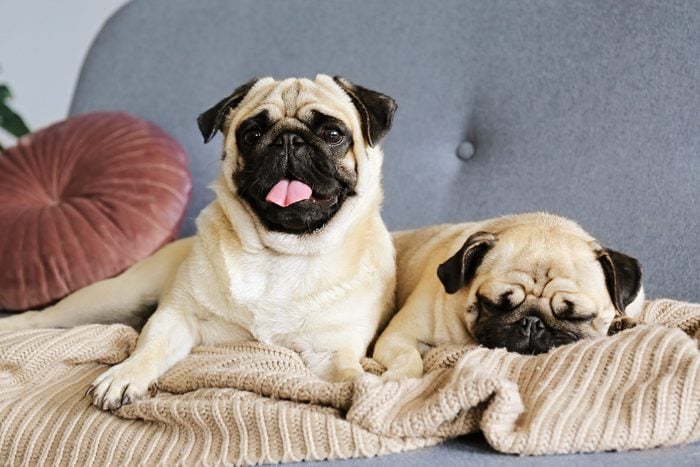
Circling before they lie down might also serve as a 360-degree safety check. Ellis says dogs’ ancestors could have circled to scan the environment and ensure their pack members were accounted for before going to sleep. Or it could have been one last look out for approaching danger.
It could have been a way to focus on nearer dangers too. Remember, the habit hearkens back to a time when plush doggy beds weren’t an option. Dirt and grass—dogs’ former sleep spaces—are very different from the environments most dogs live in today. “Some believe that their ancestors did this to stomp down tall grass and move away any snakes and insects, and it’s carried down through generations,” says Ellis.
They’re regulating their temperature
Along with circling, dogs often dig in their beds. And that may serve to help them regulate their temperature. Think about it: Digging in the dirt on a hot day will expose cooler soil underneath. And digging and circling in the snow can create a compacted nest for holding in body heat.
Burch once had a Siberian husky who loved to sleep outside in the winter, even though he was welcome inside the house. “He would turn around two to three times, as though he was patting down the snow, and lie down in a ball,” she says. “The only one who didn’t sleep well when he was outside in the snow was me—I was constantly checking to make sure he didn’t want to come inside.”
Certified behavior consultant and dog trainer Devan Amundsen, CBCC-KA, CPDT-KA, believes that modern dogs sleep curled up because the position is great at conserving heat around the core of their body. (Some of us humans even sleep curled up on our sides when we’re extra chilly!) Amundsen’s dog has a short coat with an almost bald chest and belly. “When he curls up into a little ball, it’s super obvious that his bald chest/belly gets toasty warm,” he says. “If it’s too hot out, he’ll start uncurling.”
They’re getting comfortable
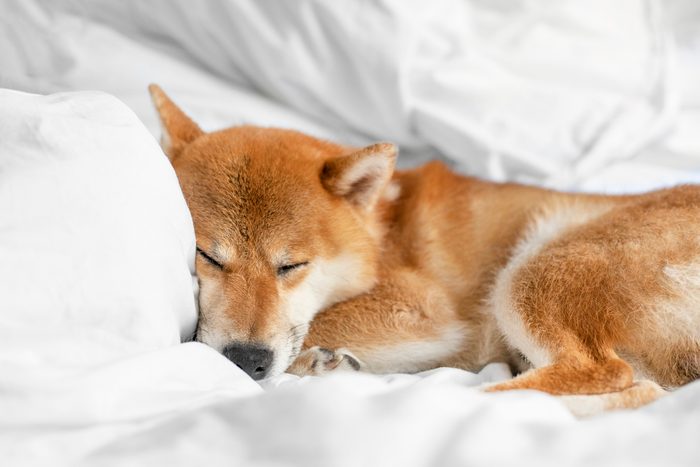
Amundsen says a reason dogs’ ancestors spun around before lying down could be as simple as getting more comfortable. “My understanding of the circling behavior is that it’s creating a relatively flat, circular spot to curl up in,” he says. “Think of how it might look if the dog was in tall grass or soft soil and did those circles. It might pat down the area, find any big uncomfortable rocks, etc.”
But what about when your dog is sleeping inside? Could comfort still be the issue? Absolutely. “With modern dogs who sleep in a cozy dog bed with padding or blankets, the dog can be circling to get the bedding just right,” Burch says. “Think of the dog who does this at bedtime as arranging the blankets and fluffing his pillows.”
When is a dog’s circling behavior a problem?
If you’re worried about your furry best friend’s over-the-top circling, take heart: Turning in circles is normal dog behavior. And it’s not limited to naptime.
Ellis notes that dogs spin in circles at other times too, such as when they are excited. Some dogs even spin around before pooping, which may be an effort to line themselves up with the Earth’s magnetic field. (A study in the Journal of Veterinary Behavior found that dogs prefer to go to the bathroom with their bodies lined up in a north-south direction.) All of that points to the fact that spinning doesn’t signify something’s wrong with your pup—but unusual or too much spinning could.
“Spinning that is excessive or out of the ordinary can be a sign of trouble that indicates the dog has a problem, such as pain [like hip dysplasia], a neurological problem or an inner ear problem [like vertigo],” says Burch.
Cognitive dysfunction in dogs may also lead to spinning, according to Ellis. This medical condition is similar to dementia in humans and can cause a dog to become disoriented and exhibit repetitive movements. Some of those movements can include head bobbing, pacing or walking repeatedly in a circle.
So how do you know when your dog’s circling behavior is cause for concern? Ellis recommends observing your pet for unusual behavior, like spinning away from the bed or having trouble walking in a straight line. Those actions would necessitate an immediate visit with your vet. Also look for signs your dog is experiencing discomfort. “If your dog is spinning for longer periods or getting up a lot after lying down and it seems it may be hard for them to get comfortable, it might be time to speak to your veterinarian and see if there is arthritis or other pain that could be affecting your pet,” she says.
FAQs
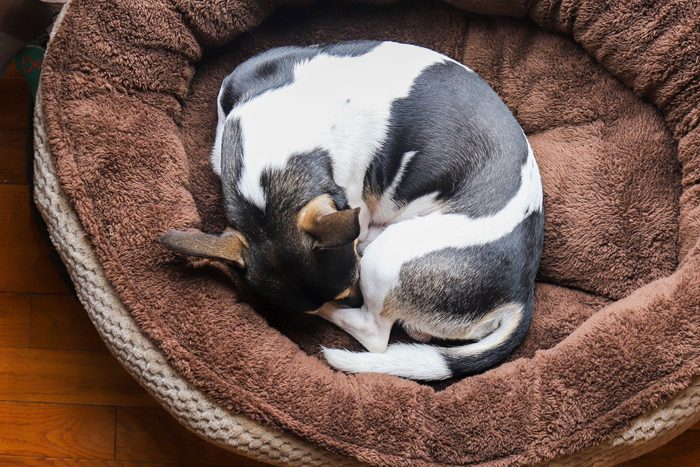
What is the fox sleeping position in dogs?
The “fox position” is a tight ball that dogs curl into before sleeping. Like circling before lying down, this common canine sleep position is also connected to dogs’ innate need for safety.
“From the early days of the ancient dog, it is thought that dogs sleep in the curled-up ‘fox position’ as a way to stay protected from animals who might be inclined to attack,” Burch says. “Sleeping in a balled-up position will ensure that an attacker can’t get to your vital organs.”
Why do dogs sleep curled up next to us?
There are a lot of reasons dogs sleep curled up next to their humans, including a desire for comfort, a sense of safety and the reminder of sleeping with their littermates when they were puppies.
Burch says dogs sleep next to us because they like us. “We give them security, and in some cases, they want to protect us,” she says. “Dogs sleep next to us as a way of being affectionate. Curling up next to one’s person can be a comfortable way for a dog to sleep—it can keep the dog warm.”
In the end, says Amundsen, it comes down to companionship. “Dogs have been by our sides for so long, both literally and metaphorically,” he says. “My own dog is curled up on his bed next to my desk right now, despite there being other bigger/softer beds available in other places in the house. Dogs are social animals. They like being around us because we’ve [selectively bred them] for exactly that for thousands of years.”
Why trust us
At Reader’s Digest, we’re committed to producing high-quality content by writers with expertise and experience in their field in consultation with relevant, qualified experts. For this piece on why dogs circle before lying down, Stephanie Gibeault, MSc, CPDT-KSA, tapped her experience as a certified professional dog trainer and journalist, and then Wailani Sung, DVM, a veterinary behaviorist who owns Bay Area Vet Behavior, gave it a rigorous review to ensure that all information is accurate and offers the best possible advice to readers. We verify all facts and data, back them with credible sourcing and revisit them over time to ensure they remain accurate and up to date. Read more about our team, our contributors and our editorial policies.
Sources:
- Devan Amundsen, CBCC-KA, CPDT-KA, certified behavior consultant, certified dog trainer and owner of Animal Welfare United; email interview, March 1, 2024
- Mary Burch, PhD, certified applied animal behaviorist, dog trainer, author of Citizen Canine and director of the American Kennel Club Family Dog program; email interview, March 11, 2024
- Nicole Ellis, CPDT-KA, celebrity dog trainer, author of Working Like a Dog and expert dog trainer on Amazon Prime’s The Pack; email interview, March 10, 2024
- Journal of Veterinary Behavior: “Directional preferences of dogs’ changes in the presence of a bar magnet: Educational experiments in Israel”
Dog parents love their pets—and want them to love them back in equal measure, as evidenced by the billions of dollars pet owners spend each year on treats, toys and more for their four-legged friends. Given this desire for affection, it’s natural that some pet parents might interpret a dog licking their face or hands as kisses or as expressions of love. But is that what they are, really?
As a board-certified veterinary behaviorist, my favorite part of what I do is educating pet parents on dog behavior and answering the multitude of questions that start with “Why does my dog … ?” One of the most common questions I’m asked is “Why does my dog lick me?”
A simple scientific answer would be that human skin is salty and dogs like the salty taste of our skin. The anthropomorphic response would be “He is telling you he likes you.” Which one is correct? Is your dog just treating you like a salt lick or do dog licks mean kisses? Read on to find out.
Get Reader’s Digest’s Read Up newsletter for more pet insights, humor, cleaning, travel, tech and fun facts all week long.
About the experts
Reviewed for accuracy by: Amy Attas, VMD, an award-winning veterinarian, the founder of City Pets and the author of |
Why do dogs lick you?
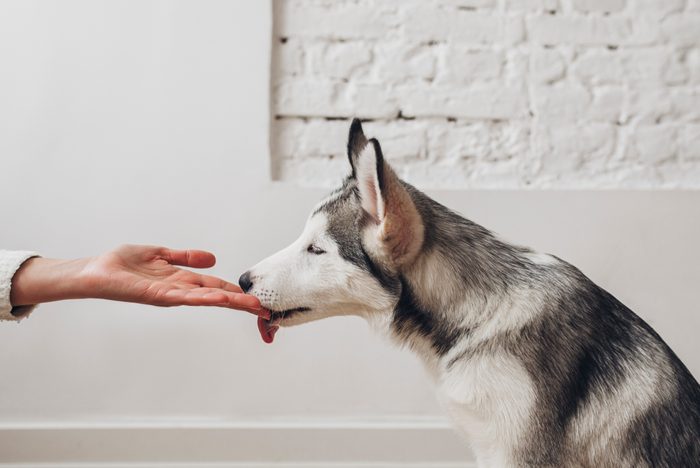
In general, licking is your dog’s way of communicating and learning more about the world. The reason (or reasons) a dog licks you depends on the animal, the situation and the person being licked.
They want a taste
Dogs receive sensory information regarding the item they lick. For example, dogs lick food to get a taste to decide if they do—or don’t—want to bite into said item. When it comes to people, some dogs may like the taste of the salt and may be more likely to lick people when they are crying or sweating. Some dogs may also lick you when your skin is wet, such as when you just stepped out of the shower.
A dog might lick your face or hands after you eat to clean up anything you did not wipe off with your napkin. (If you have toddlers, your dog may need to work extra hard.) Here, dogs are doing double duty in cleaning up the person or child and also getting a taste of human food.
They want a better sniff
The moisture from dog saliva can reactivate some volatile compounds left in dried residues, such as dried saliva or urine. Dogs may lick a person’s hands if they smell food residue on them. After a dog licks the residue, leftover volatile compounds are released into the air again and may provide the dog with additional smells.
They are saying hi
Some dogs might lick as part of their greeting behavior when they are comfortable and happy to see a person. Instead of staring at their owner to get attention, some have learned to use licking as a way to get the person’s attention. Most people find it difficult to ignore a dog that licks them, whether the lick is wanted or not, and will have some type of reaction, be it positive (looking at, speaking to or petting the dog) or negative (moving away).
They’re showing their submissive side
A puppy or other subordinate dog might lick a more confident or assertive adult dog as a way to appease it. This instinct may transfer over to a person they’re uncertain about too. Here, they’re demonstrating “I don’t know where I stand with you or whether you like me or not, so I’m going to lick you to show you that I am not a threat so you don’t get upset with me.”
Should you let your dog lick you?
Most dogs will lick you on your hands or arms, your legs if you’re wearing a skirt or shorts, or your face if they can reach it. In most circumstances, it’s fine for a dog to lick a person, as long as the person is OK with it.
When is it not OK for a dog to lick you?
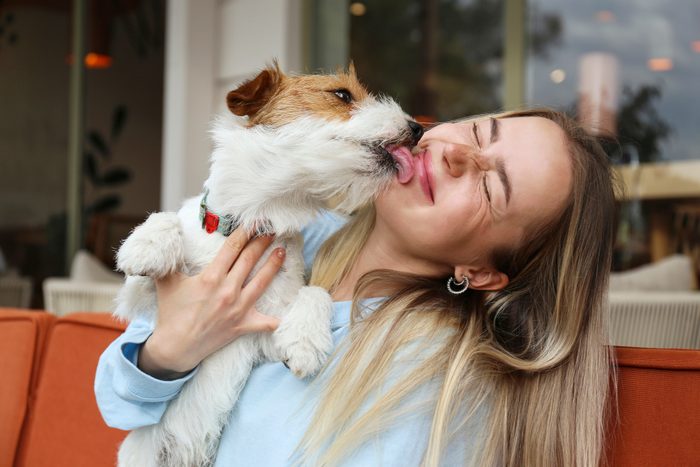
When a person is allergic to dog saliva, immunocompromised or simply does not like being licked, a dog should not lick them. People who are allergic to dog saliva should immediately wash the licked area or wipe it down with a skin-safe disinfectant wipe. Dogs should not be allowed to lick a person’s open wounds, especially if they are immunocompromised, as numerous bacteria, such as clostridia, enterococcus and streptococcus, can live in a dog’s mouth.
When is licking a problem?
Licking is normal dog behavior, and some dogs lick more than others. Licking becomes problematic when:
- A dog won’t stop licking you and you don’t want them to. Some people may be grossed out by dog saliva, and others just prefer not to feel a moist dog tongue on their skin.
- The dog continually licks you in one spot on your body. Repeated dog licks on the same area can be a bigger issue, as it has the potential to irritate your skin. The dampness and bacteria present in your dog’s saliva and on your skin can form a perfect condition for a skin infection to occur.
- A dog repeatedly licks the air or an inanimate, inedible object. This may be a sign of an underlying medical condition, such as dental disease or gastrointestinal discomfort.
- A dog licks one area of its own body repeatedly. This may be an indication that that area is itchy or painful.
Dogs that lick the air, inanimate objects or one area of their body repeatedly should be examined by a veterinarian.
How do you teach your dog to stop licking you?
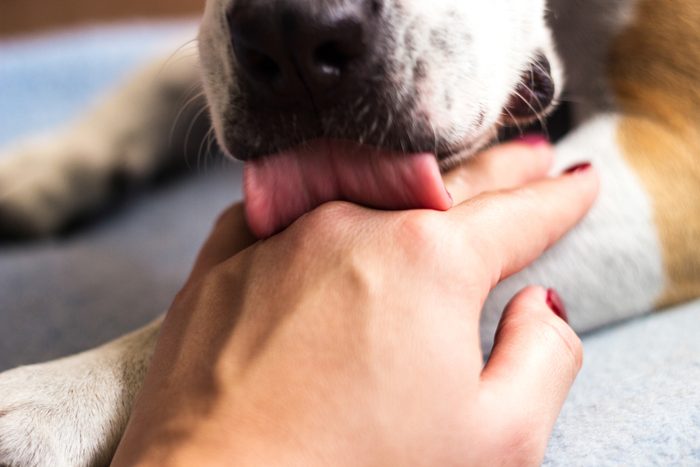
Even though licking is a normal dog behavior, if you do not like it, you can teach your dog to stop licking.
1. Redirect the behavior
The best strategy is to teach and reinforce alternate behaviors. Here’s how that works: If your dog always licks you when he approaches you, ask your dog to sit before he has a chance to lick you, then reward that behavior with a treat, a toy or praise.
2. Ignore the behavior
Another option is, the next time your dog starts licking you, simply get up and walk away, go into another room and shut the door so your dog cannot follow. Your pup will gradually learn that licking makes you go away and, if they don’t want you to leave, then they need to stop licking you. Keep in mind that you need to be consistent with your training, because it takes some time for even the smartest dog to learn the association that licking causes people to ignore him and potentially walk away.
The bottom line of dog licking
I don’t know of any research that definitively states that when dogs lick people it releases endorphins, the feel-good hormone, for the dog. However, if a dog finds licking people to be a rewarding behavior, then endorphins can be released. I think that licking causes people to pay attention to their dogs, and the positive interaction between the person and the dog is rewarding and also may release endorphins for both the human and the dog. While I do not enjoy being licked on the face by my dog, I do see it as a sign of affection.
Why trust us
At Reader’s Digest, we’re committed to producing high-quality content by writers with expertise and experience in their field in consultation with relevant, qualified experts. For this piece, Wailani Sung, DVM, a vet with a board certification in veterinary behavioral medicine, tapped her experience as a certified professional dog trainer and then Amy Attas, VMD, an award-winning veterinarian and the author of Pets and the City: True Tales of a Manhattan House Call Veterinarian, gave it a rigorous review to ensure that all information is accurate and offers the best possible advice to readers. We verify all facts and data, back them with credible sourcing and revisit them over time to ensure they remain accurate and up to date. Read more about our team, our contributors and our editorial policies.
Sources:
- Centers for Disease Control and Prevention: “Capnocytophaga”
- Journal of Veterinary Behavior: “Gastrointestinal Disorders in Dogs with Excessive Licking of Surfaces”
- PLoS ONE: “The Canine Oral Microbiome”
The belief that dogs can sense ghosts is nothing new. The Aztecs of Mexico believed dogs could not only see ghosts but also protect their people from them. They even buried dogs with their dead so that the dogs could guide the recently deceased in the afterlife. The Mayans shared similar beliefs and the Inuit people of the Arctic believed dogs had a connection to the paranormal.
So can dogs see ghosts? It depends on whom you ask—and whether that person believes in ghosts or not.
To dive deeper into the answer, Readers Digest spoke to a number of dog owners who report their dogs have seen ghosts, dog behavior experts and a pet medium. Read on to learn more about dogs and ghosts.
Get Reader’s Digest’s Read Up newsletter for pet insights, humor, cleaning, travel, tech and fun facts all week long.
About the experts
|
Can dogs see ghosts?
Several readers we spoke to shared stories of their dogs’ ghostly interactions, which led them to believe that yes, their own dogs can see ghosts.
“When we first moved into our home that was built in 1940, I could not get two of my Briards (a large herding breed) to leave the mud room—and they’re normally Velcroed to me,” shares Merry Jeanne Key Millner. “We eventually learned we had a grieving mother whose infant son died in the old kitchen (now our mud room), who a year later died herself. Our Briards didn’t want to leave her alone. Minnie (the ghost) has now embraced our crazy family and helps us find lost things!”
Joanna King shares this example about her German pinscher, Parker. “After my father died of pancreatic cancer, at times, Parker would lie down on the floor in the same position as an Egyptian sphinx and I would smell dad’s aftershave. I knew then that the conversation between Parker and my dad was starting. Parker would lift his head up and his eyes would never look anywhere else just at the room’s doorway. The scent of aftershave got stronger, then Parker would tilt his head and respond to dad vocally. When Parker stood up I knew Dad had left. These visits always brought me peace.”
And another, from Margot Keast, who calls herself “a non-professional psychic medium” and shares this story about her late dog, Twinkle, who she believed saw spirits. “I am certain that after my mother died, she would visit and Twinkle was always thrilled to see her. Twinkle would prick her ears and make a high-pitched whistle sound to communicate what she saw. Twinks would behave just like she was schmoozing and talking to her favorite person while I could feel Mum’s energy. Twinkle is now with Mum I am sure.”
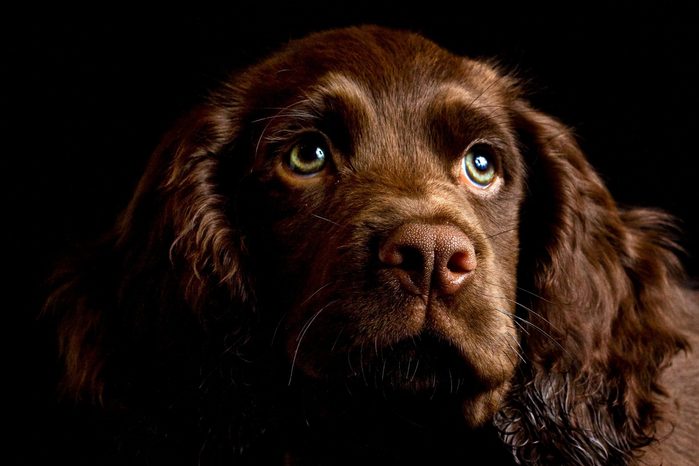
What the scientists say about dogs and ghosts
Despite what the dog owners above report, our expert scientists remain skeptical, after all there aren’t any scientific studies that prove the existence of the paranormal, such as spirits, demons or ghosts. And there certainly aren’t any studies that prove dogs can (or can’t) see spirits, demons or ghosts.
“What I suspect is happening here is people are looking at dog behavior and wanting an explanation, and being reluctant to look at the more obvious ones,” says Alexandra Horowitz, PhD, a senior research fellow and adjunct associate professor at Barnard College.
Those more obvious explanations may include a dog’s keen sense of smell and hearing. “Dogs are naturally equipped with one of the best senses of smell in the animal kingdom,” Jesus Aramendi, DVM, a former senior veterinarian for Chewy and founder of FurLife Vets in Delray Beach, Fla., tells Reader’s Digest. “A dog’s sense of smell can be 10,000 to 100,000 times more sensitive than a human’s.”
As for hearing, dogs can hear twice as many frequencies as humans. According to Dr. Aramendi, dogs can pick up sounds that are four times farther away than humans would be able to detect.
“The human part of the equation is that even when dogs are doing dog-normal behaviors, some people have a tendency to assume there’s something psychic or supernatural about their capacities,” says Stanley Coren, PhD, professor emeritus in the Department of Psychology at the University of British Columbia and an adjunct professor at Bergin College of Canine Studies. “So instead of just hearing a noise outside that prompts a dog to alert bark, one might get the sense they are barking at ghosts.”
Finally, not every behavior a dog—or person, for that matter—does means something, Coren says. “Sometimes dogs are just looking, or smelling, just as we might sit, look into the distance, and daydream or plot dinner or think.”
What the medium says
Science or not, according to a 2024 poll, 64% of those surveyed believe in ghosts, with 20 percent claiming to have personally experienced them. In other words, for a majority of Americans, the question “can dogs see ghosts?” isn’t about whether ghosts exist but rather, whether dogs are capable of seeing them. To learn more, we spoke to Charles Peden a psychic medium and animal communicator whose clients praise his uncanny ability to provide details nobody else could have known about pets and people who have passed on.
According to Peden, all dogs can see ghosts, but not all humans can see the same spirits. “If we could constantly see all the spirits in our lives, we’d be overwhelmed. Dogs don’t go out of their way to pick up on ghosts, and they learn to ignore those that are around them, just as they would learn to ignore their reflection in a mirror. The spirits are always there, but they don’t really affect them, so dogs pay no attention even though they clearly can see them.”
Peden recalls one case in which his client had two dogs, one of which refused to go near the garage. “The dog communicated to me that there was a big scary male spirit in there … and when I went in, she was right! That spirit then communicated that he was connected with the tools. But when I spoke to the clients they had no idea who I was talking about—until the husband mentioned a man he used to work with as a mechanic years ago, and who matched the description exactly.”
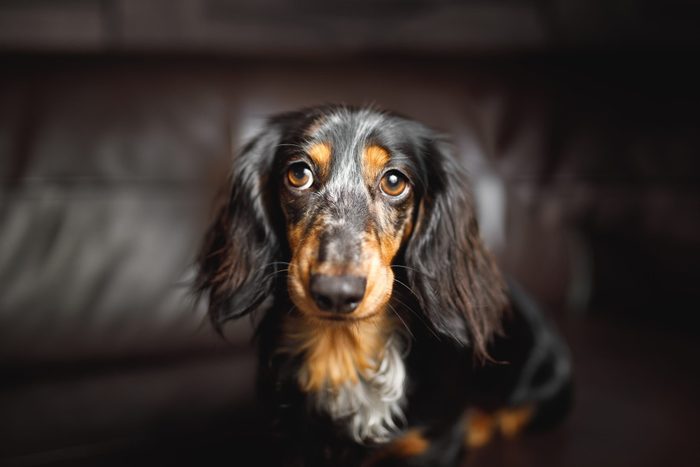
Do dogs have a sixth sense?
“The sensory ability of dogs, at least in the realms of smelling and hearing, are well beyond those of humans,” says Coren, which may lead some owner to believe their dogs have a sixth sense. We do know that dogs can sense many things we can’t. They can hear high-frequency sounds we can’t, smell an entire world of odors we can’t and see in the dark and detect slight movements we can’t see. Dogs have even been shown to react to the earth’s magnetic field and some can sense impending seizures in their person.
Can dogs see things we can’t?
The human and canine visual worlds are very different. Dogs can’t see the spectrum of colors humans can and have poorer vision for details. But they can see in the dark far better than we can, because their eyes are built to gather more light through their larger cornea and lens, to let more light in through their larger pupil, to detect more light with their greater abundance of light-sensitive cones, and to reflect light that gets past them for a second chance of detection by means of a mirror-like structure at the back of the eye. When you’re out at night tripping over lawn furniture your dog is nimbly galloping and jumping, wondering what is wrong with you. Dogs can also detect flickering light at a much faster speed than we can.
Can dogs sense bad/good energy?
From a scientific point of view, dogs can smell when people are nervous, and even detect when they are lying by sniffing their sweat on their clothing. So in that sense, yes. From a paranormal view, assuming they can sense energy, then yes again, they could pick up on good vibes versus bad vibes, but again, the answer is subjective.
Sources
- Alexandra Horowitz, PhD, senior research fellow and adjunct associate professor at Barnard College and author of Inside of a Dog: What Dogs See, Smell and Know; email interview on April 2, 2024
- Jesus Aramendi, DVM, former senior veterinarian for Chewy and founder of FurLife Vets in Delray Beach, Fla.; interview March 2022
- Stanley Coren, PhD, professor emeritus in the Department of Psychology at the University of British Columbia and an adjunct professor at Bergin College of Canine Studies. He’s the well-known author of several books about dogs, including Gods, Ghosts and Black Dogs; email interview on April 4, 2024
- RealClear Opinion Research Poll
- Charles Peden, psychic medium and animal communicator; phone interview on April 4, 2024
- Ecology: “Magnetic alignment enhances homing efficiency of hunting dogs”
- PLOS ONE: “Dogs can discriminate between human baseline and psychological stress condition odours”
Are you excited about the arrival of some furry bundles of joy? Or maybe you’re worried because you’ve noticed a few changes in your dog’s behavior and your girl’s gotten a little wide in the middle. I’ve been a veterinarian for more than 25 years, and I’ve helped more pet parents than I can count navigate the sometimes turbulent waters of their dogs’ pregnancies. So you’re in the right place to get the answers to your dog-pregnancy questions, including: How long are dogs pregnant?
In my experience, knowing when puppies are due can make a big difference between enjoying the thrill of your dog giving birth or having it be an incredibly stressful time for everyone involved. Being prepared is vital, because it’s important for a dog’s labor to be monitored, and if problems pop up, you can call your veterinarian for advice. Even more dramatically, some dogs, like English bulldogs, should only give birth via C-section. These surgeries need to be scheduled during that small window of time when the puppies can survive outside the womb but the mom’s labor hasn’t started on its own.
Ahead, I’ll answer the question of how long it takes a dog to have puppies, as well as walk you through the stages of a dog’s pregnancy. Here’s everything you need to know.
Get Reader’s Digest’s Read Up newsletter for more pets, cleaning, humor, travel, tech and fun facts all week long.
| Reviewed for accuracy by: Amy Attas, VMD, an award-winning veterinarian, the founder of City Pets and the author of Pets and the City: True Tales of a Manhattan House Call Veterinarian. |
How long are dogs pregnant?
Dogs are usually pregnant for around nine weeks, and canine pregnancies follow a trimester pattern that’s similar to human pregnancies—but over the course of weeks instead of months. Of course, every dog (not to mention every pregnancy) is a little different, but big dogs generally have slightly longer pregnancies than small dogs.
The most accurate way to measure a dog pregnancy is in days, but you need to know when to start counting. Dog pregnancies can last anywhere from 57 to 72 days, with the average being around 63 days (or two months). For this kind of accuracy, you’d consider the first time a dog mates during her heat cycle as day one. If you know when your dog’s heat cycle ended, you can narrow things down even further: She will probably give birth 56 to 58 days later.
What are the signs that a dog is pregnant?
If you’re wondering whether your dog is pregnant, there are some telltale signs you can look for, both in their behavior and their bodies. That said, these early signs are very easy to miss, so you may not be aware that anything is going on until a few weeks before your dog gives birth. Talk to your veterinarian if there is any chance that your dog could be pregnant; they can also help you determine how far along she might be.
- 3 weeks pregnant: Poor appetite and possibly some vomiting are often the first signs that a dog is pregnant. This usually lasts for just a few days.
- 5–7 weeks pregnant: The dog’s nipples get larger and darker, and the hair around them may thin. Her belly will also get rounder (and may eventually hang lower to the ground).
- 8–9 weeks pregnant: The dog will engage in nesting behavior—either by digging or gathering blankets, pillows, clothes and paper in a quiet location.
- Early labor: The dog will start pacing and panting. Some dogs get clingier, but most want to be by themselves.
These signs can vary from dog to dog. For example, a large dog that is carrying only a few puppies probably won’t look too big, while the belly of a small, thin dog having a large litter can be enormous.
One caveat: All female dogs go through the hormonal changes associated with pregnancy after their heat cycle, even if they are not pregnant. This can make dogs look like they’re carrying puppies when they are not. And while the physical and behavioral changes can sometimes be mild, they can also be very convincing—with a non-pregnant dog sometimes even experiencing what appears to be labor! The best way to know whether your dog is pregnant is to schedule an appointment with a veterinarian, who can perform an ultrasound exam about four weeks after mating has occurred.
How long are dogs in labor?
The answer depends on how many puppies are going to be born and how fast the labor progresses. Starting from the very beginning of labor, anywhere between 12 hours and two days could be normal. Understanding the three stages of labor is key.
Stage 1
As labor begins, dogs will experience mild contractions, and the cervix will start to open to allow passage of the puppies. Dogs in stage 1 labor are often restless. They may pant, pace, tremble and work on their nest. Some dogs may vomit, and most have no interest in eating. You may also notice some clear, watery fluid emanating from your dog’s vulva. This stage of labor usually lasts between 12 and 24 hours.
Stage 2
Stage 2 labor is when the puppies arrive. You will see your dog actively pushing. Most of the time, one puppy will be born every 30 to 60 minutes. If more than two hours have passed between puppies, it’s time to call a veterinarian. Discharge may be clear, bloody or slightly green. Stage 1 signs often return between the arrival of puppies.
Stage 3
During stage 3, the dog will pass a placenta. Because each puppy has its own placenta, stage 2 and stage 3 labor should alternate. A puppy is born, followed by its placenta, and then another puppy and its placenta, and so on.
How many puppies can a dog have?
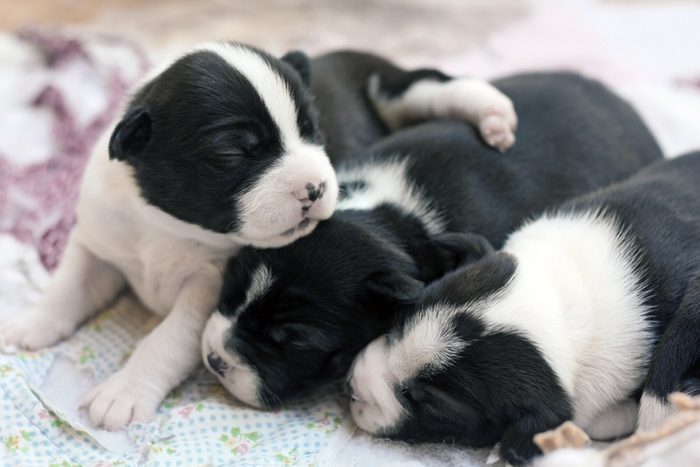
Normal litter sizes range from one to 12 puppies, although larger litters are certainly possible. Bigger and younger dogs tend to have larger litters than smaller and older dogs. It wouldn’t be unusual for a Chihuahua to have a litter of just one or two puppies, while the Guinness World Record holder is Tia, a Neapolitan Mastiff who had 24 puppies in a single litter in 2004.
It’s important to schedule X-rays seven or eight weeks into your dog’s pregnancy so your veterinarian can tell you exactly how many puppies to expect. This lets you know if your dog is done giving birth or if labor has stalled and you need to call your vet for help.
In how many months can a dog get pregnant again?
On average, dogs have a heat cycle every six months, so they can get pregnant about four months after giving birth. This means that dogs typically can get pregnant twice a year. However, a dog’s size plays a big role in this. Small dogs may go through a heat cycle three times a year (every four months), while large dogs and certain breeds like the Basenji often have only one heat cycle each year.
If you do the math, dogs can theoretically have 10 or more litters over their lifetime, but this is usually not in their best interest. After all, being pregnant and raising puppies through weaning is hard work: A dog’s need for energy (calories) goes up by 60% in late pregnancy and can increase by 200% to 400% when they are nursing a litter of puppies. Older dogs are also at a higher risk for having their own health problems, which could make pregnancy and delivery a riskier proposition. Good breeders often limit their dogs to three to five litters, after which the dogs can enjoy their retirement years.
What is the oldest age a female dog can have puppies?
Dogs do not go through menopause, so they can continue to have puppies well into their senior years. However, pregnancies tend to become more difficult and litters tend to be smaller after dogs are 5 to 7 years of age. This is a reasonable time to stop breeding. Except under special circumstances, the American Kennel Club will not register puppies that have been born to dogs who are more than 12 years old at the time of mating.
What is the youngest age a female dog can get pregnant?
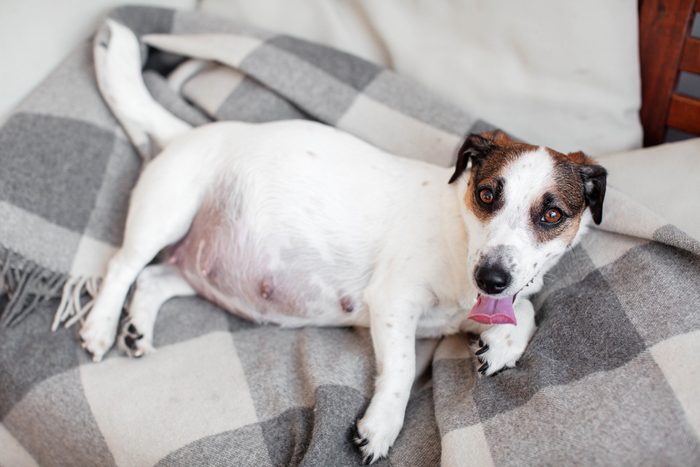
Smaller dogs usually start having heat cycles when they are between 6 and 12 months of age, and it’s possible for these dogs to become pregnant as soon as that happens. Larger breeds, on the other hand, may not have their first heat until they are 12 to 18 months old and aren’t able to get pregnant until they do. If you don’t want your dog to become pregnant, it may be best to schedule a spaying appointment before their first heat. Talk to your veterinarian about the optimal timing for your dog.
Dogs should never have to deal with the demands of pregnancy and caring for a litter while they are still growing and developing themselves. They may simply not be able to take in enough nutrition to fuel their own bodies and also provide what their little ones need, leading to nutritional deficiencies for both. Breeders typically wait at least until a dog’s second heat cycle before they will allow her to become pregnant.
FAQs
Can you tell if your dog is pregnant at home?
You can order a dog pregnancy test online, but keep in mind that it is only accurate after a dog has been pregnant for four weeks. It also may not pick up very small litters. You can, however, look for signs that your dog might be pregnant, including her nipples becoming larger and darker and her belly getting bigger. However, as noted earlier, all female dogs can experience similar symptoms after their heat cycles, so this isn’t a reliable gauge of pregnancy.
Do dogs get pregnant every time they mate?
Healthy dogs typically become pregnant after mating. One study found that under certain circumstances, 95% of breedings were successful. The best way to know for sure if your dog is pregnant is to have your veterinarian perform an ultrasound exam about four weeks after the mating.
Do dogs know they’re pregnant?
It’s impossible to know if dogs understand the reason behind the changes they go through when they are pregnant. Are their behaviors instincts or evidence of a deeper understanding? We may never know enough to consider this a dog fact, but once the puppies are born, there’s no doubting the attachment that forms between the mom and her babies.
What does nesting look like in dogs?
Dogs that are nesting typically gather soft items like blankets, pillows, towels, clothing and paper products in an out-of-the-way location. Then, they will arrange (and rearrange) them to their liking. One word of warning: Dogs may rip up their bedding material to make everything just right for them, so make sure they have access to things you don’t mind throwing out after the nest is no longer needed.
Why trust us
At Reader’s Digest, we’re committed to producing high-quality content by writers with expertise and experience in their field in consultation with relevant, qualified experts. For this piece, Jennifer Coates, DVM, tapped her experience as a veterinarian with more than 25 years of experience, and then veterinarian Amy Attas, VMD, founder of City Pets and author of Pets and the City: True Tales of a Manhattan House Call Veterinarian, gave it a rigorous review to ensure that all information is accurate and offers the best possible advice to readers. We verify all facts and data, back them with credible sourcing and revisit them over time to ensure they remain accurate and up to date. Read more about our team, our contributors and our editorial policies.
Sources:
- Cornell Richard P. Riney Canine Health Center: “Dog estrous cycles”
- Theriogenology: “Semen evaluation and fertility assessment in a purebred dog breeding facility”
- Dvm360: “Optimizing pregnancy rates (Proceedings)”
- Merck Veterinary Manual: “Management of Reproduction: Dogs and Cats”
- Guinness World Records: “Largest Litter of Dogs”
When you’ve been a veterinarian for as long as I have (25 years and counting!), you get good at seeing a dog’s point of view. As you learn various dog facts, you start to understand what makes dogs tick, as well as which physical features play a huge role in their daily lives. Whiskers check both of those boxes, and this is why I hate the thought of a dog’s whiskers being trimmed—or worse, plucked. If people knew how important they were to a dog, they’d leave them alone. So why do dogs have whiskers? There are a few reasons, and none of them have to do with a dog’s looks!
Ahead, you’ll learn the reasons dog whiskers exist and gain a newfound appreciation for this undervalued part of a dog’s anatomy, just like I once did.
Get Reader’s Digest’s Read Up newsletter for more pets, humor, cleaning, travel, tech and fun facts all week long.
Do all dogs have whiskers?
Yes! Dog whiskers are so important that all dogs have them, including hairless dog breeds. And while newborn puppies have just the lightest covering of fine fur, they still have whiskers. In short, all dogs have whiskers (officially called vibrissae or tactile hairs) for their entire lives, though their number and length can vary from breed to breed and from individual to individual.
And whiskers don’t just grow around a dog’s muzzle. They’re strategically located all around a dog’s face:
- Mystacial whiskers are found on both sides of a dog’s muzzle.
- Genal whiskers are farther back, on the cheeks.
- Superciliary whiskers (also called supraorbital whiskers) are located above a dog’s eyes.
- Interramal whiskers grow from a single mole under the chin.
Why do dogs have whiskers?
Whiskers are important sensory organs for dogs. Yes, you read that right: They’re actually considered organs. They grow from special follicles that have many more nerve endings than the regular follicles associated with fur, which makes whiskers extremely sensitive. So what do dog whiskers do, exactly? Think of how you use your fingertips when you need to get the most out of your sense of touch—whiskers do the same thing for dogs. And that’s just the beginning of their uses, as you’ll see below.
They protect a dog’s face
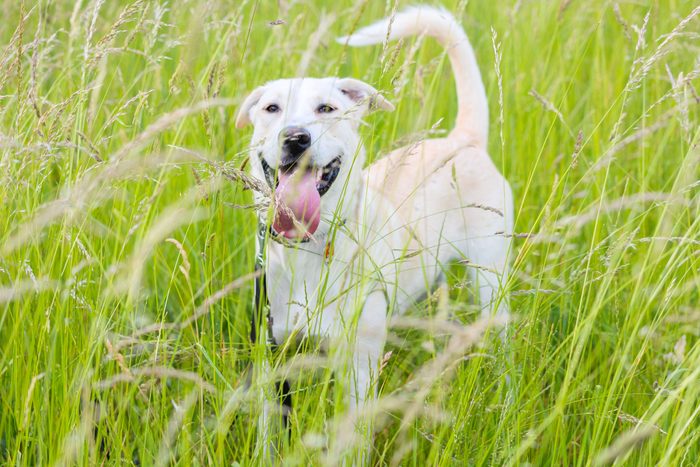
Often, a dog’s face is the first part of their body that encounters danger. When a dog runs through tall grass, sticks its head down a hole or peers around a corner, delicate facial structures like its eyes, nose and lips are in harm’s way. The placement of whiskers all around the face allows a dog to sense when something potentially dangerous is close by and react accordingly.
They let dogs “see” things that their eyes can’t
Dogs have a limited range of vision around their faces. For instance, anything below their muzzle is invisible to them. This is where that tuft of whiskers below their chins comes into play. When a dog lowers its head, those long whiskers will hit any objects in the area and warn them of potential dangers their eyes can’t see. The long whiskers over their eyes play a similar role.
They help when it’s dark
Dogs have better night vision than we do, but whiskers still help them sense their surroundings when it’s dark. For example, a dog should have no problem finding its water bowl at night (unless it’s been moved!), but whiskers will help it get its mouth dead center rather than banging it into the side of the bowl.
Here are two more examples: A newborn puppy’s eyes remain closed for one to two weeks, so it’s always dark for them. Whiskers help puppies navigate their way around their den, like when they need to find their mom’s nipple to eat. And whiskers are so important to blind dogs that researchers are actually investigating whether giving them whisker extensions will help them stay safer as they make their way through the world.
They sense air currents
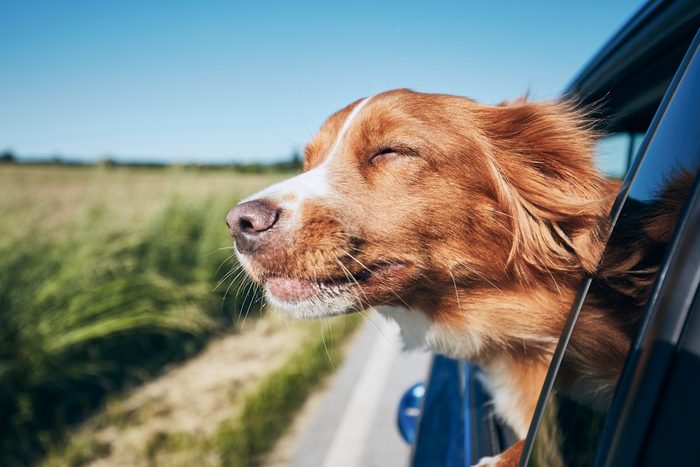
Dog whiskers are so sensitive that they don’t even have to contact an object for a dog to become aware of it. Dogs can use their whiskers to sense how air currents change in relation to nearby objects, people or animals, giving them an idea of their size, shape and location, as well as if they are moving. The array of whiskers around a dog’s face has a lot in common with a radar dish or telescope that is collecting information.
They help convey a dog’s emotional state
In addition to being important sensory structures, whiskers help dogs communicate their emotions through facial expressions. The whiskers of a completely relaxed dog will usually rest close to its face, which can be considered their neutral position. In contrast, a happy or inquisitive dog will often move the whiskers over its eyes up and forward, much like horses prick their ears toward something they find interesting. And a scared dog may hold the whiskers around its muzzle out in a defensive position toward whatever is worrying it.
What happens if you cut off a dog’s whiskers?
When you cut off a dog’s whiskers, you make it harder for them to sense the world around them and lessen their ability to communicate emotions. It’s like trying to close a delicate clasp with gloves on or get a read on someone who is wearing a mask.
That being said, cutting off whiskers is not painful for dogs. The nerves associated with whiskers are in the skin follicle, not in the whisker itself. Groomers often cut dog whiskers when they are trimming long-haired dog breeds. However, you can certainly ask your groomer to avoid cutting your dog’s whiskers as much as possible, and you can do the same if you groom your dog at home.
On the other hand, it is extremely painful to a dog if you pluck its whiskers. Never (ever!) do that.
Do dog whiskers grow back?
Whether they were cut off or fell out naturally (this happens just like with other hairs on a dog’s body), dog whiskers will eventually grow back as long as the follicles are healthy. It can take two to three months for a whisker to regrow, however.
Is it OK to touch a dog’s whiskers?
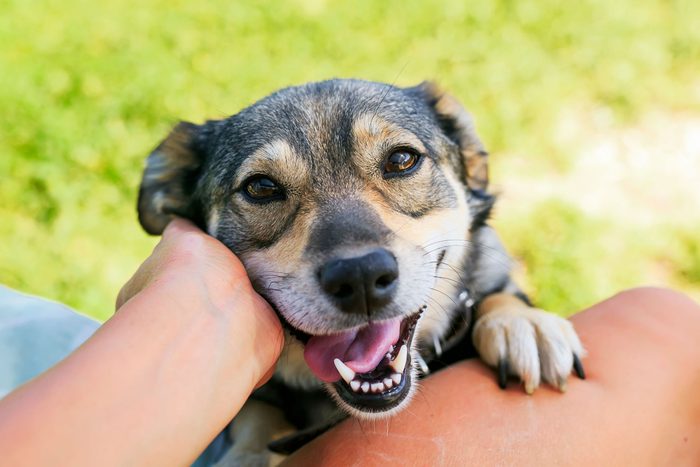
Since dog whiskers are super sensitive, you should handle them gently. If you are petting a dog around its face, always stroke in the direction that its whiskers lie—smoothing them against the face. And never pull or twist a dog’s whiskers.
Finally, let your dog tell you whether it likes having its whiskers touched. If your pup flinches or moves its head away, your dog is annoyed and asking you to stop.
Why trust us
At Reader’s Digest, we’re committed to producing high-quality content by writers with expertise and experience in their field in consultation with relevant, qualified experts. For this piece on why dogs have whiskers, Jennifer Coates, DVM, tapped her experience as a veterinarian with more than 25 years of experience, and then veterinarian Amy Attas, VMD, founder of City Pets and author of Pets and the City: True Tales of a Manhattan House Call Veterinarian, gave it a rigorous review to ensure that all information is accurate and offers the best possible advice to readers. We verify all facts and data, back them with credible sourcing and revisit them over time to ensure they remain accurate and up to date. Read more about our team, our contributors and our editorial policies.
Sources:
- Tierärztliche Praxis Kleintiere: “The importance of the tactile hairs in domestic dogs and the problem of trimming these from an animal welfare perspective”
- Veterinary Research Communications: “Supplemental vibrissal extensions as an alternative to improve the tactile sensitivity of blind dogs – a preliminary approach investigation”
When my husband and I adopted our first dog in 2010, we never asked ourselves the question, “Why do dogs bark?” Instead, we spent time wondering whether our dog would ever let out a woof. Rio, a Labrador retriever mix, didn’t bark for the first several months in our home. We even wondered if he was part basenji, known as the “barkless dog.” Then one night as we were sleeping, a mighty woof sounded throughout the house. It turned out that Rio was having a little stomach upset and barked to let us know. Though initially startled, we appreciated him giving us a heads-up that he needed to go outside to do his business. A decade later, when arthritis prevented him from climbing stairs, he’d rest on a bed at the base of the stairwell and bark to let us know he wanted company.
Our newest member of the pack, a Yorkshire terrier mix, does not save barking for special occasions. Tux loves to race along the fence line, barking at passersby. He barks when the doorbell rings. He barks at random dogs on leashed walks. Sometimes he even lets out little yips in his sleep. Clearly, Yorkies are not a quiet dog breed.
While some dogs may bark more than others, barking is a normal part of dog behavior and an important way that they communicate, according to veterinarian Nicholas Dodman, BVMS, co-founder of the Center for Canine Behavior Studies. While it might seem like dogs bark for no reason, “it’s always related to something,” he says. “It signals different things.”
Ahead, veterinarians, dog behaviorists and dog trainers explain why dogs bark and how to stop your dog from barking quite so often. Read on for help translating this common doggy language.
Get Reader’s Digest’s Read Up newsletter for more pets, humor, travel, tech and fun facts all week long.
About the experts
Reviewed for accuracy by: Wailani Sung, DVM, a vet with a board certification in veterinary behavioral medicine who owns Bay Area Vet Behavior. Dr. Sung is the co-author of From Fearful to Free: A Positive Program to Free Your Dog from Anxiety, Fears and Phobias. |
What does it mean when a dog barks?
Veterinarian Andy Roark, DVM, host of the podcast The Cone of Shame, says we can better understand why dogs bark by imagining what it would be like if humans could not speak and our primary communication tool was a horn. “You can’t speak, you can’t make elaborate hand gestures, you can’t do anything except honk this horn,” he says. “Think about how you would use that horn.”
Chances are, you’d use that horn much like our four-legged pals use their voices. Keep reading to find out the top reasons why dogs bark.
They’re bored
If a high-energy dog is locked in a crate while its humans are at work, it’s probably going to bark either to pass the time or to summon someone to release it. “Boredom is hard on people. We whip out our cell phones and start scrolling,” says Dr. Roark. “Our dog doesn’t have a cell phone. They’ve just got this ‘horn.'”
They’re protecting their territory
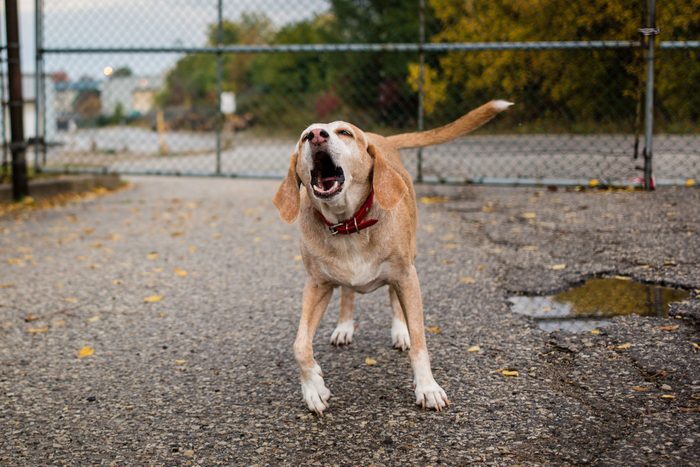
Barking an alert—aka territorial barking—has long been ingrained in dogs. It’s one reason why some people still consider the top guard dog breeds when choosing a pet. “Fifteen thousand years ago, when human beings were sitting around a fire, dogs were lying on the periphery. If anything rustled in the bushes, the dog would start barking,” says Dr. Dodman. “That was a useful warning of approach by a different tribe or some dangerous wild animal. Of course, we don’t have the campfire and the wild animals so much these days, but you will notice that dogs will bark in the house when the mailman comes.”
They’re fearful
Why do dogs bark when fireworks burst in the sky or thunder booms overhead? For the same reason they bark at other dogs on walks: They’re afraid. “When a dog is frightened, he has the opportunity for fight or flight,” Dr. Dodman says. “But when you’re on a leash, you can’t run away.”
They’re excited
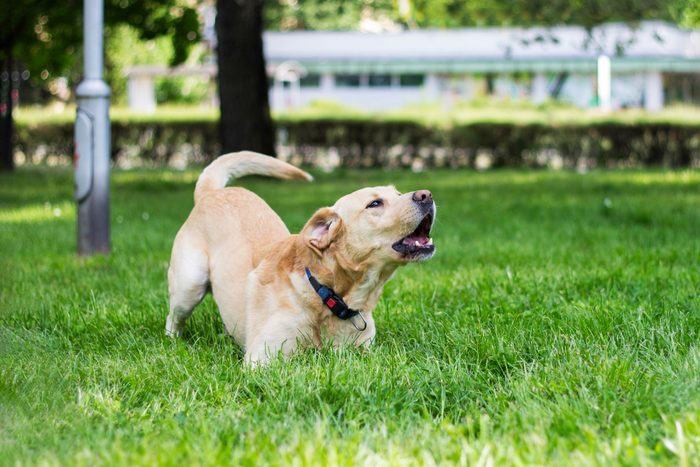
In contrast to a fearful dog, an excited dog barks during the thrill of play with people and pets. Think of the adrenaline rush! People can confuse play barking and fear barking, so it’s important to pay attention to canine facial expressions and body language to avoid a bite, according to Dr. Dodman.
“With play, the mouth gives a lot away: It’s usually open, and the tongue may be falling out the side. The ears are not pinned back—or forward—and the tail may be wagging,” he says. “With fear, it could be that the jaw is clamped tight, the tail may be somewhat tucked and the hackles will be raised. The dog may be looking tense and/or backing away, and [it may be] barking with a lower tonality, more threatening and warning.”
They want something
There’s a long list of what dogs want—yours might bark because it wants attention, food, a walk or a game of fetch. When we respond by giving them what they want, it reinforces that behavior.
For instance, Dr. Roark’s dog, Skipper, expects dinner every evening at 5:50 p.m. and barks if Dr. Roark loses track of the time. Sometimes Skipper tries to push his luck and barks early at 5:30 p.m. “I don’t respond to his bark then because if I do, he will simply push dinnertime earlier,” he says with a laugh.
They have separation anxiety
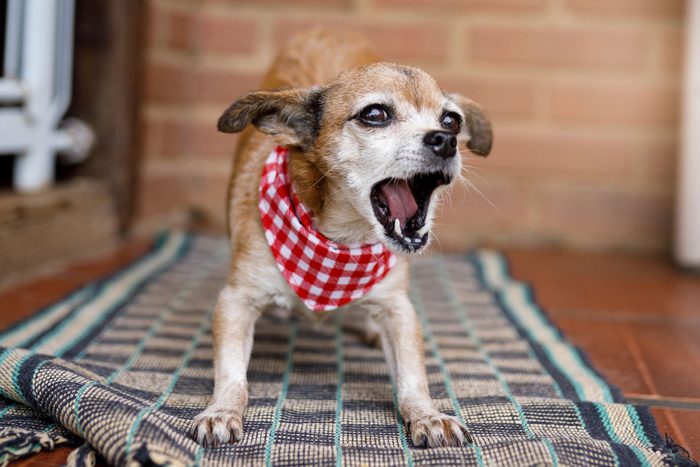
When left alone, dogs with separation anxiety might destroy furniture, stop eating, urinate indoors … and bark incessantly, as research published in the journal Applied Animal Behaviour Science shows. “There are about 10 different signs of separation anxiety, but one of the key signs is barking really continuously or for long periods of time when they’re left alone—much to the dismay of neighbors, especially in an apartment situation,” Dr. Dodman says.
There’s a medical issue
“If they’re yipping or vocalizing as they’re getting up or laying down, I’m worried about back pain, hip pain, things like that,” Dr. Roark says. “Is there something that’s causing them to cry out from their movements? I would be very aware of that.”
Why do dogs bark when they’re not feeling well? They have few ways to tell us, “I’m in pain!” So it’s important to pay attention to how and why your pooch is communicating.
Unusual barking in senior dogs can also indicate the onset of dog dementia, Dr. Roark adds. If you’re concerned about the noises your dog makes, contact your veterinarian.
How to prevent or stop unwanted barking
While some pet parents train their dogs to bark on command, many others wish their dogs weren’t quite so noisy. Fortunately, there are ways to address a dog that barks too much once you’ve figured out why it’s barking.
Offer enrichment
“We need to make sure their physical and mental needs are being met,” says certified professional dog trainer Nicole Ellis, CPDT-KA. For instance, if a dog is a fan of “demand barking” whenever it’s bored, take a long walk before a Zoom meeting and offer it a puzzle feeder or a Kong stuffed with canned dog food and then frozen. One of Ellis’s dogs, Rossi, will work on a frozen Kong for over an hour while Ellis works.
Redirect your dog
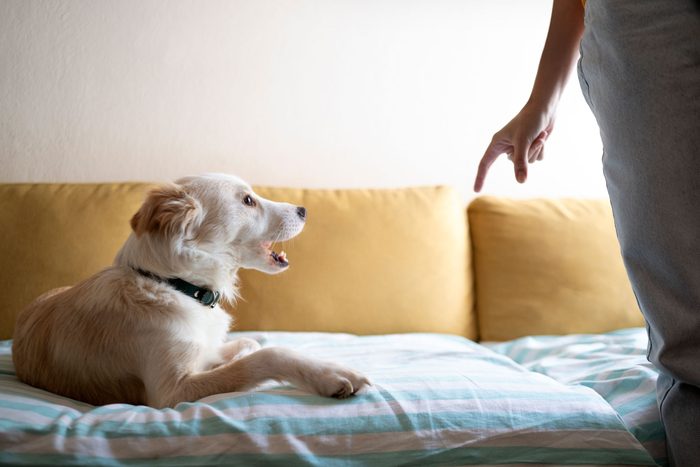
“When guests come over and your dog is barking with excitement, redirect them and ask them to sit, and reward that,” Ellis suggests. If your dog likes to bark every time it sees cats, practice the cue “come” with your dog. Then, whenever a cat saunters by, call your dog and reward it for coming by offering praise and a delicious treat, like chicken.
Erect visual barriers
If your dog barks whenever another dog walks past the window, simply close the curtains or blinds. You can also buy film that makes windows look foggy. “We add a little barrier so our dogs cannot just stare out the window and see these things that are really exciting for them,” Ellis says.
You can also create a sound buffer for outside noise by playing reggae or classical piano music, turning the TV to a calm station like the Weather Channel or using a white noise machine, she adds.
Ignore attention-seeking barking
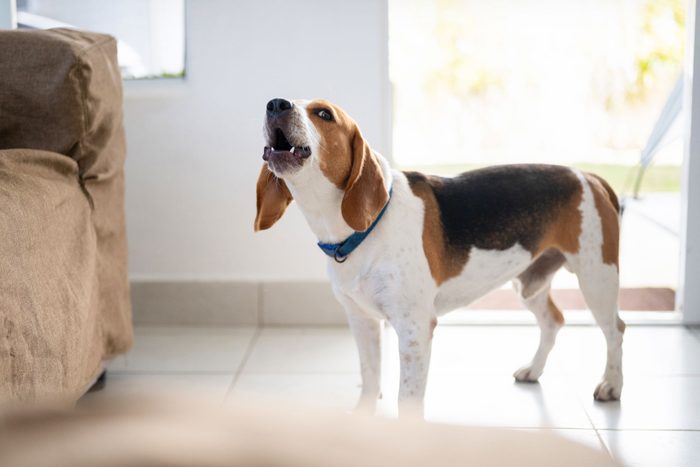
A couple once asked Dr. Dodman for help with their Labrador retriever, who barked whenever they were having an in-depth conversation with each other. They dealt with it by giving the dog a “time out” in their truck—but the dog loved being in the truck and considered it a reward, so he kept barking to interrupt their conversations.
“You can eliminate attention-seeking barking by completely ignoring it: You continue what you’re doing. You don’t pay the dog any attention until the barking stops,” Dr. Dodman says. “Initially the dog will increase the intensity—it’s called an ‘extinction burst’—but if you can persist, after one week, the attention-seeking barking will be about 50% reduced. … After three weeks, it will be completely gone because it doesn’t work anymore.”
Practice triggering scenarios at home
For dogs that react to other dogs by barking, try playing YouTube videos of dogs (on a low volume) for your pup. “When he doesn’t bark, reward him,” Ellis says. You can also record a doorbell ringing on your cell phone and play that (again, at a low volume) and reward your dog for looking but not reacting.
Stay positive
Don’t yell or hit your dog if it barks too much. “With barking, it’s easy to become overly frustrated. It can be embarrassing and simply annoying,” Ellis says. “But it’s important to keep your cool because [when we get] frustrated, our dogs might actually start barking more. And we can create other problems if they become nervous with how we handle the situation, which can lead to reactivity and other problems.”
Get professional help when necessary
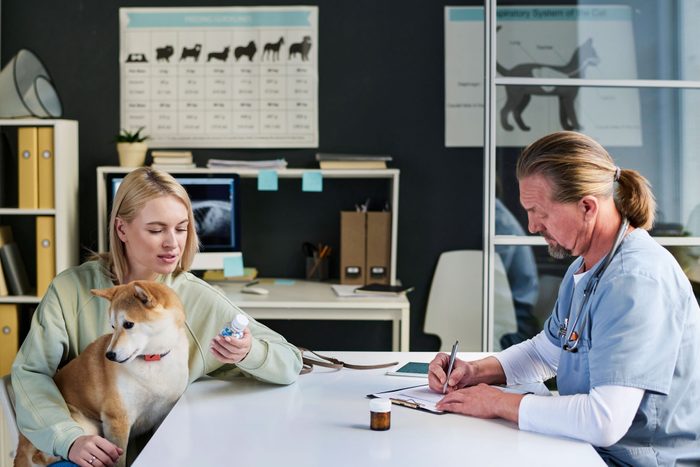
If your dog seems to bark because of stress and anxiety, Ellis recommends talking to a veterinarian. They might prescribe medication or recommend a pheromone diffuser to help your dog relax.
If your dog seems like one of the hardest dogs to train, a positive-reinforcement dog trainer can also help develop custom strategies for your pup.
Why trust us
At Reader’s Digest, we’re committed to producing high-quality content by writers with expertise and experience in their field in consultation with relevant, qualified experts. For this piece, Jen Reeder tapped her experience as a longtime pet journalist and former president of the Dog Writers Association of America, and then Wailani Sung, MS, PhD, DVM, DACVB, a board-certified veterinary behaviorist who owns Bay Area Vet Behavior, gave it a rigorous review to ensure that all information is accurate and offers the best possible advice to readers. For this piece, we relied on reputable primary sources, including professional organizations and published research studies, as well as our writer’s personal experience. We verified all facts and data and backed them with credible sourcing, and we will revisit them over time to ensure they remain accurate and up to date. Read more about our team, our contributors and our editorial policies.
Sources:
- Nicholas Dodman, BVMS, DACVAA, DACVB, professor emeritus at Tufts University, co-founder and CEO of the Center for Canine Behavior Studies and author of several books, including The Well-Adjusted Dog and If Only They Could Speak; phone interview, Feb. 28, 2024
- Andy Roark, DVM, MS, founder and CEO of the Uncharted Veterinary Conference; phone interview, March 1, 2024
- Nicole Ellis, CPDT-KA, Fear Free certified dog trainer and author of Working Like A Dog; phone interview, Feb. 29, 2024
- Applied Animal Behaviour Science: “Video analysis of dogs with separation-related behaviors”
When it comes to dogs, there’s fluff, and then there’s fluff. Certain dog breeds have dense coats that seem to go on fur-ever, giving them a certain bear-like appearance. And the similarities to bears don’t end there—some have blacks masks or button eyes (we’re looking at you, Samoyeds), and one breed even runs like a bear. It’s enough to make you wonder if these dogs that look like bears used to hibernate in a past life!
As cute as they are, bear-like dogs aren’t suited for every household. Apart from a few pint-sized exceptions (which we’ve included on our list), these dogs look like bears partly because they’re big—in some cases, really big, weighing in at more than 100 pounds. So despite some of them being among the most popular dog breeds, they might not be suited for apartment living or small yards, and some of them need vigorous daily exercise. Most of them are also major shedders and need regular brushing and grooming to keep their coats clean, healthy and odor-free. And virtually all of them were bred for cold climates, so they don’t do well in hot weather, according to the American Kennel Club (AKC).
But if you think you’re ready for a bear-alicious buddy (or just want to enjoy a few adorable pictures), take a look at these dog breeds that look like bears. Ahead, you’ll find out everything you need to know about them—from what they were bred for to what they’d be like snuggling up in your home!
Get Reader’s Digest’s Read Up newsletter for more pets, cleaning, humor, travel, tech and fun facts all week long.
1. Great Pyrenees
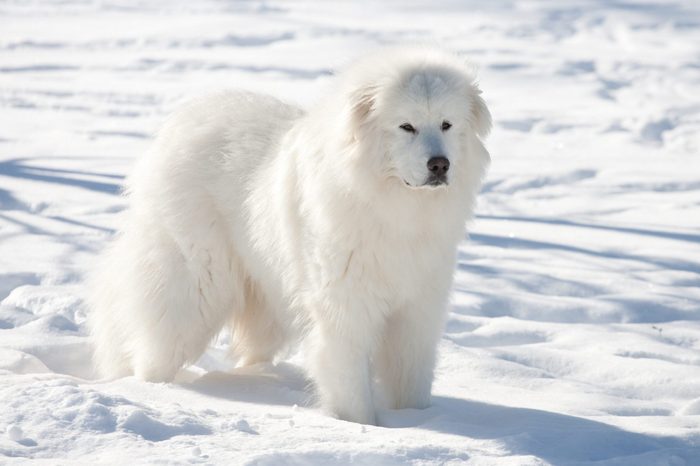
These super furry white dogs are gentle giants—unless one of their flock is threatened. Bred to blend in and protect herds of sheep, the breed developed in the Pyrenees Mountains that divide France from Spain. But experts believe that these fluffballs may have originally migrated with herders from Asia Minor, arriving on the European continent around 3000 BCE. Today, these moderately active dogs are content with a nice walk and a cool place to chill out. Their coats naturally resist dirt and tangles, but they do need brushing a few times a week. They also will need a shedding “blowout” a couple of times a year, so get the vacuum cleaner ready!
Pyrs, as they’re called by their fans, are smart, affectionate, good with kids and highly loyal to and protective of their families. But due of their size—100 pounds and up for males; 85 and up for females—they need ample space to splay on the floor, so they aren’t ideal for apartment living. And because of their thick, double coats, they aren’t suited to hot climates.
2. Chow chow
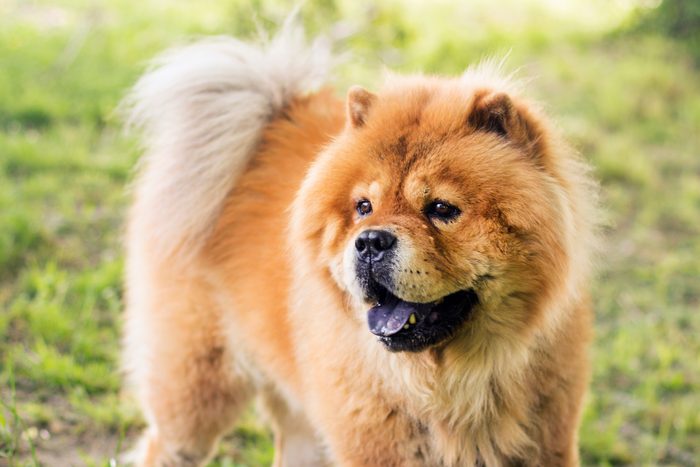
Perhaps the beariest of dogs that look like bears, rough-coated chow chows are sturdy bundles of puff, with short noses, deep-set eyes and manes around their faces. Their double coats do shed a lot, so they need to be brushed a few times a week; the fur around their head and hindquarters is especially prone to matting if they’re not groomed regularly.
Originally bred as hunters and guard dogs in China, chows are thought to be one of the oldest dog breeds. Just be aware that they tend to be a bit aloof and wary, and they’re not always friendly with other dogs. For a well-socialized adult chow, be sure to introduce him as a pup to children and other dogs, and enroll him in obedience training. These furballs require a moderate amount of exercise, with very little running, and can adapt to city and apartment living.
3. Newfoundland
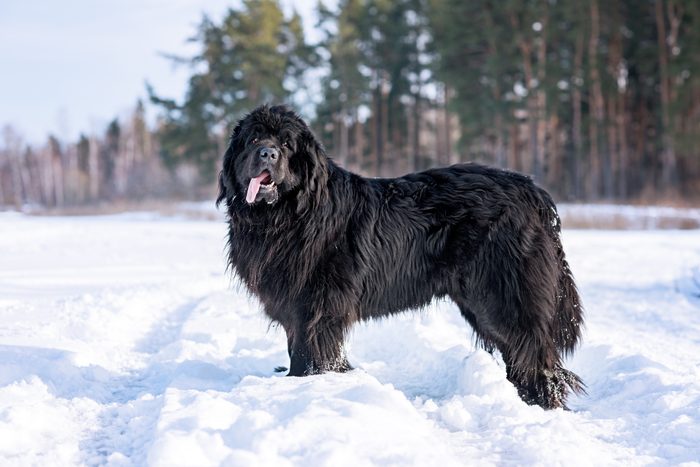
If you spot a bear swimming in a lake or at the beach and see his tongue hanging out, he may not be a bear at all—he may be a Newfoundland! Bred in Canada’s icy Newfoundland and Labrador province as maritime working dogs, Newfies were renowned for their fearlessness and lifesaving abilities. They were used in World War II as search-and-rescue dogs and were renowned for their ability to conduct waterborne rescues.
Today, these great companion dogs are instead famous for their sweet dispositions and love of children. They may wind up outweighing their owners, though! Considered a giant breed (males weigh between 130 and 150 pounds; females, 100 to 120 pounds), Newfies need room to spread out, a lot of human or animal company, moderate exercise and owners who are tolerant of shedding and drool—lots of drool. Oh, and they appreciate a swimming pool too.
4. Caucasian shepherd dog
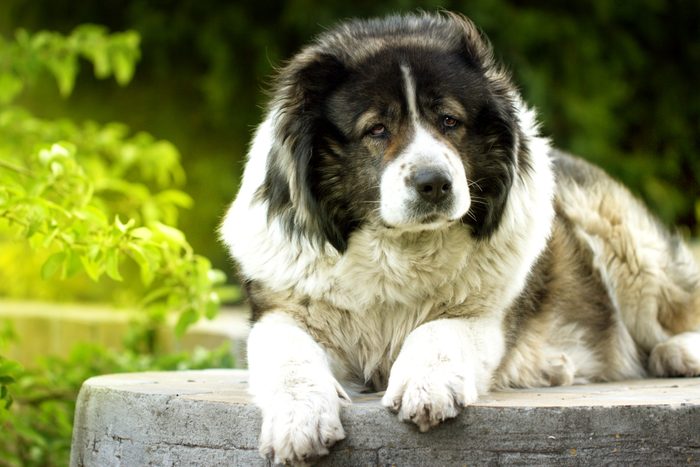
Also called the Caucasian Ovcharka or Russian bear dog, the Caucasian shepherd dog was bred as a fierce and fearless guarder of flocks in the Caucasus Mountains, which divide Europe from Asia. These days, you won’t find this giant breed fending off bears or wolves, but these dogs are still uber-protective of their households—to the point that they can be aggressive with strangers and animals.
Since male Caucasians can tip the scales at 170 pounds (!), early training and socialization are a must. Unlike these dogs that are good for first-time owners, Caucasian shepherd dogs require adept owners who can handle the breed’s impressive size, establish themselves as the leader and temper their protective nature. Also worth noting: Their double coats shed a lot and need to be brushed several times a week. These big boys (and girls) also drool quite a bit, so keep a towel handy and use silicone dog mats under their food and water bowls.
5. Samoyed
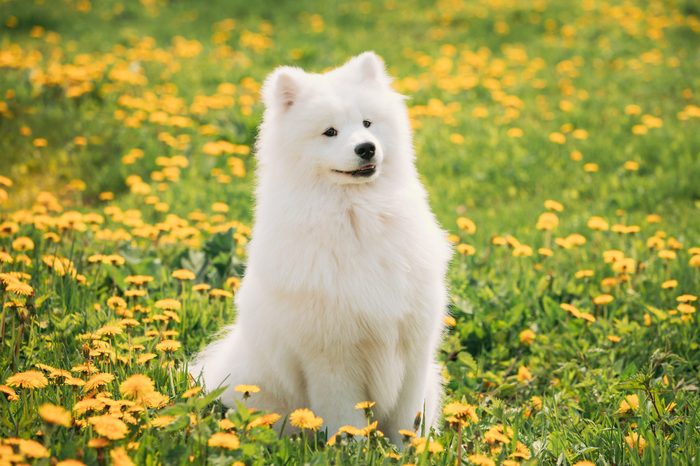
Sweet, fun-loving Samoyeds were bred in Siberia and the northernmost part of Asia to withstand some of the world’s coldest temperatures. Today, these medium-sized “polar bear dogs” do just fine in an air-conditioned home during the summer months. Sammies love their human family members, including children, and do not like being left alone for long periods of time—they’ll get quite barky when bored or lonely. And their trademark white, fluffy coat sheds pretty much all the time, so they need several brushings a week. But one look at that cute, “smiling” expression and you’ll forgive them for the extra work.
All in all, these medium-sized pups (they max out at 65 pounds, and females weigh less) are great family dogs—playful, affectionate and always ready to make new friends. The breed is generally quite healthy, but owners do need to watch out for hip and eye problems.
6. Pomeranian
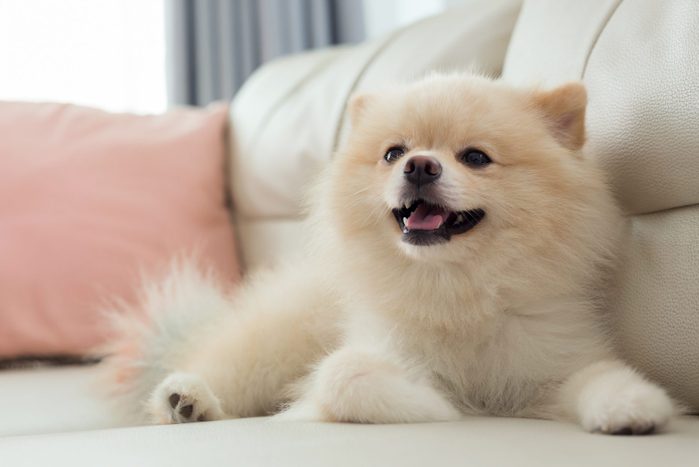
Does any living thing look more like a stuffed animal than a Pomeranian puppy? They’re even on our list of the cutest teddy-bear dogs, and their cuteness definitely doesn’t diminish as they mature. Generally lovable and friendly, Pomeranians love to play with a ball or squeaky toy in the house, but because of their dense double coat, they can’t stand long periods of exercise outdoors in hot weather. (The latter is true for most of the bear-like dogs on this list.)
While they love children, their petite size—they weigh just 3 to 7 pounds—means they may not be ideal for homes with rambunctious kids. Poms will probably do a seasonal shedding twice a year, but because they’re so small, it’s not that much hair. That said, their luxuriously fluffy, double coat needs to be brushed a few times a week or else it can get matted.
7. Keeshond
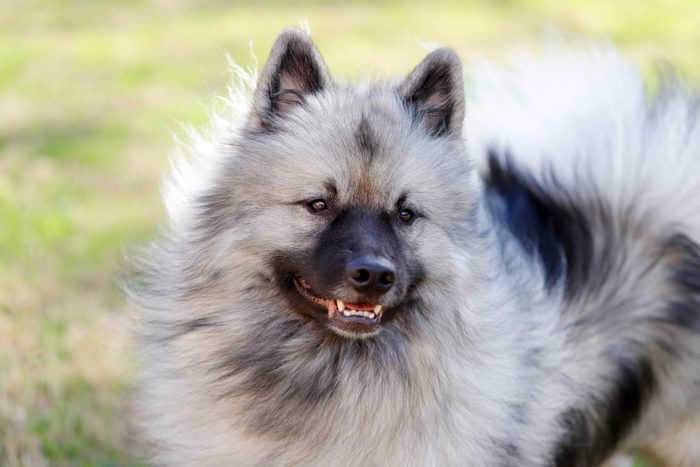
If you’re looking for a medium-sized bear-like dog breed that’s a loving companion and loyal family dog, the Keeshond checks all the boxes. These bundles of gray-, black- and cream-colored fur were bred as companion dogs for Dutch bargemen, and they take that role seriously to this day—they are delighted to spend time with their people and don’t like to be left alone for long periods of time. The AKC gives top marks to Keeshonden as terrific family dogs, since they’re great with kids and other dogs and they’re generally always up for a good time. They’ll adapt to apartment living, little kids and other pets, and as long as you promise to adore them and shower them with cuddles, you’ll have a loving friend for life. But these friendly pups are no couch potatoes: They have nonstop energy and need a lot of daily interaction. They do well with at least one or two brisk walks a day, room to romp and a collection of stimulating toys.
8. Eurasier
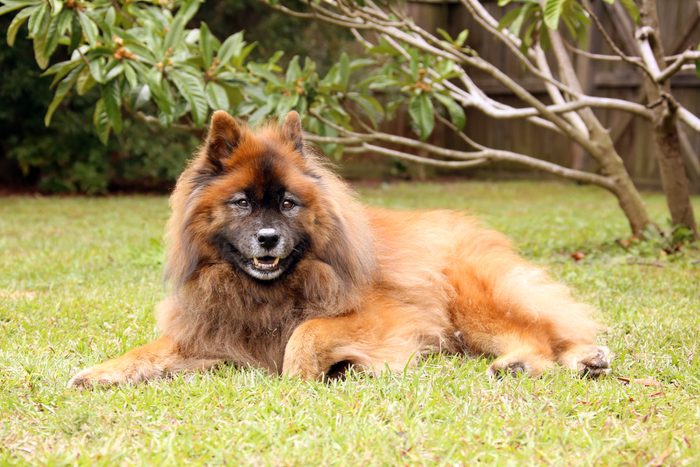
Similar in size to the Keeshond, the Eurasier also shares some of that breed’s qualities, including a bear-like appearance and a desire to be around their human family, though they may be somewhat reserved with strangers. Considered a purebred breed, Eurasiers weren’t developed until the 1960s and ’70s, when a dog enthusiast in Germany crossbred a chow chow and a wolf spitz. Today, Eurasiers are popular in Europe’s colder climates but are still among the rarest dog breeds in the United States.
These friendly fluffballs have double coats like their ancestors and will “blow” (or completely shed) their undercoats a few times a year, so expect frequent brushing, sweeping and vacuuming! While Eurasiers are generally healthy pups, owners do have to watch for hip and elbow displasia, as well as slipped kneecaps.
9. Tibetan mastiff
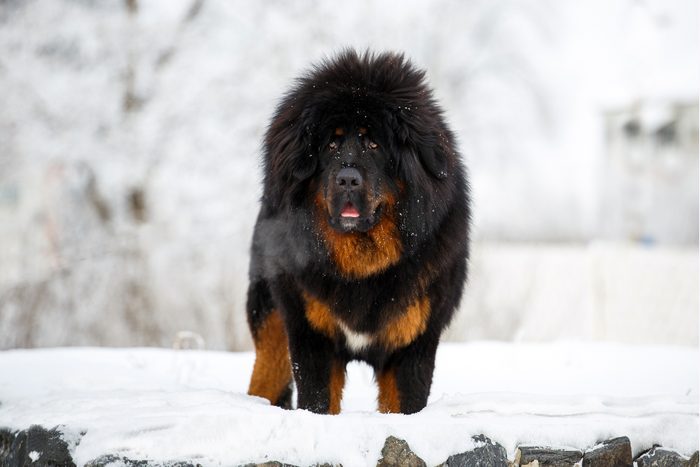
Do you want girth? Do you want fluff? Do you want a big dog that looks like a bear? We recommend the Tibetan mastiff, a bear-like dog originally bred as a watchdog in the high Himalayas that’s now just as happy to serve as a playful, protective family companion. Tall and stocky, Tibetan Mastiffs have a dense double coat that makes them look even heftier—though they do tip the scales at up to 150 pounds.
Just be aware that they are heavy shedders and need brushing a few times a week to keep their fur clean, so it’s a commitment. You’ll also want to check those furry paws at the door to prevent them from tracking in dirt. This is a breed made for cold climates, so it’s best to keep this puffy pal indoors during the hottest times of the day so as not to run the risk of overheating or heat stroke.
10. Finnish Lapphund
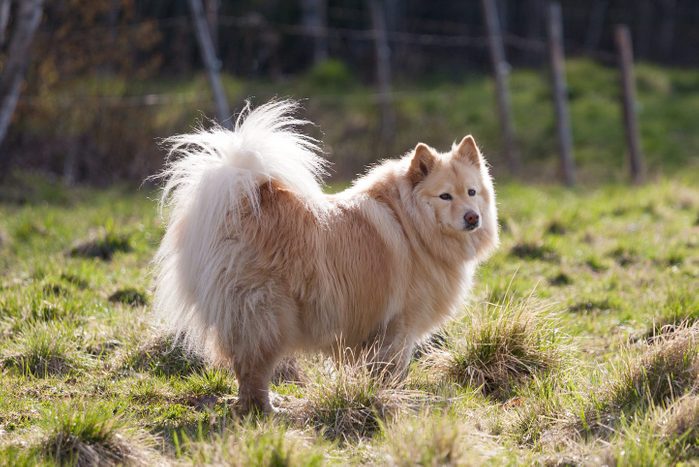
Bred to herd reindeer in Finland as far back as 7000 BCE, these medium-sized fluffsters (they average around 45 pounds) have taken to domestic life and are highly friendly, affectionate, adaptable family dogs. Their double coats shed nearly constantly, so be prepared for a lot of grooming and vacuuming. Another thing to know about Lappies: They bark—a lot—which was instrumental when they needed to get those reindeer moving. This makes them less suited to apartments or condos. Since they were bred for Arctic climates, they also do better in a cold-weather environments. The more snow for them to trounce through, the better!
11. Bernese mountain dog
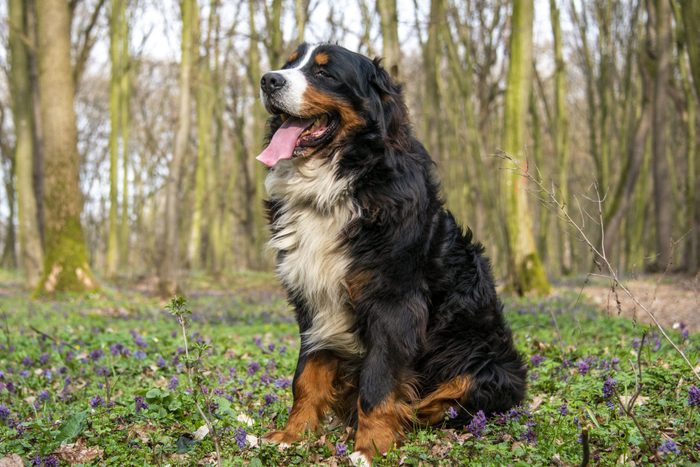
These gentle giants are known for their superlatives: They’re incredibly friendly and loving with their families, they absolutely love to play, they’re amazing with children and other dogs … and they shed like crazy. Historically, that heavy double coat protected Berners from Switzerland’s Alpine winters, and now, their longish black coat with white and red accents makes them stand out as dignified yet lovable hunks.
Because of their high energy levels, Berners do best when they have daily exercise or room to run around, after which they’ll be content to lounge or snuggle with their families. As goofy and friendly as these pups are, they can also be a handful due to their size and exuberance—it’s important to obedience-train them early so they don’t jump up on or accidentally clobber anyone when greeting them.
12. Bouvier des Flandres
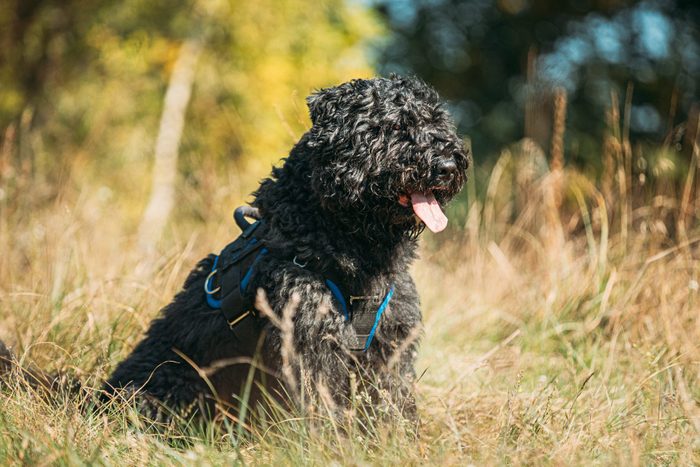
If black bears had pointy ears, you might mistake them for Bouviers, the furballs of the Flanders region of Northern Europe. Bred for farm chores that might have included herding, pulling carts and even turning butter churns, this breed is still known for its loyalty and intelligence. Like other herding and working breeds, Bouviers need a job that provides mental and physical stimulation. They’re great at herding and carting, and respond well to routine and consistency. For that reason, these fluffy pups need a human companion who can give them lots of time and attention—as well as nearly daily brushing for that thick, rough double coat. The AKC notes that Bouviers are strongly prey-driven, so they might need some training that includes impulse control.
13. Old English sheepdog
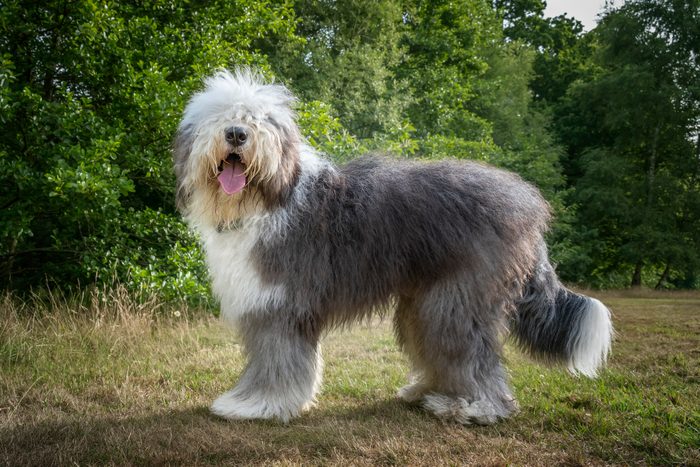
Sure, you probably won’t mistake that giant bundle of fur bounding toward you for a bear, but that’s only because it’s the wrong color! These giant pups with fluffy gray and white coats are known for their distinctive rolling gait, which resembles that of a bear on the run, as well as for being incredibly affectionate and loyal, especially with small children. The shepherding days of the Old English sheepdog (OES) may be behind them, but they’ll still watch over and defend their flock, making these sturdy pups the perfect combination of watchdog and playful family pet.
That gorgeous coat comes with a lot of work, though. OESes require nearly daily brushing or their long hair will quickly get matted. They can also make a mess when outside (think mud puddles!), so you’ll want to train them early to stay off furniture—at least until you’ve had a chance to clean them up.
14. Leonberger
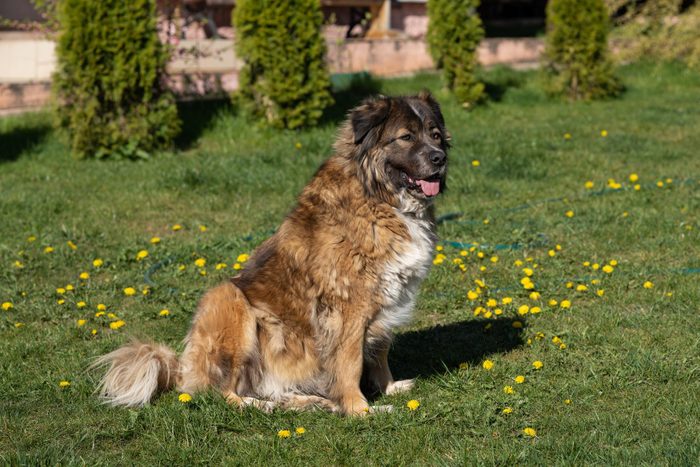
This relatively rare German dog breed was developed in the 19th century (ironically, to look like lions!) but almost didn’t survive the 20th—Leonbergers were nearly wiped out twice in the two world wars. Today, the AKC-recognized breed is known for its affectionate ways, openness to strangers and compatibility with children … a far cry from when these brave dogs were put to work pulling ammunition carts in World War II. Leos are still eager to please, and they do best when trained as young puppies and given mentally and physically stimulating tasks, such as daily hikes and retrieval games.
Their long double coats, which range from sand-colored to rusty brown, require near-daily grooming with a metal comb and slicker brush. Also keep in mind that Leos run large—males can reach up to 170 pounds, and females can weigh 140.
15. Estrela mountain dog
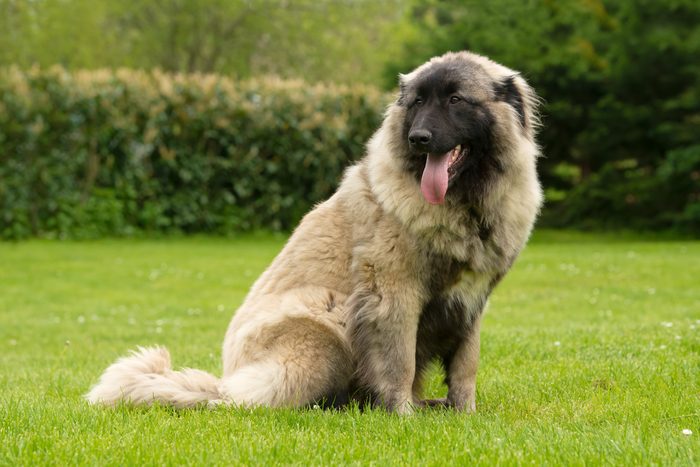
With its dark mask and serious expression, the Estrela mountain dog really does resemble a bear. This Portuguese breed was developed for guarding livestock, and that need to protect is still one of its key traits: Estrelas are generally friendly family dogs—unless someone or something threatens their pack. The Portuguese military has actually used these dogs in firefighting, as well as in army and navy jobs, according to their breed club. Because of the Estrela’s strong-willed, protective nature, experts say this breed is best suited to owners who can be present, patient and consistent, making sure to socialize their Estrela puppy, including with small animals, while it’s still young.
And that long, wavy double coat? It does need regular brushing and combing, and it sheds a lot twice a year—but it’s worth it for its snuggle value. Another interesting trait: All Estrelas have double dewclaws.
Why trust us
At Reader’s Digest, we’re committed to producing high-quality content by writers with expertise and experience in their field in consultation with relevant, qualified experts. For this piece, Elizabeth Heath tapped her experience researching and writing about dog breeds and behavior, and then Caroline Coile, PhD, an award-winning journalist specializing in canine breeds, health and science, gave it a rigorous review to ensure that all information is accurate and offers the best possible advice to readers. We verify all facts and data, back them with credible sourcing and revisit them over time to ensure they remain accurate and up to date. Read more about our team, our contributors and our editorial policies.
Sources:
- American Kennel Club: “Dog Breeds”
- Bouvier des Flandres Club of Great Britain: “History of the Breed”
- Great Pyrenees Club of America: “Breed Info/History”
- Newfoundland Club of America: “Search and Rescue Dogs in World War II”
- Pomeranian.org: “Summer Pomeranian Care”
- United States Eurasier Club: “Eurasier Health”
The most popular dog breeds are often small and adorable. In fact, miniature dogs make some of the best apartment dogs, purely because they don’t take up too much room. Toy dog breeds are so portable, you can take them just about anywhere without too much fuss. They may love being carried in totes while out on the town or in backpacks while you hike the trails.
We spoke to two veterinary experts, Alena Rice, DVM, and Matthew McCarthy, DVM, to compile this list of dainty dogs. Ahead, you’ll find the cutest little pups considered toy dog breeds. Just beware: They’re so small you might want to get more than one!
Get Reader’s Digest’s Read Up newsletter for more pets, cleaning, humor, travel, tech and fun facts all week long.
About the experts
Reviewed for accuracy by: Caroline Coile, PhD, an award winning journalist specializing in canine breeds, health and science. She’s the author of 34 books, including Barron’s Encyclopedia of Dog Breeds. |
What is a toy dog breed?
We know you’re excited to see the cute small dogs we’ve rounded up, but there are a few things you should know about toy dog breeds first. For starters, they’re short and lightweight. “A toy breed typically refers to a very small dog, typically weighing less than 14 to 18 pounds,” says veterinarian Alena Rice, DVM, medical director of VCA Chicago North Animal Hospital. “However, different kennel clubs have different breeds in their toy category.”
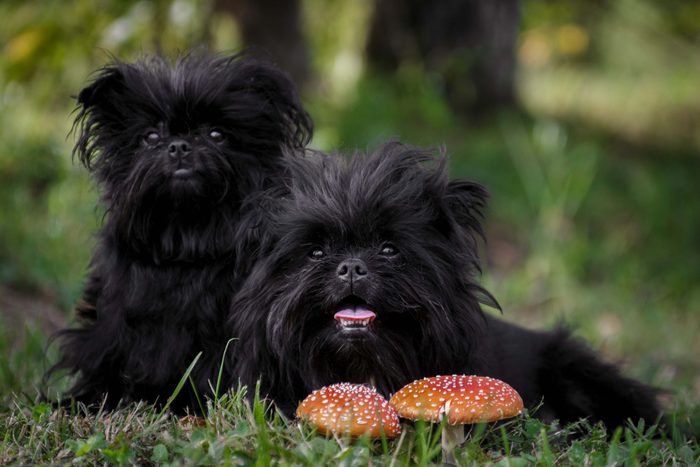
The American Kennel Club (AKC), for instance, lists the affenpinscher in the toy category, while the United Kennel Club classifies it as a companion dog breed. To add to the confusion, “the Merck Veterinary Manual says toy dog breeds are those that weigh less than 10 pounds,” says veterinarian Matthew McCarthy, DVM, founder of Juniper Valley Animal Hospital in Middle Village, New York.
“Perhaps another way to look at this is that toy dog breeds are a group of dogs that are small in stature and bred solely for their perceived attractiveness and companionship as opposed to having practical skills, such as pointing or retrieving,” says Dr. McCarthy. And when it comes to companionship, some toy breeds are known for being super affectionate and cuddly dogs.
Toy dog breeds are slightly bigger than teacup dogs, which of course, can’t really fit in teacups! (It’s just a term used to describe unusually small members of an already small breed.)
Are toy breeds healthier than other breeds?
All dog breeds are susceptible to different diseases. Brachycephalic dogs, such as the pug and bulldog, have short snouts, which makes them more prone to breathing issues and heat stroke. And Cavalier King Charles spaniels are predisposed to mitral valve heart disease, according to Dr. Rice.
As for the healthiest, “based on my experience, I would call out the Havanese and miniature pinscher as the least problematic,” says Dr. McCarthy. The Coton de Tulear, also on our list, is relatively free of genetic health issues, per the AKC. Don’t forget—those tiny chompers are part of the health factor too. Dr. McCarthy says periodontal issues are common in all toy breeds, so start dental care early.
Do toy breeds live longer than other breeds?
“In most of the animal kingdom, longevity increases with body size. For example, a mouse lives about 18 months, while an elephant can live for 90 years. However, with dogs, longevity decreases with increased body size,” says Dr. McCarthy.
That’s why toy poodles may live well into the teens, but Great Danes rarely live past 10 years of age. It is unknown why small dog breeds live longer, but some research has found that, statistically speaking, larger dogs do in fact live shorter lives than smaller breeds, says Dr. Rice. Read on to learn more about the most popular toy dog breeds.
Toy American Eskimo
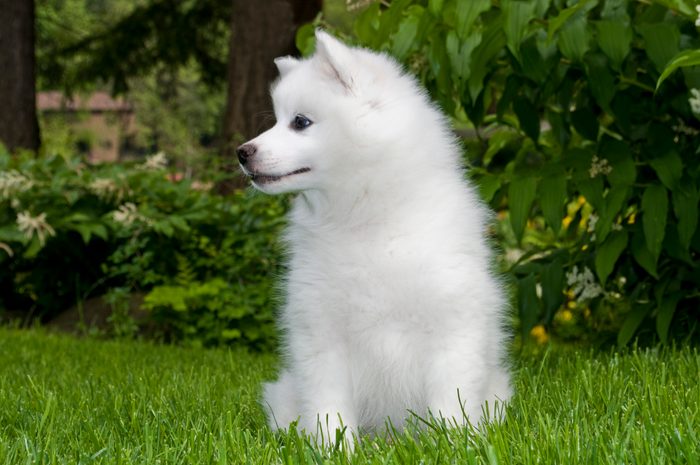
Here’s a shocker: The American Eskimo dog doesn’t come from the frozen tundras of Alaska. Eskie’s, as they are known by adoring fans, originally hail from Germany. They’re undeniably cute, playful, perky and quick at learning tricks. They tend to be protective, with herding in their genes, but never in an I’ll nip your feet kind of way. And that goes for the miniature and standard varieties of Amerian Eskimos.
| Breed overview | |
| Height: | 9 to 12 inches |
| Weight: | 6 to 10 pounds |
| Life expectancy: | 13 to 15 years |
Toy poodle
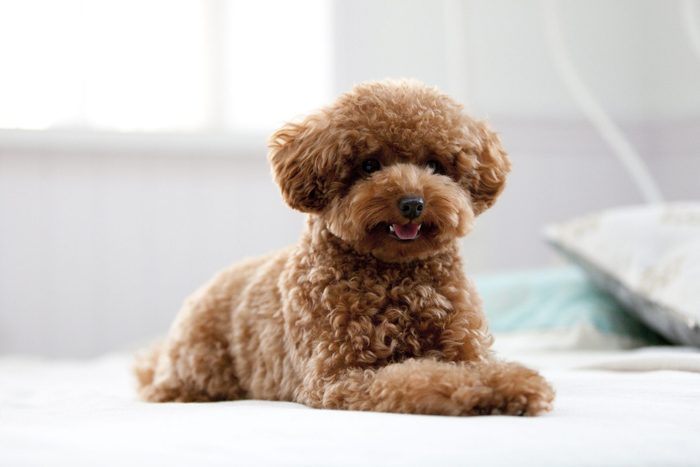
If you’re looking for adorable dog breeds that look like teddy bears, these fluffy little nuggets are about the same size as a stuffed animal but much more cuddly and a whole lot more fun to play with. Maxing out at around 5 pounds and less than 10 inches tall, they’re just as portable as your favorite teddy. They’ll be your devoted sidekick for years.
“Many toy poodles live to their upper teens. I’ve even seen some 24-year-old toy poodles,” says Dr. McCarthy. The toy is the smallest of the poodle breed; next is the miniature, at 10 to 15 inches tall, and the standard, at about 15 inches tall.
| Breed overview | |
| Height: | Up to 10 inches |
| Weight: | 4 to 6 pounds |
| Life expectancy: | 10 to 18 years |
Shih poo
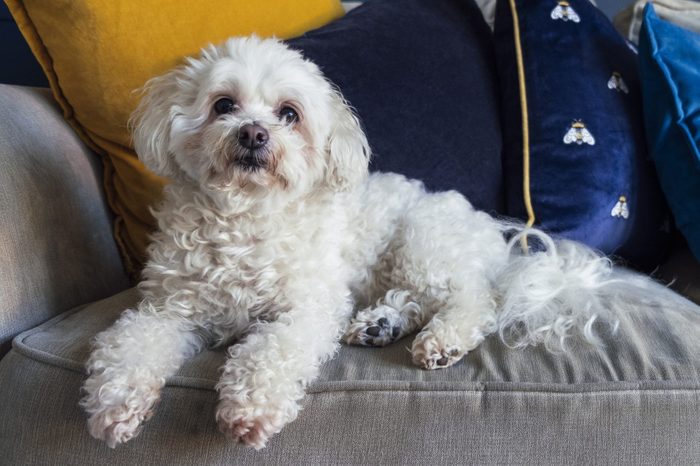
If the name didn’t give it away already, we’ll let you in on a secret: The shih poo is a mixed-breed dog—a cross between a shih tzu and a poodle that’s among the cutest dogs that stay small. You’re getting the best of both doggie genes here: the super-affectionate and charming traits of the shih tzu and the playful, comedic, smarty-pants personality of the poodle. Bonus: Both breeds tend to shed less than other dogs.
| Breed overview | |
| Height: | 8 to 15 inches |
| Weight: | 7 to 20 pounds |
| Life expectancy: | 13 to 17 years |
Maltese
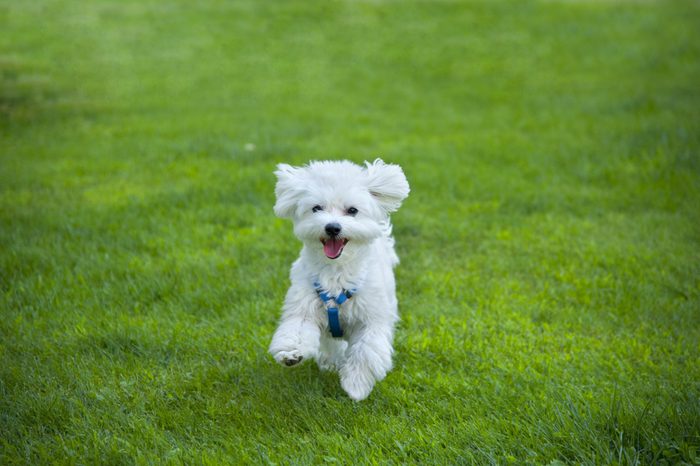
With those expressive eyes and outgoing, spunky personalities, you would have to have a heart made of coal to resist this lovable miniature dog. “Maltese are typically affectionate and charming, and they make both good watchdogs and athletes,” says Dr. Rice. The only drawback is that their adorable white fur requires daily brushing to prevent matting. But that just means you get to spend more time with this little angel.
| Breed overview | |
| Height: | 7 to 9 inches |
| Weight: | Under 7 pounds |
| Life expectancy: | 12 to 15 years |
Papillon
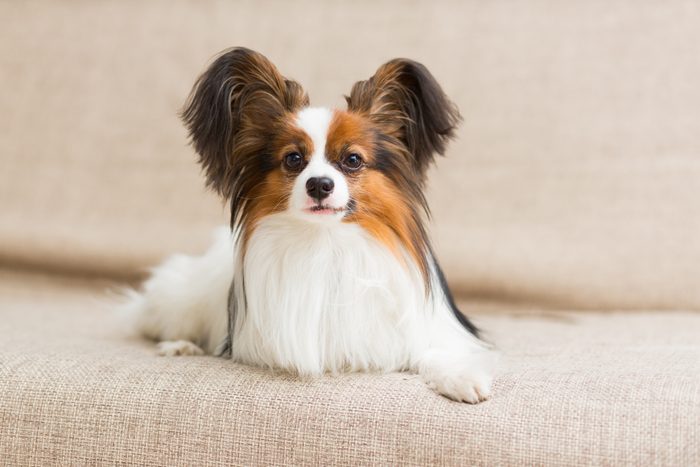
“Papillons are named after the French word for butterfly due to their wing-shaped ears,” says Dr. Rice. “They are dainty and elegant but can also make excellent agility dogs.” They live to flaunt their stellar intelligence and agility while doing obstacle courses and obedience trials.
Fortunately, papillons don’t have to compete outside of the home to be content. Feed their curious and alert minds with puzzle toys and new tricks, and after you’re all done, snuggle those adorable ears.
| Breed overview | |
| Height: | 8 to 11 inches |
| Weight: | 5 to 10 pounds |
| Life expectancy: | 13 to 15 years |
Chiweenie
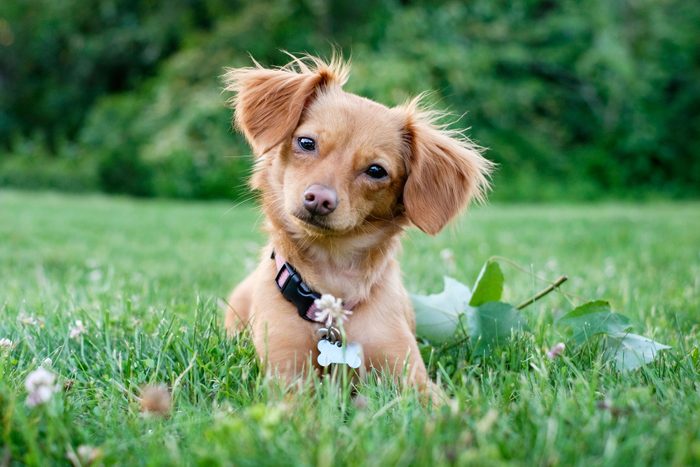
We love this sweet teeny-weenie toy dog breed. Does that give you a clue as to who its parents are? This designer breed mix of a Chihuahua and a dachshund, also known as a choxie, is pocket-size but has a giant personality. Both breeds are known for their spunk and moxie and their fearless loyalty to their favorite humans.
Chihuahuas and dachshunds can be short- or long-haired pups, and chiweenies are the same. Their bodies tend to be shorter and robust, favoring the Chihuahua, with the long and narrow tail of a dachshund.
| Breed overview | |
| Height: | 6 to 10 inches |
| Weight: | 5 to 12 pounds |
| Life expectancy: | 12 to 15 years |
Yorkshire terrier
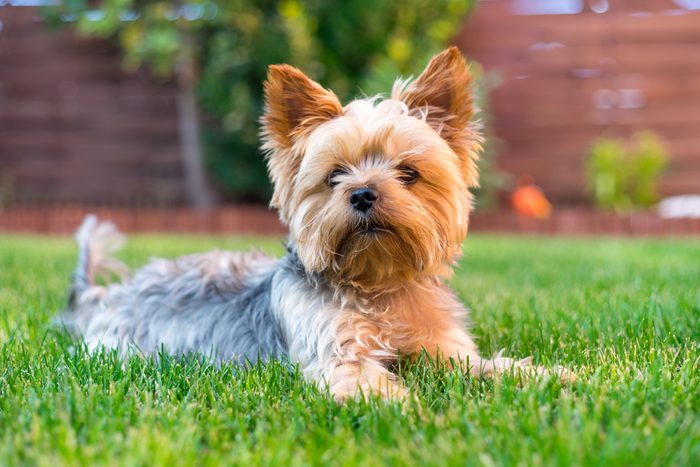
A delightfully sweet and devoted companion you can carry in your tote? Sign us up! Yorkies love to be with their human, and if that means a shopping trip to Nordstrom in a snazzy tote, so be it. Yorkies aren’t likely to trigger allergies or shed too much. They can be little yappers, which really just translates to lively and alert. At least you’ll know when your Amazon order is delivered.
| Breed overview | |
| Height: | 8 to 9 inches |
| Weight: | 4 to 6 pounds |
| Life expectancy: | 13 to 16 years |
Pug
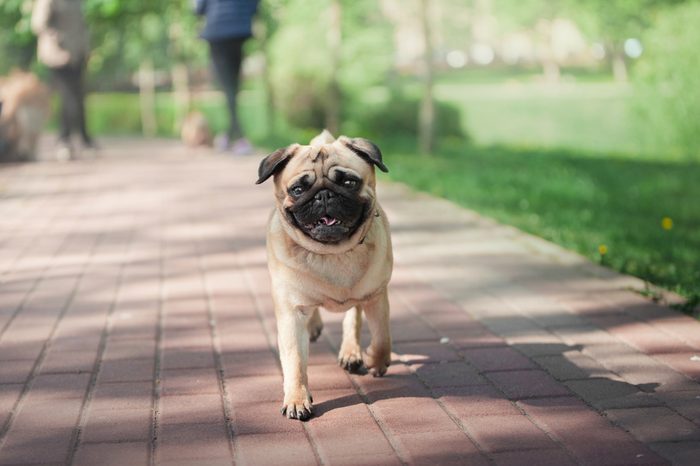
“The pug motto is ‘multum in parvo,’ which translates to ‘a lot in a little,'” says Dr. Rice, and we couldn’t agree more. “They are typically happy and energetic dogs with adorable facial expressions.” And by energetic, we don’t necessarily mean physically. Truth be told, they would rather cuddle than do anything too strenuous. They’re energetic in the sense that they are extroverts—animated and gregarious, making their rounds at gatherings and entertaining the masses.
| Breed overview | |
| Height: | 10 to 13 inches |
| Weight: | 14 to 18 pounds |
| Life expectancy: | 12 to 15 years |
Cavalier King Charles spaniel
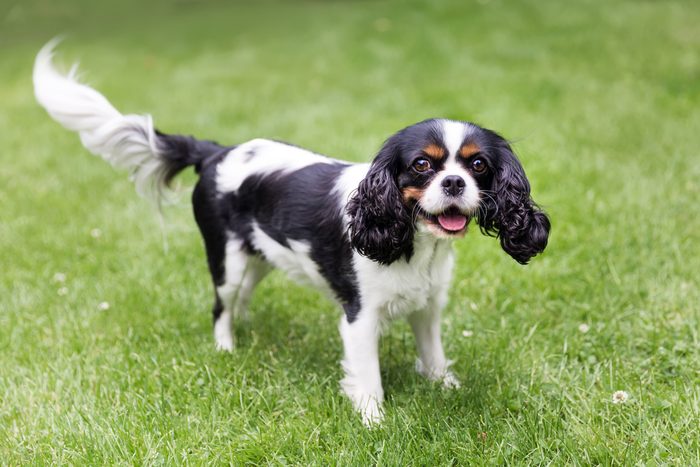
If there were a competition for the most comfort-bestowing toy dog breed, the Cavalier would be hard to beat. They are mild-mannered, and their heartwarming affection knows no limits, nor does their eagerness to please. They easily check off the qualifications for being one of the best dog breeds for emotional support. Yet they can balance being a therapy dog with being a family dog. “They adapt well to their owner’s lifestyle, so they can be very active or lazy couch potatoes,” says Dr. Rice.
| Breed overview | |
| Height: | 12 to 13 inches |
| Weight: | 13 to 18 pounds |
| Life expectancy: | 9 to 14 years |
Havanese
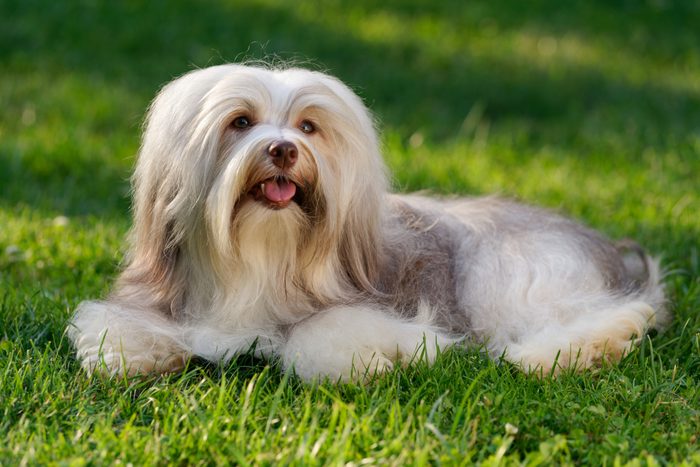
“Havanese are typically born trainable extroverts with silly personalities, and they can be excellent watchdogs,” Dr. Rice says. That’s about the only time they bark, so if you hear them, something’s up. Havanese delight in all kinds of activities, including performing tricks, clowning around and playing with toys. These happy pups don’t shed much, but daily grooming is essential to keep their silky coat smooth.
| Breed overview | |
| Height: | 8.5 to 11.5 inches |
| Weight: | 7 to 13 pounds |
| Life expectancy: | 13 to 15 years |
Pomeranian
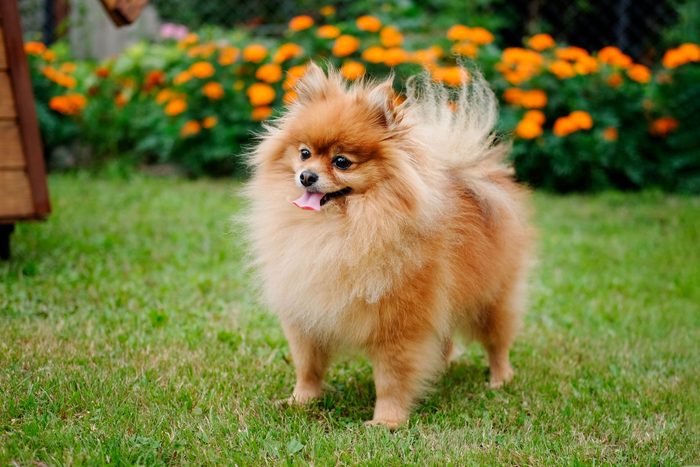
Is this a miniature dog or tiny fox? That tiny, fox-like face is so precious, but as you probably know, Pomeranians are all dog. You can’t help but scoop them up to cuddle. They tend to be headstrong, feisty and sassy, and they love to be the center of attention. Sometimes they’re just playful, but other times they convey their opinions with yapping.
| Breed overview | |
| Height: | 7 to 12 inches |
| Weight: | 3 to 7 pounds |
| Life expectancy: | 12 to 16 years |
Brussels griffon
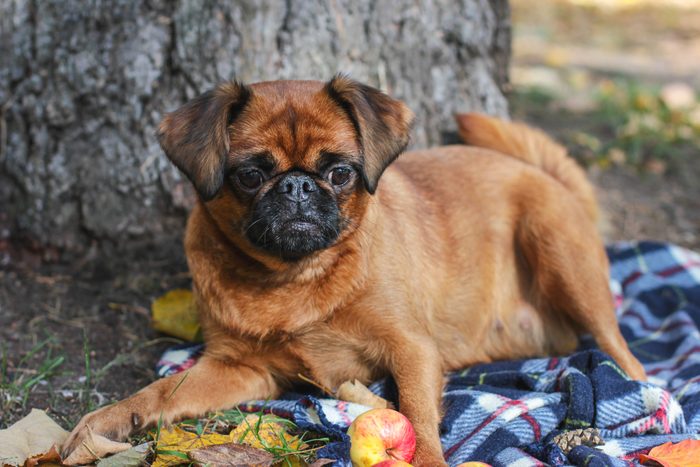
Griffs can be demanding, assertive and full of self-importance, but it’s just their way of saying they want to be as close as possible to you, whether you’re on the sofa, sleeping, making dinner or going to the bathroom. They don’t like to be left alone at home, and if they are, they will probably bark their complaints for all the neighbors to hear.
| Breed overview | |
| Height: | 7 to 8 inches |
| Weight: | 7 to 12 pounds |
| Life expectancy: | 10 to 15 years |
Cavachon
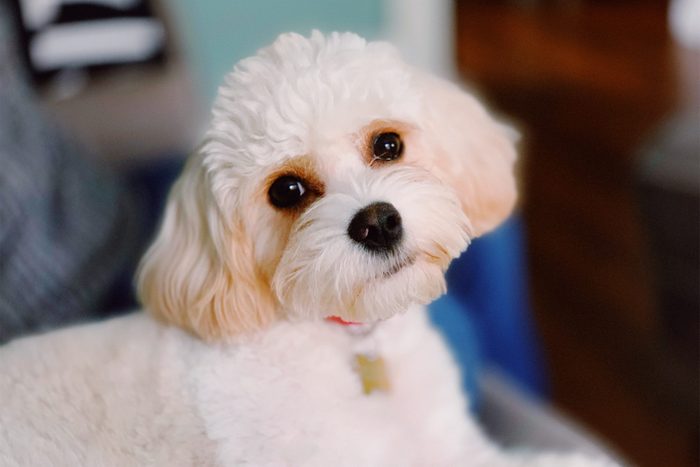
The Cavachon is a super-cute mixed dog breed whose parents are a Cavalier King Charles spaniel and bichon frise. The parent breeds are part of the AKC toy and nonsporting groups, and their combined genetics create a sweetheart of a pooch oozing with an affectionate, sensitive and gentle nature. That doesn’t mean they’ll be all-day lap loungers, though. They like to mingle and play with humans and other animals too.
| Breed overview | |
| Height: | 12 to 13 inches |
| Weight: | 15 to 35 pounds |
| Life expectancy: | 10 to 15 years |
Shih tzu
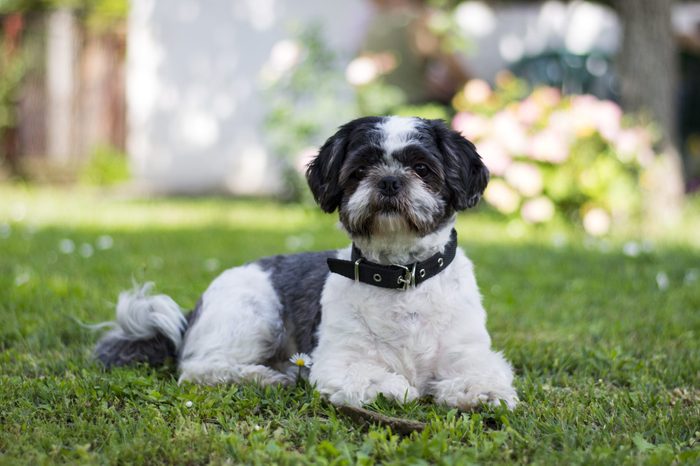
A strong independent streak might not make shih tzus stellar students when learning new commands, but their stubborn attitude is so stinkin’ adorable, you can’t help but forgive them. And really, can you blame them? Initially bred to be companion dogs, their doting and fondness for human attention come naturally. If it were up to the shih tzu, it would skip obedience school and meet new friends at the dog park.
| Breed overview | |
| Height: | 9 to 10.5 inches |
| Weight: | 9 to 16 pounds |
| Life expectancy: | 10 to 16 years |
Affenpinscher
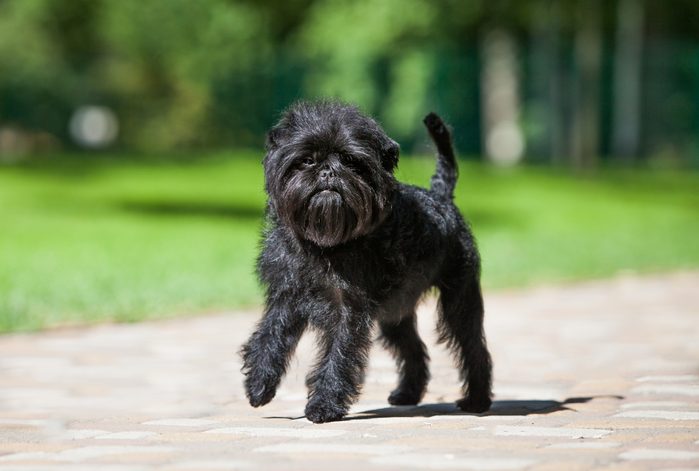
We’re fairly certain affenpinschers have been stand-ins for Wookies and Ewoks in Star Wars movies. Just look at that coat and the scrunched-up face! It’s a bewildering mix of neat and messy, and yet affenpinschers are one of the toy dog breeds that don’t shed too much. They show loyalty and warm affection but are not submissive. In fact, they consider themselves fluffy versions of humans, though they’re probably the only friends inquisitive and fearless enough to lick your face.
| Breed overview | |
| Height: | 9.5 to 11.5 inches |
| Weight: | 7 to 9 pounds |
| Life expectancy: | 12 to 14 years |
Chihuahua
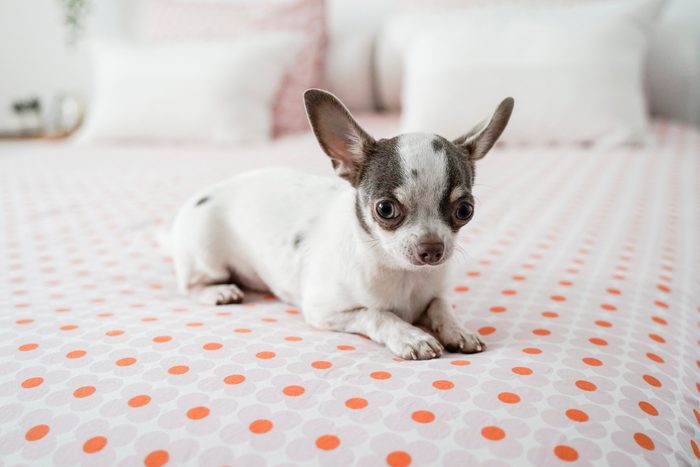
All dogs are individuals, but some toy breeds might be more suspicious or scared of humans and compensate for their small stature by being nippy. “Chihuahuas can go either way—when they’re nice, they are amazingly sweet, but if they have the grumpy gene, look out,” says Dr. McCarthy. “I have more scars from Chihuahuas than I do from other breeds.” Chihuahuas are not actually mean. They’re just saucy and feisty, and we wouldn’t have it any other way.
| Breed overview | |
| Height: | 6 to 9 inches |
| Weight: | 2 to 6 pounds |
| Life expectancy: | 12 to 20 years |
Miniature pinscher
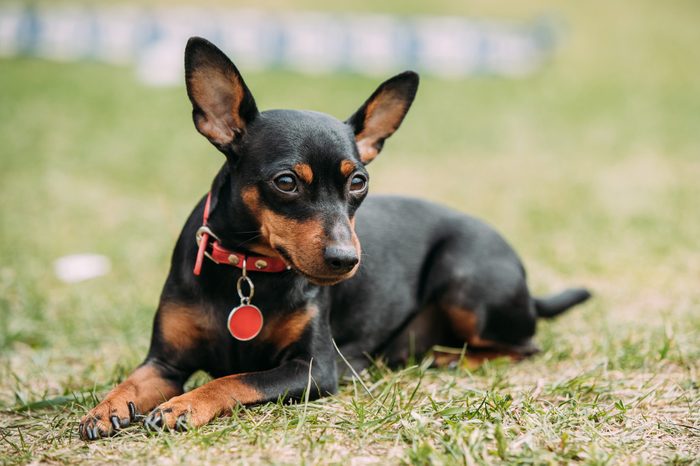
We know what you’re thinking. We thought it too. The miniature pinscher is clearly a pint-size version of the Doberman pinscher, right? One of the teeniest toy dog breeds, also known as the min-pin, would be the first to correct you. Breed historians believe the miniature pinscher may actually be a mix between an Italian greyhound and a dachshund.
Oddly enough, it’s dubbed the King of Toys even though it’s just a foot tall and weighs about 10 pounds. We can see that in its confident and courageous personality as well as its stately sleek and shiny coat, high-perched ears, and expressive eyes.
| Breed overview | |
| Height: | 10 to 12.5 inches |
| Weight: | 8 to 11 pounds |
| Life expectancy: | 15 years |
Pekingese
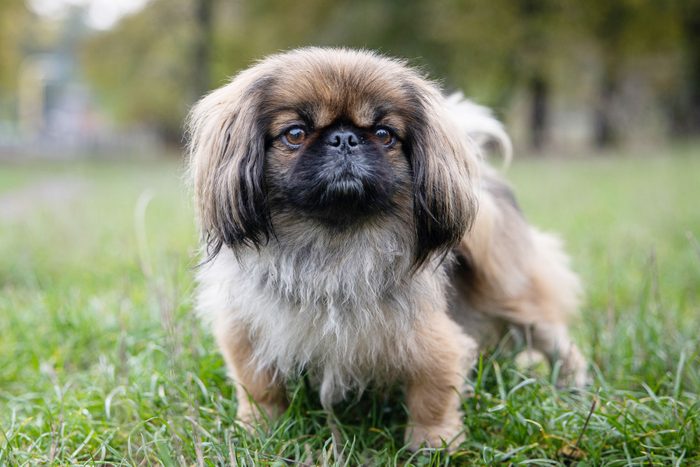
Will you be a dear and fetch me my royal treats? The Pekingese is a honey of a toy breed that exudes a dignified manner with a dash of aloofness. Back in the day, they were royal lap sitters. They’re easygoing and have layers upon layers of snuggle-worthy luxurious fur.
| Breed overview | |
| Height: | 6 to 9 inches |
| Weight: | 7 to 14 pounds |
| Life expectancy: | 12 to 14 years |
Biewer terrier
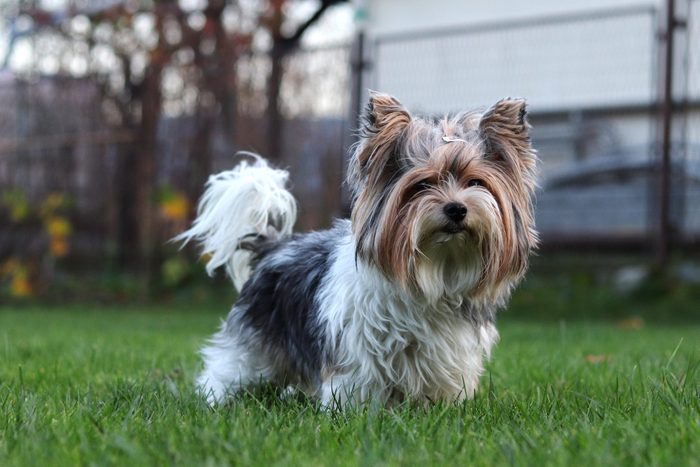
Cute as a button, the Biewer (pronounced “beaver”) is a calm dog breed with an irresistibly cute, angelic face and a charming little smile. Biewers make friends effortlessly with their outgoing and whimsical personalities. Dainty and precious is their vibe, but in truth, they are surprisingly athletic and relish long walks and agility competitions. The AKC recognized the Biewer in 2021 as a member of the toy group.
| Breed overview | |
| Height: | 7 to 11 inches |
| Weight: | 4 to 8 pounds |
| Life expectancy: | 12 to 15 years |
Toy fox terrier
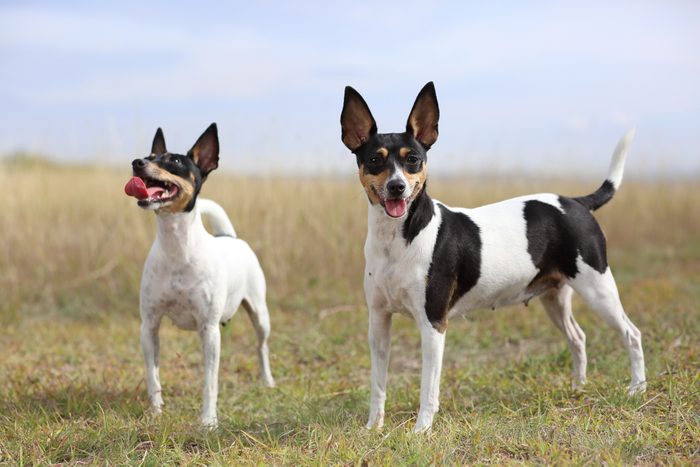
Just how tiny is the toy fox terrier? It weighs between 4 and 6 pounds and ranges from 8 to 11 inches tall. A teensy package loaded with character, the toy fox is an unlikely combination of a sweet and loving lap dog and a tenacious terrier. Always in pursuit of something fun, they’ll need you to bring your A-game—or they could become mischievous.
| Breed overview | |
| Height: | 8.5 to 11.5 inches |
| Weight: | 3.5 to 7 pounds |
| Life expectancy: | 13 to 14 years |
Coton de Tulear
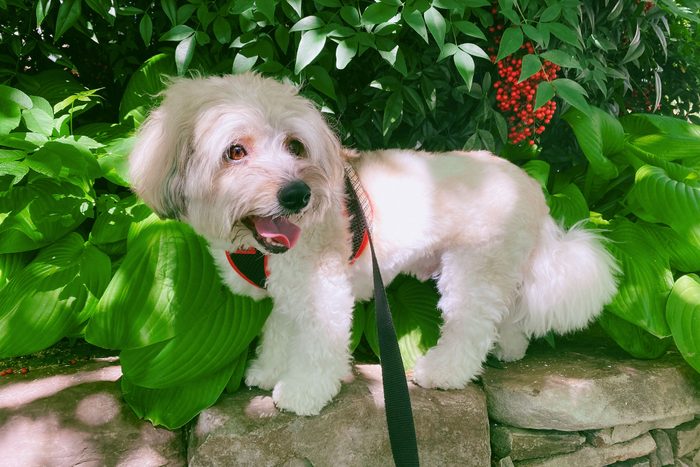
Fluffy but not stuffy, the Coton de Tulear (KO-Tone Dih TOO-Lay-ARE) is a happy-go-lucky pup with the cutest smile you ever did see. Then there’s that alluring cottony-soft coat you could cuddle for hours. But as much as the Coton de Tulear loves a good snuggle session, it needs creative outlets for its sometimes boisterous clownish antics. These dogs covet playtime with you, along with lots of interesting and challenging toys and games. You’ll have plenty of years together because the Coton de Tulear is one the longest-living dog breeds.
| Breed overview | |
| Height: | 9 to 11 inches |
| Weight: | 8 to 15 pounds |
| Life expectancy: | 15 to 19 years |
Russian Tsvetnaya Bolonka
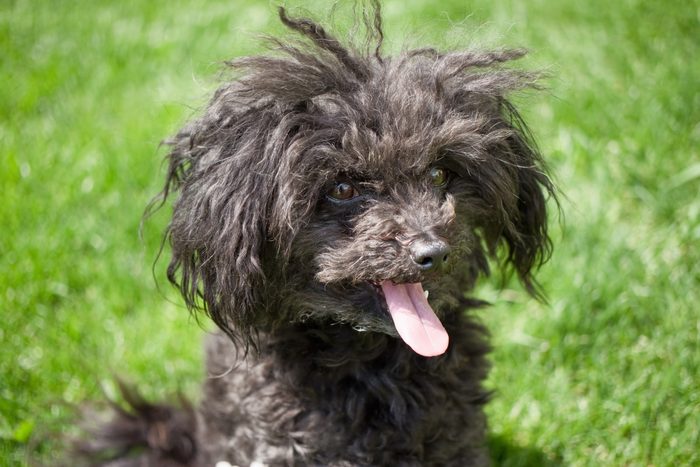
One of the most charming, spirited and clever toy dog breeds with a hard-to-pronounce name (Svet-NE-ya Bo-LON-ka), the Russian Tsvetnaya Bolonka is one of those rare dog breeds you probably haven’t heard of before. But now that you know it, you’ll want one for yourself.
This sweet little pup is chummy with everyone and turns strangers into fast friends with just one look. The Russian Tsvetnaya Bolonka is more lap dog than athlete. Still, every dog needs daily exercise. A walk around the block, playtime in a fenced yard or a trip to the dog park should suffice.
| Breed overview | |
| Height: | 8 to 12 inches |
| Weight: | 4 to 12 pounds |
| Life expectancy: | 12 to 16 years |
Japanese Chin
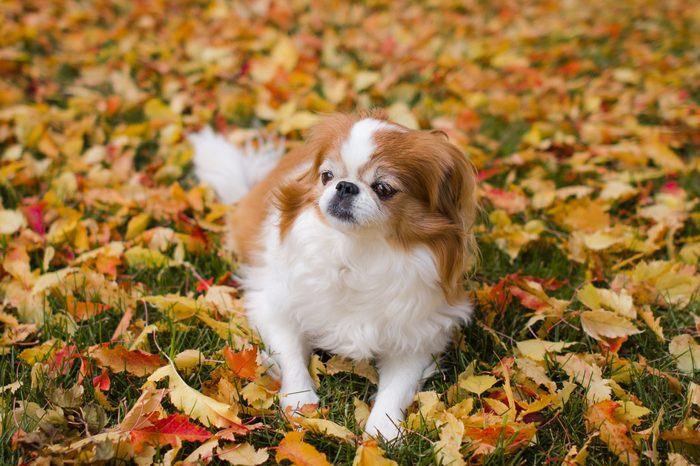
The Japanese Chin struts about with swagger and self-importance, and we’re not about to call them out on it. This Japanese dog knows it has a coat to be envied—that long, luscious fur covering its backside and heavenly feathering on its legs and ears are Instagram-worthy. Interestingly enough, Japanese Chins share some traits with cats. They’re meticulous groomers, a bit aloof and persnickety. They’ll claim their favorite spot on the sofa but are more than happy to share it if you lavish them with some love.
| Breed overview | |
| Height: | 8 to 11 inches |
| Weight: | 7 to 11 pounds |
| Life expectancy: | 10 to 12 years |
Norwich terrier
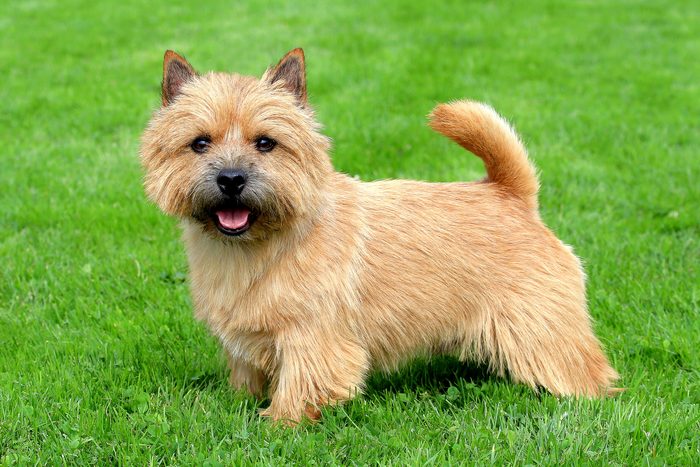
Portable and adorable? How can you turn down this honey of pup that you can take anywhere? At just 10 pounds, the Norwich terrier is ready to travel anywhere in the city or country. This breed loves to take in its surroundings and interact with other people, satisfying its curious nature with fun and active things to do. Agility games, flyball and playing at the dog park expend enough energy to wear them out for cuddle time later.
| Breed overview | |
| Height: | 10 inches |
| Weight: | 12 pounds |
| Life expectancy: | 12 to 15 years |
Chorkie
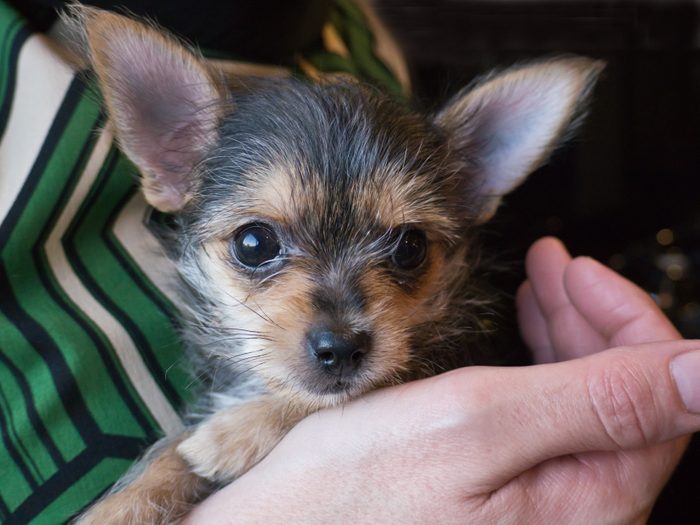
Another tiny crossbreed, the chorkie is born of a Chihuahua and a Yorkshire terrier. And it’s pretty apparent after spending a little bit of time with one that the breed has acquired the lively, spunky and sassy nature of its parents. Both breeds tend to be wary of strangers, but that’s probably due to their undying loyalty to their favorite humans. They love their humans with all their might and aren’t crazy about outsiders horning in on their territory.
| Breed overview | |
| Height: | 6 to 9 inches |
| Weight: | 8 to 15 pounds |
| Life expectancy: | 10 to 15 years |
Cesky terrier
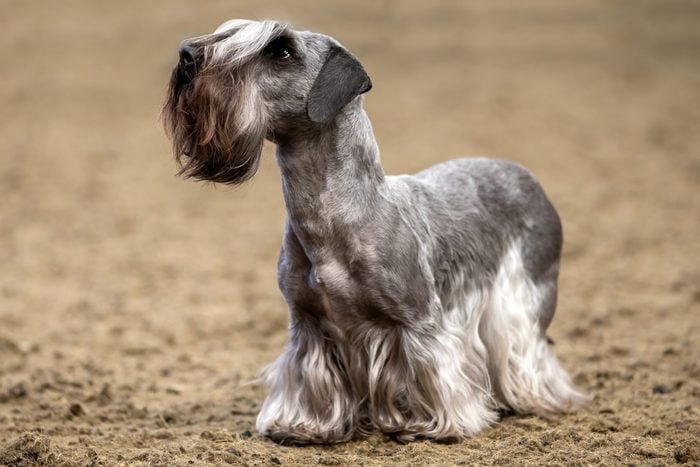
Years ago, most terriers were bred to hunt and kill rodents and other small critters. Terriers today are more about play than hunting but retain a deep-seated independent streak and loads of energy—think zoomies times 100 and a bit of naughtiness—except the Cesky terrier. Its dignified appearance doesn’t exactly lend itself to excitedly running around. It’s a bit more mellow, cooperative and easy to train, and it’s a wonderful family dog.
| Breed overview | |
| Height: | 10 to 13 inches |
| Weight: | 13 to 24 pounds |
| Life expectancy: | 12 to 15 years |
Bichon frise
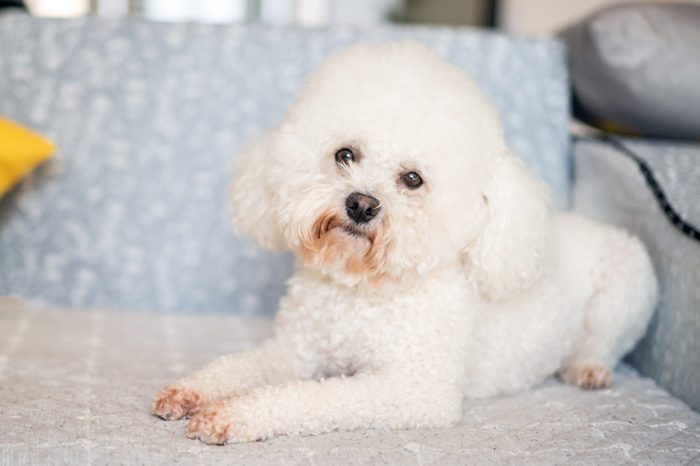
The name says it all: Bichon is the French word for “lap dog” and frise is French for “curly.” We just call them precious balls of fluffy goodness. You’ll never see any other color but white on a bichon. Nor will you see too much fur on your floor. Their hair doesn’t shed, and their skin doesn’t produce much dander, which is good news for people who have allergies. Like humans, they’ll need haircuts via regular groomer visits. As for the pup’s temperament, bichons are as sweet as the day is long.
| Breed overview | |
| Height: | 9.5 to 11.5 inches |
| Weight: | 12 to 18 pounds |
| Life expectancy: | 14 to 15 years |
Toy Manchester terrier
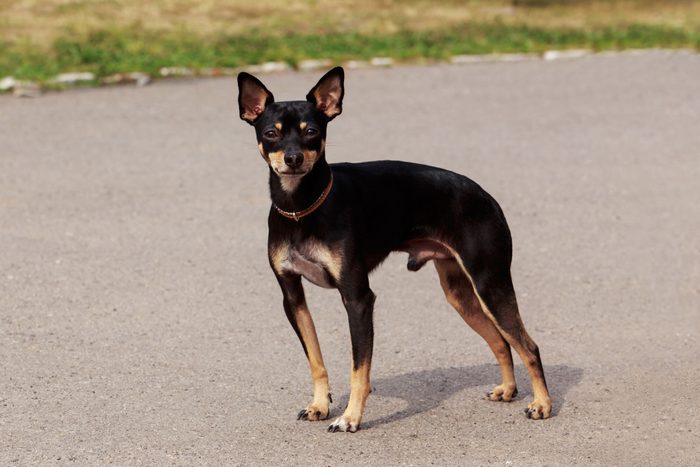
While the standard Manchester terrier may be slightly bigger than your average small dog breed, the toy version is absolutely perfect for hands-on pet parents. The small size makes them great companion dogs, which are known for loyalty and alertness. These toy dog breeds are also great for rooting out pests, perfect if you’ve been dealing with a pesky mouse problem at home.
| Breed overview | |
| Height: | 10 to 12 inches |
| Weight: | Up to 12 pounds |
| Life expectancy: | 15 to 17 years |
Border terrier
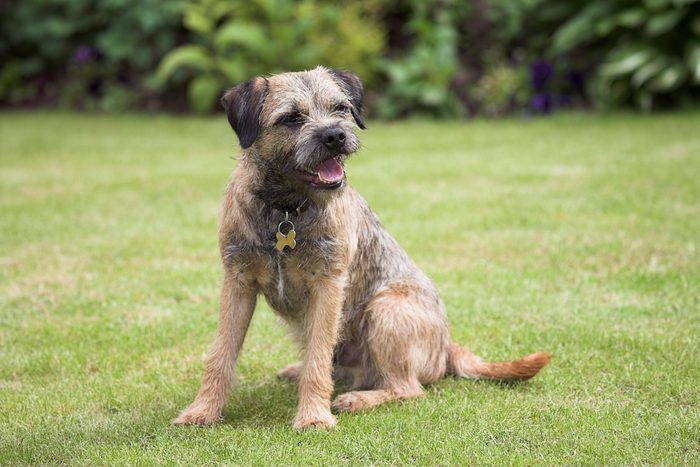
Border terriers aren’t technically a toy breed, but they will remain small throughout their lives. They’re both affectionate and athletic small dogs that need a lot of exercise. Their wiry coat is also low maintenance. Male and female border terriers have slightly different size ranges, but you can expect this happy-go-lucky dog to maintain a healthy adult weight under 15 pounds, which is just perfect for snuggling in an adult’s lap. They’re also fiercely loyal and protective, making them excellent family members.
| Breed overview | |
| Height: | 12 to 15 inches |
| Weight: | 11 to 15 pounds |
| Life expectancy: | 12 to 15 years |
Cairn terrier
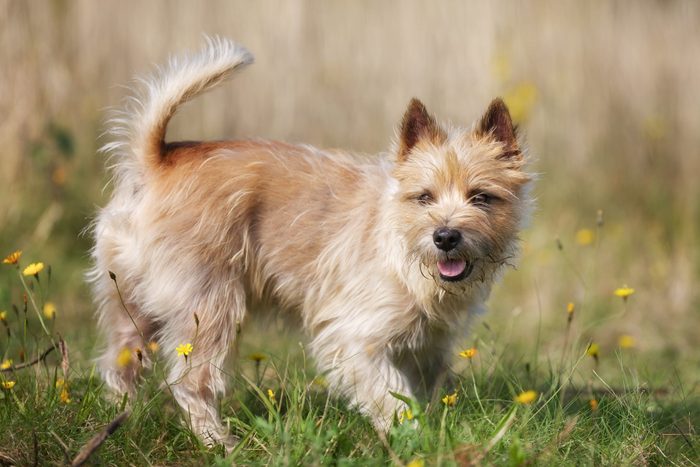
Although they’re not always classified as toy dog breeds, cairn terriers are small, snuggly and smart lap dogs that will stay small. They have wiry coats and enjoy being around their families—your pup will want to hop into your lap and be around you as much as possible. They are also athletic dogs that need daily walks and bouts of play.
| Breed overview | |
| Height: | 10 inches |
| Weight: | 13 to 14 pounds |
| Life expectancy: | 13 to 15 years |
Miniature dachshund
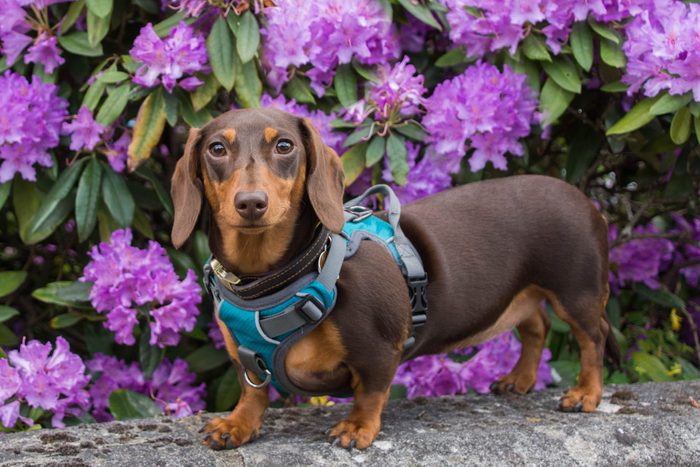
If you’re looking to be the talk of the local pet meetup club, consider this incredibly sweet small dog breed that is often compared to a popular ballpark snack. Miniature dachshunds, a smaller size category of the dachshund breed, are affectionate, intelligent and athletic. They are perfect for a wide range of pet parents, from families with children to child-free older adults. They’re easily trained and love to play and go for walks. Plus, their small size makes them easy to carry around. Because the gene that causes those cute dwarfed legs also causes the spinal discs to be brittle, these dogs can develop back problems.
| Breed overview | |
| Height: | 5 to 6 inches |
| Weight: | Up to 11 pounds |
| Life expectancy: | 12 to 16 years |
Why trust us
At Reader’s Digest, we’re committed to producing high-quality content by writers with expertise and experience in their field in consultation with relevant, qualified experts. For this piece, Lisa Marie Conklin tapped her experience covering pet behavior and training, and then Caroline Coile, PhD, an award winning journalist specializing in canine breeds, health and science, gave it a rigorous review to ensure that all information is accurate and offers the best possible advice to readers. We verify all facts and data, back them with credible sourcing and revisit them over time to ensure they remain accurate and up to date. Read more about our team, our contributors and our editorial policies.
Sources:
- Alena Rice, DVM, veterinarian and medical director of VCA Chicago North Animal Hospital
- Matthew McCarthy, DVM, veterinarian and founder of Juniper Valley Animal Hospital in Middle Village, New York
- American Kennel Club: “Dog Breeds”
Arrayskyword_tracking_tag[/c


